Ariston Clas ONE 30 User Manual
Displayed below is the user manual for Clas ONE 30 by Ariston which is a product in the Water Heaters & Boilers category. This manual has pages.
Related Manuals
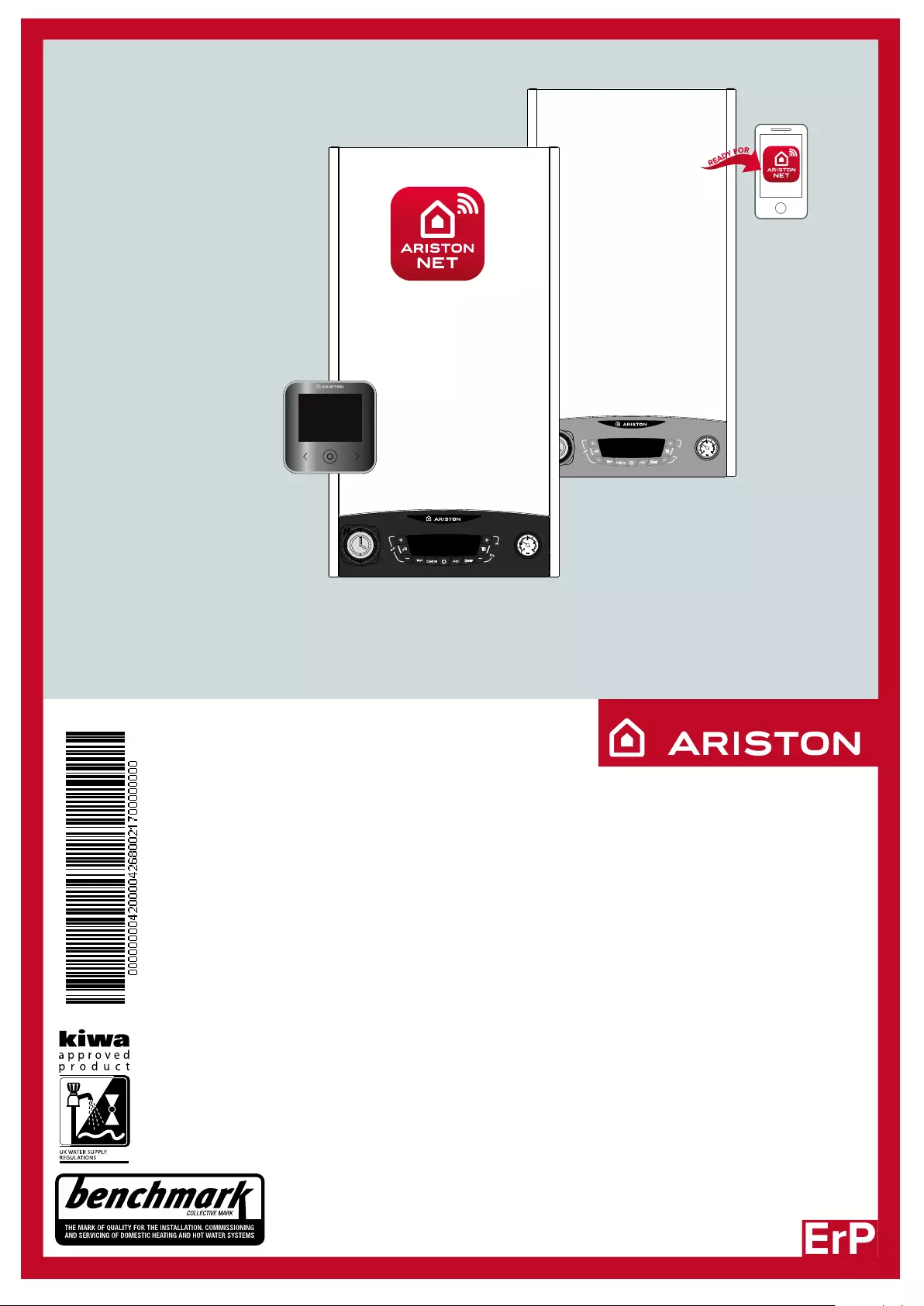
CONDENSING WALL-HUNG GAS BOILER
Country of Destination: GB/IE
G.C.N.: 47-116-88 (24 kW)
G.C.N.: 47-116-89 (30 kW)
G.C.N.: 47-116-90 (38 kW)
G.C.N.: 47-116-85 (24 kW)
G.C.N.: 47-116-86 (30 kW)
G.C.N.: 47-116-87 (38 kW)
G.C.N.: 41-116-49 (18 kW)
G.C.N.: 41-116-50 (24 kW)
G.C.N.: 41-116-51 (30 kW)
INSTALLATION AND SERVICING INSTRUCTIONS
HOT WATER I HEATING I RENEWABLES
CLAS NET One
CLAS One
CLAS SYSTEM One
discover more
@ariston.com

INDEX
Overview ............................................................................................3
General Information ........................................................................4
Advice for the Installer....................................................................4
CE Labelling ......................................................................................4
Data Plate Symbols .........................................................................4
Safety Regulations ..........................................................................5
Product description ........................................................................7
Control Panel ....................................................................................7
Display ................................................................................................8
Overall View ......................................................................................9
Overall Dimension .........................................................................10
Minimum Clearances ....................................................................10
Installation ....................................................................................... 11
Reference Standards .....................................................................11
Installing the Boiler ........................................................................ 14
Gas Connection .............................................................................. 15
Water Connection ..........................................................................15
Instructions for Opening the Casing and Performing an
Internal Inspection ....................................................................15
Underoor heating ........................................................................16
Water circuit diagram .................................................................... 17
Connecting the Flue ......................................................................18
Fitting the Coaxial Flue (Ø 60/100 Horizontal) ......................19
Fitting the 5” Flue (Ø 80/125 Horizontal / Vertical) .............. 20
Fitting the Coaxial Flue (Ø 60/100 Vertical) ............................ 21
Fitting the Twin Pipe (Ø 80/80) ..................................................22
Electrical Connections ................................................................. 25
Peripheral Unit Connection ........................................................25
Room Thermostat Connection ...................................................26
Outdoor Sensor Connection ......................................................26
Cylinder connection .....................................................................26
Internal mechanical time clock
Internal RF receiver for Ariston programmable
room thermostat........................................................................ 27
Electrical Diagram ........................................................................28
Commissioning ............................................................................. 32
Initial Preparation .......................................................................... 32
Electricity Supply .......................................................................... 32
Filling the Heating System ......................................................... 32
Filling of the DHW System .......................................................... 32
Gas Supply ..................................................................................... 32
Water Treatment ............................................................................32
First Igniton Operation ................................................................. 33
Ignition procedure ......................................................................... 34
Test Function and Combustion Analysis ................................35
AUTO Function ............................................................................... 37
Boiler Protection Devices .......................................................... 38
Boiler Protection Devices............................................................ 38
Table summarising error codes ................................................. 38
Anti-Frost Device ...........................................................................39
Settings - Adjustment - Problem Identication Menus
Accessing the Menus ................................................................... 40
Maintenance
General Comments ...................................................................... 47
Operational Test ............................................................................ 47
Draining procedures..................................................................... 47
Cleaning the primary exchanger .............................................. 47
Cleaning the trap .......................................................................... 47
Maintenance Guide
General Access ............................................................................. 48
Electrical Unit ................................................................................. 49
Hydraulic Unit ................................................................................52
Burner Unit ...................................................................................... 62
Annual Maintenance .................................................................... 66
Technical Information
Technical Data CLAS ONE / CLAS NET ONE .........................68
Technical Data CLAS SYSTEM ONE ........................................69
ERP Data CLAS ONE / CLAS NET ONE ................................... 70
Product che CLAS ONE / CLAS NET ONE ............................ 70
ERP Data CLAS SYSTEM ONE .................................................... 71
Product che CLAS SYSTEM ONE ............................................. 71
Product che CUBE S NET - CLAS NET ONE ......................... 71
Package Label - Instuctions to lling ....................................... 72
Package che ................................................................................ 74
Benchmark Commissioning Checklist .....................................77
Benchmark Service Interval Record ........................................ 78
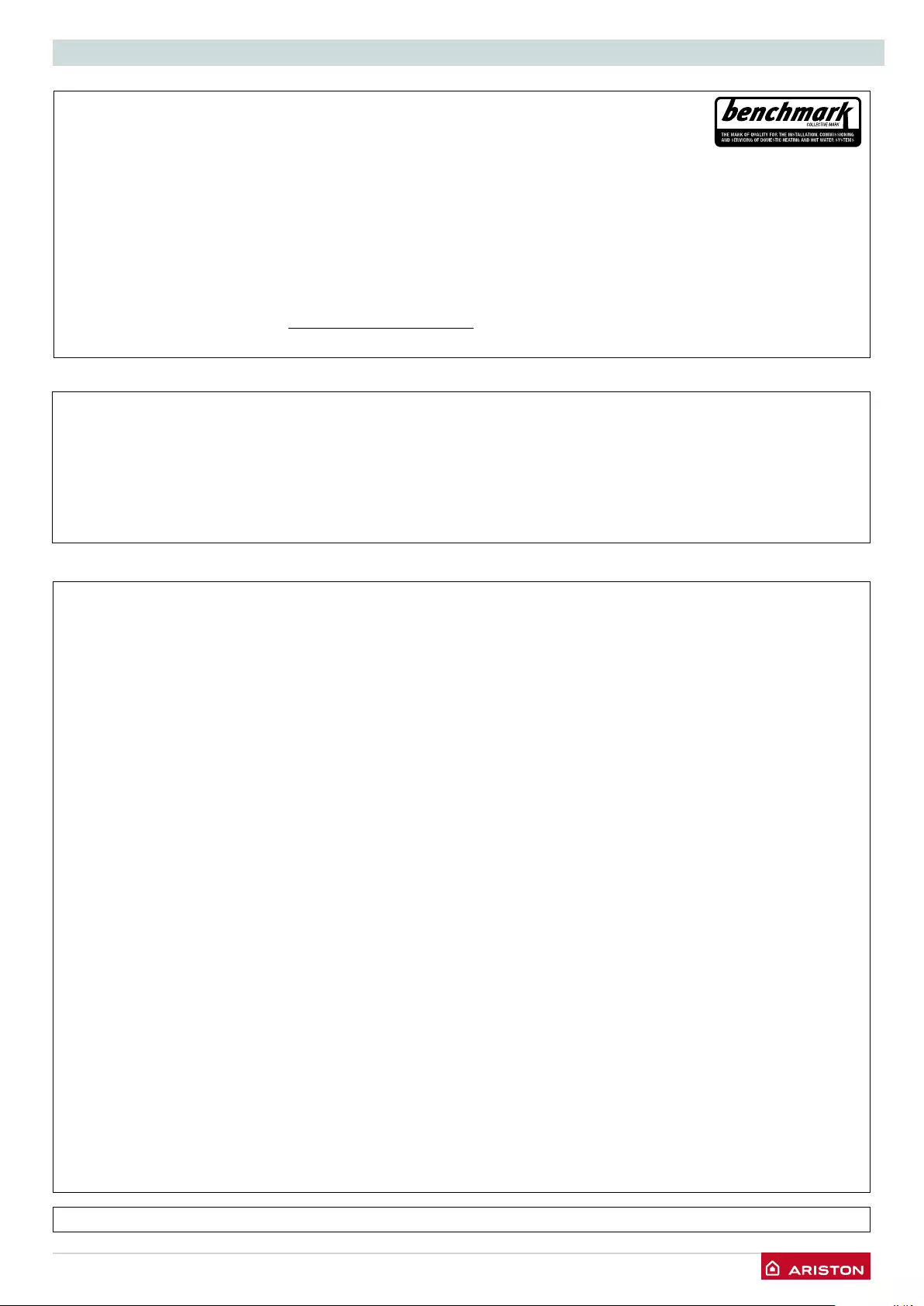
/ 3
OVERVIEW
These instructions are suitable for Clas ONE, Clas System ONE and Clas Net ONE boilers :
Do not forgot to complete the Benchmark Commissioning Checklist!
The Benchmark Scheme
Benchmark places responsibilities on both manufacturers and installers. The purpose is to ensure that customers
are provided with the correct equipment for their needs, that it is installed, commissioned and serviced in
accordance with the manufacturer’s instructions by competent persons and that it meets the requirements of
the appropriate Building Regulations. The Benchmark Checklist can be used to demonstrate compliance with
Building Regulations and should be provided to the customer for future reference.
Installers are required to carry out installation, commissioning and servicing work in accordance with the
Benchmark Code of Practice which is available from the Heating and Hotwater Industry Council who manage
and promote the Scheme. Visit www.centralheating.co.uk for more information.
To The Installer
As part of the commissioning of this appliance it is vital that the Benchmark Commissioning Checklist is completed and
given to the Householder. Please ensure that your customer is aware of the importance of keeping the Commissioning
Checklist and Service Interval Record safe to document the product’s history.
Please ensure that your customer is aware of the correct operation of the system, boiler and controls.
ARISTON recommend the use of protective clothing, when installing and working on the appliance i.e. gloves.
CUSTOMER CARE
ARISTON, as a leading manufacturer of domestic and commercial water heating appliances is committed to providing
high quality products and a high quality after sales service.
Advice on installation or servicing can also be obtained by contacting the ARISTON Technical and Customer Service
Departments at High Wycombe.
TECHNICAL DEPARTMENT CUSTOMER SERVICE DEPARTMENT
Tel: 0333 240 7777 Tel: 0333 240 8777
Fax: 01494 459775 Fax: 01494 459775
WARRANTY
The manufacturer’s warranty is for 8 (Clas ONE & Clas System ONE) or 12 (CLAS NET ONE) years from the date of
purchase. The warranty is invalidated if the appliance is not installed in accordance with the recommendations made
herein or in a manner not approved by the manufacturer. To assist us in providing you with an efcient after sales
service, please register the warranty online at www.ariston.co.uk
CAUTION
In the United Kingdom, installation, start-up, adjustments and maintenance, must be performed by a competent person
only, in accordance with the current Gas Safety (Installation & Use) Regulations and the instructions provided.
In the Republic of Ireland, the installation and initial start up of the appliance must be carried out by a Competent
Person in accordance with the current edition of I.S.813 “Domestic Gas Installations”, the current Buidling Regulations,
reference should also be made to the current ETCI rules for electrical installation.
All GAS SAFE registered installers carry a GAS SAFE ID card, and have a registration number. Both should be
recorded in your boiler Benchmark Commissioning Checklist. You can check your installer is GAS SAFE registered
by calling GAS SAFE directly on:- 0800 408 5500.
Improper installation may cause damage or injury to individuals, animals and personal property for which the
manufacturer will not be held liable. To ensure efcient and safe operation it is recommended that the boiler is serviced
annually by a competent person.
If it is known that a fault exists on the appliance, it must not be used until the fault has been corrected by a competent
person.
Please refer to the terms and conditions of warranty in the user manual which are also available on our website.
This instruction booklet is especially designed for appliances installed in the UK and the Republic of Ireland
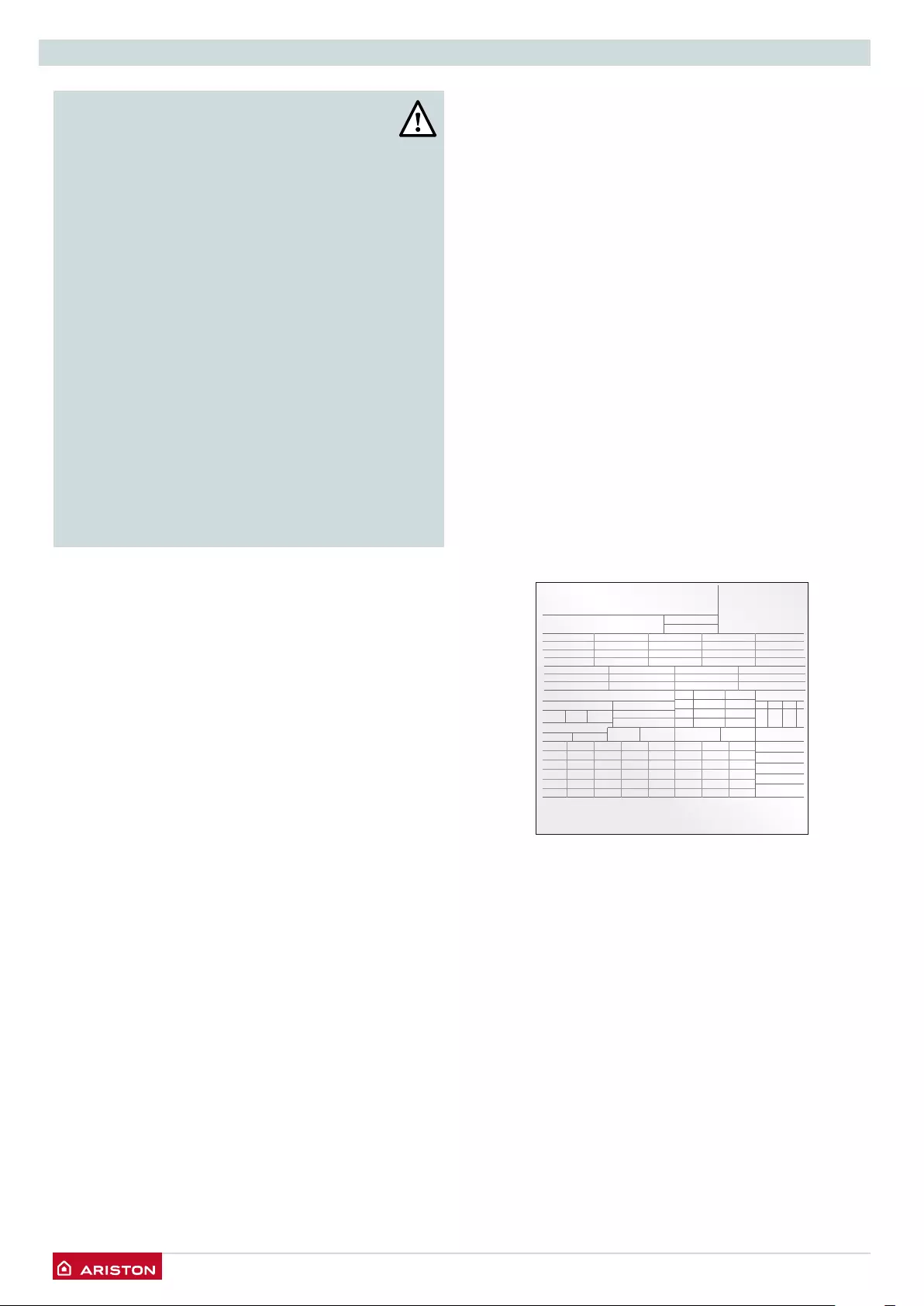
4 /
OVERVIEW
CE labelling
The CE mark guarantees that the appliance conforms to the
following directives:
- 2009/142/CEE
relating to gas appliances
- 2014/30/EU
relating to electromagnetic compatibility
- 92/42/CEE
relating to energy efciency
- 2014/35/EU
relating to electrical safety
- 2009/125/CE
Energy related Products
- 813/2013
Commission regulation (EU)
Advice for the installer
This appliance is designed to produce hot water for domestic
use.
It should be connected to a heating system and a distribution
network for domestic hot water, both of which must be compatible
with its performance and power levels.
The use of the appliance for purposes other than those
specied is strictly forbidden. The manufacturer cannot be held
responsible for any damage caused by improper, incorrect and
unreasonable use of the appliance or by the failure to comply
with the instructions given in this manual.
Installation, maintenance and all other interventions must be
carried out in full conformity with the governing legal regulations
and the instructions provided by the manufacturer. Incorrect
installation can harm persons, animals and possessions; the
manufacturing company shall not be held responsible for any
damage caused as a result. The boiler is delivered in a carton.
Once you have removed all the packaging, make sure the
appliance is intact and that no parts are missing. If this is not the
case, please contact your supplier.
Keep all packaging material (clips, plastic bags, polystyrene foam,
etc.) out of reach of children as it may present a potential hazard.
In the event of a fault and/or malfunction, turn the appliance
off, turn off the gas cock and do not attempt to repair it yourself.
Contact a qualied professional instead.
Before any maintenance or repair work is performed on the
boiler, make sure you have disconnected it from the electricity
supply by switching the external bipolar switch to the “OFF”
position and removing the fuse.
All repairs, which should only be performed using original spare
parts, should be carried out by a qualied professional. Failure
to comply with the above instructions could compromise the
safety of the appliance and invalidate all liability on the part of
the manufacturer.
In the event of any maintenance or other structural work in the
immediate vicinity of the ducts or ue gas exhaust devices and
their accessories, switch the appliance off by switching the
external bipolar switch to the “OFF” position and shutting off the
gas control valve. When the work has been completed, ask a
Symbols used on the data plate
MIN
Q
MAX
P
60/80°C
1
2
5
4
3
3
6
7
19
8
9
10 11
12
14
15
16 17 18
13
20
21
22
1
Legend :
1. Brand
2. Manufacturer
3. Boiler model
Serial number
4. Commercial reference
5. Certication number
6. Destination country
Gas category
7. Gas setting
8. Installation type
9. Electrical data
10. Maximum domestic hot
water pressure
11. Maximum heating pressure
12. Boiler type
13. NOx class / Efciency
14. Input rating nominal
heating
15. Power ouput heating
16. DHW specic ow rate
17. Boiler output efciency
18. Input rating nominal DHW
19. Gases which may be used
20. Minimum ambient
temperature for use
21. Max. central heating
temperature
22. Max. domestic hot water
temperature
ATTENTION!!
THE INSTALLATION AND FIRST
IGNITION OF THE BOILER MUST BE
PERFORMED BY GAS SAFE REGISTERED
ENGINEER IN COMPLIANCE WITH
GAS SAFETY (INSTILLATION & USE)
REGULATIONS AND ALL OTHER NATIONAL
REGULATIONS REGARDING INSTALLATION,
AND IN CONFORMITY WITH ANY
REQUIREMENTS ESTABLISHED BY LOCAL
AUTHORITIES AND PUBLIC HEALTH
ORGANISATIONS.
AFTER THE BOILER HAS BEEN INSTALLED,
THE INSTALLER MUST ENSURE THAT THE
END USER RECEIVES THE DECLARATION
OF CONFORMITY AND THE OPERATING
MANUAL, AND SHOULD PROVIDE ALL
NECESSARY INFORMATION AS TO HOW
THE BOILER AND THE SAFETY DEVICES
SHOULD BE HANDLED.
qualied technician to check the efciency of the ducting and
the devices.
Turn the boiler off and turn the external switch “OFF” to clean
the exterior parts of the appliance.
Clean using a cloth dampened with soapy water. Do not use
aggressive detergents, insecticides or toxic products. If the
appliance is used in full compliance with current legislation, it
will operate in a safe, environmentally-friendly and cost-efcient
manner.
If using kits or optional extras, make sure they are authentic.
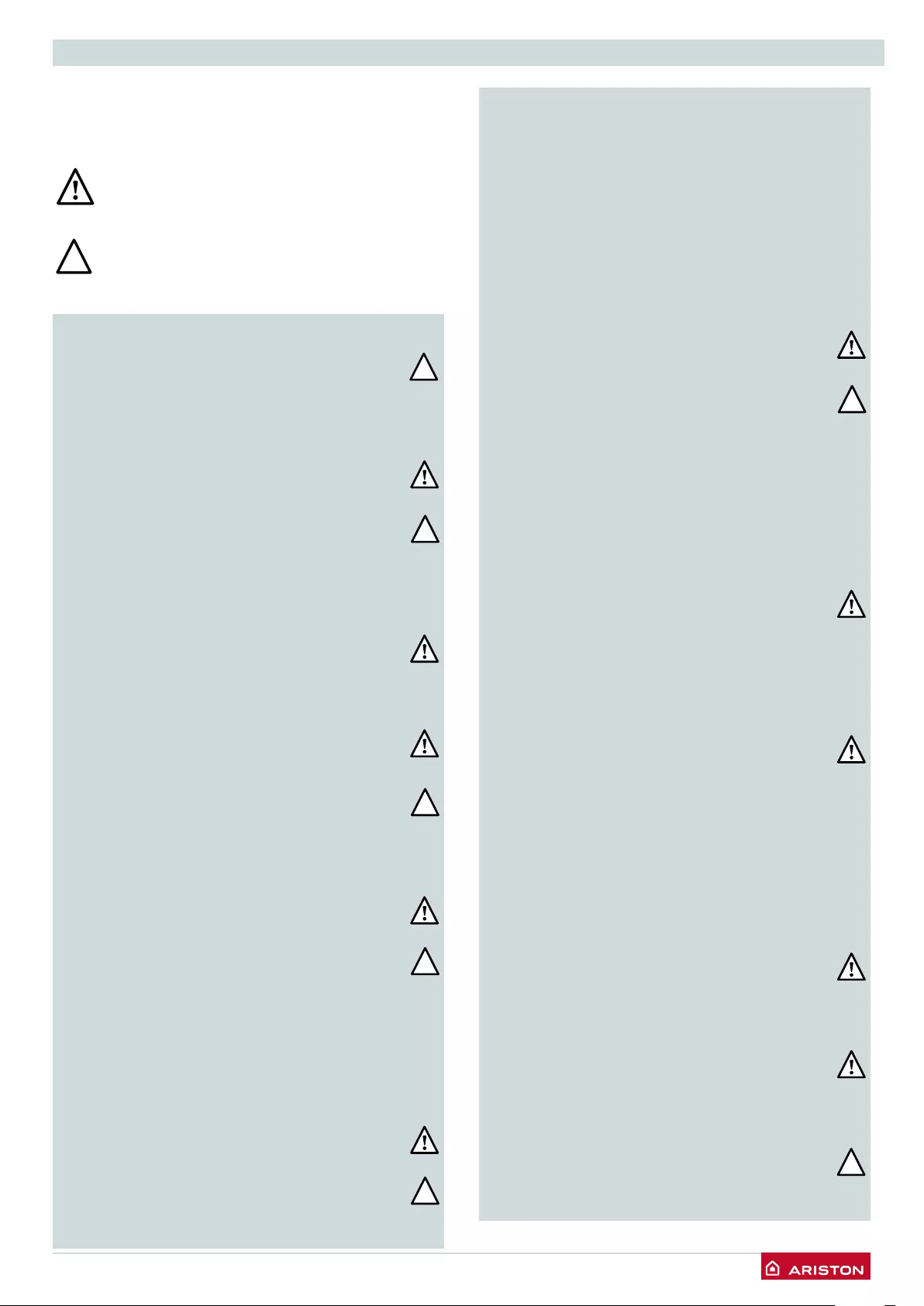
/ 5
OVERVIEW
Install the appliance on a solid wall which is not
subject to vibration.
Noisy operation.
When drilling holes in the wall for installation
purposes, take care not to damage any electrical
wiring or existing piping.
Electrocution caused by contact with live
wires. Explosions, res or asphyxiation caused
by gas leaking from damaged piping.
Damage to existing installations.
Flooding caused by water leaking from
damaged piping.
Perform all electrical connections using wires
which have a suitable section.
Fire caused by overheating due to electrical
current passing through undersized cables.
Protect all connection pipes and wires in order to
prevent them from being damaged.
Electrocution caused by contact with live
wires. Explosions, res or asphyxiation caused
by gas leaking from damaged piping.
Flooding caused by water leaking from
damaged piping.
Make sure the installation site and any systems
to which the appliance must be connected comply
with the applicable norms in force.
Electrocution caused by contact with live wires
which have been installed incorrectly.
Damage to the appliance caused by improper
operating conditions.
Use suitable manual tools and equipment (make
sure in particular that the tool is not worn out
and that its handle is xed properly); use them
correctly and make sure they do not fall from
a height. Replace them once you have nished
using them.
Personal injury from the falling splinters or
fragments, inhalation of dust, shocks, cuts,
pricks and abrasions.
Damage to the appliance or surrounding
objects caused by falling splinters, knocks and
incisions.
Use electrical equipment suitable for its intended
use (in particular, make sure that the power
supply cable and plug are intact and that the
parts featuring rotary or reciprocating motions
are fastened correctly); use this equipment
correctly; do not obstruct passageways with the
power supply cable, make sure no equipment
could fall from a height. Disconnect it and replace
it safely after use.
Personal injury caused by falling splinters
or fragments, inhalation of dust, knocks,
cuts, puncture wounds, abrasions, noise and
vibration.
Damage to the appliance or surrounding
objects caused by falling splinters, knocks and
incisions.
Make sure any portable ladders are positioned
securely, that they are suitably strong and that
the steps are intact and not slippery and do not
wobble when someone climbs them. Ensure
someone provides supervision at all times.
Personal injury caused by falling from a height
or cuts (stepladders shutting accidentally).
Make sure any rolling ladders are positioned
securely, that they are suitably strong, that the
steps are intact and not slippery and that the
ladders are tted with handrails on either side of
the ladder and parapets on the landing.
Personal injury caused by falling from a height.
During all work carried out at a certain height
(generally with a difference in height of more
than two metres), make sure that parapets are
used to surround the work area or that individual
harnesses are used to prevent falls. The space
where any accidental fall may occur should be
free from dangerous obstacles, and any impact
upon falling should be cushioned by semi-rigid or
deformable surfaces.
Personal injury caused by falling from a height.
Make sure the workplace has suitable hygiene
and sanitary conditions in terms of lighting,
ventilation and solidity of the structures.
Personal injury caused by knocks, stumbling
etc.
Protect the appliance and all areas in the vicinity
of the work place using suitable material.
Damage to the appliance or surrounding
objects caused by falling splinters, knocks and
incisions.
SAFETY REGULATION
Key to symbols:
Failure to comply with this warning
implies the risk of personal injury, in some
circumstances even fatal
Failure to comply with this warning
implies the risk of damage, in some
circumstances even serious, to property,
plants or animals.

6 /
OVERVIEW
Handle the appliance with suitable protection
and with care.
Damage to the appliance or surrounding
objects from shocks, knocks, incisions and
squashing.
During all work procedures, wear individual
protective clothing and equipment.
Personal injury caused by electrocution, falling
splinters or fragments, inhalation of dust,
shocks, cuts, puncture wounds, abrasions,
noise and vibration.
Place all debris and equipment in such a way
as to make movement easy and safe, avoiding
the formation of any piles which could yield or
collapse.
Damage to the appliance or surrounding
objects from shocks, knocks, incisions and
squashing.
All operations inside the appliance must be
performed with the necessary caution in order to
avoid abrupt contact with sharp parts.
Personal injury caused by cuts, puncture
wounds and abrasions.
Reset all the safety and control functions
affected by any work performed on the appliance
and make sure they operate correctly before
restarting the appliance.
Explosions, res or asphyxiation caused by
gas leaks or an incorrect ue gas exhaust.
Damage or shutdown of the appliance caused
by out-of-control operation.
Before handling, empty all components that
may contain hot water, carrying out any bleeding if
necessary.
Personal injury caused by burns.
Descale the components, in accordance
with the instructions provided on the safety
data sheet of the product used, airing the
room, wearing protective clothing, avoid mixing
different products, and protect the appliance and
surrounding objects.
Personal injury caused by acidic substances
coming into contact with skin or eyes; inhaling
or swallowing harmful chemical agents.
Damage to the appliance or surrounding
objects due to corrosion caused by acidic
substances.
This appliance can be used by children
aged from 8 years and above and
person with reduced physical, sensory
or mental capabilities or lack of experience
and knowledge if they have been given
supervision or instruction concerning use of
the appliance in a safe way and understand
the hazards involved. Children shall not
play with the appliance. Cleaning and user
maintenance shall not be made by children
without supervision.
If you detect a smell of burning or smoke, keep
clear of the appliance, disconnect it from the
electricity supply, open all windows and contact
the technician.
Personal injury caused by burns, smoke
inhalation, asphyxiation.
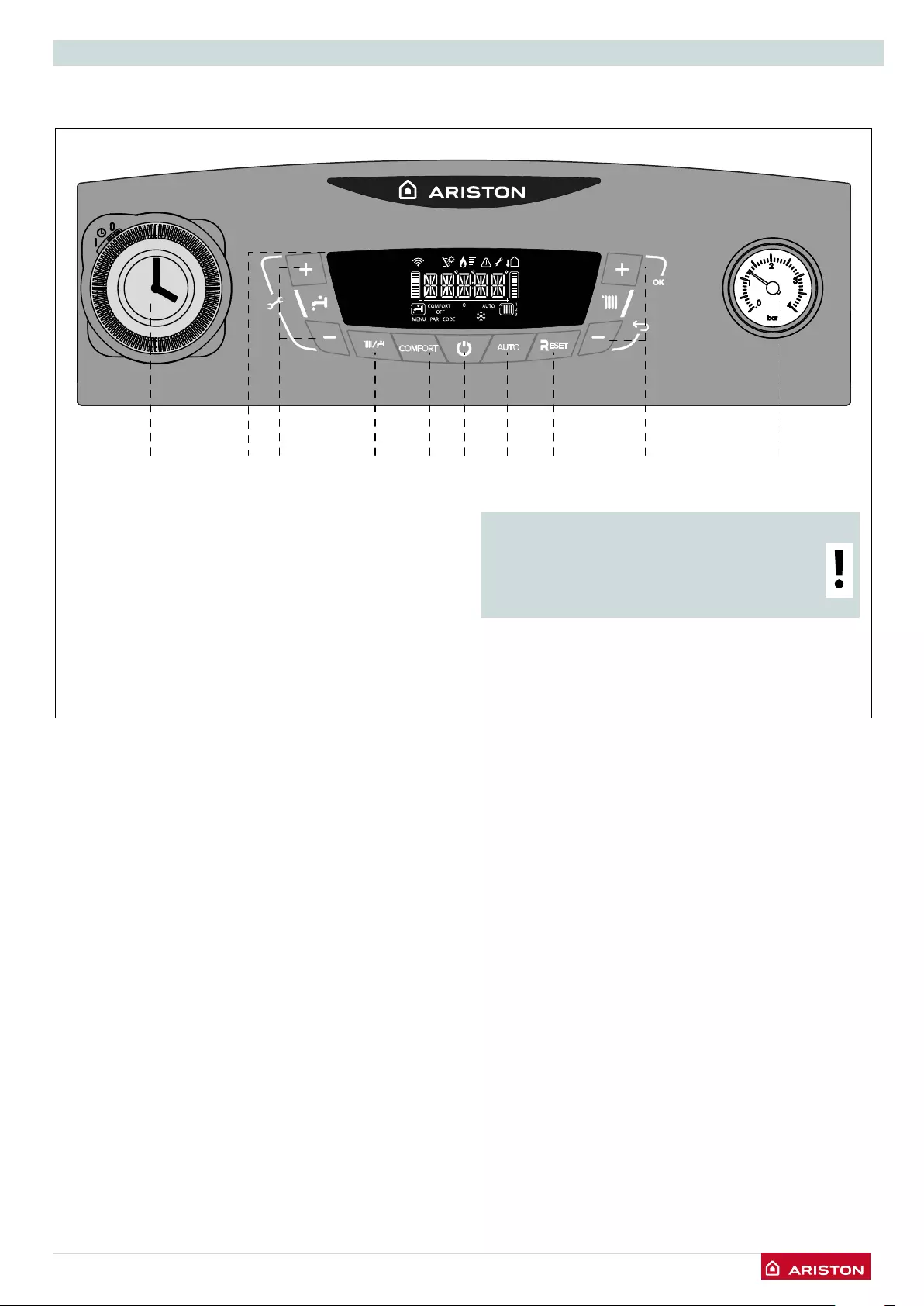
/ 7
PRODUCT DESCRIPTION
CONTROL PANEL
Legend:
1. Display
2. Domestic Hot Water adjustment button +/- (a)
3. MODE button
(Operation mode selection summer/winter)
4. COMFORT button
5. ON/OFF button
6. Auto button (To activate Thermoregulation)
7. RESET button
8 Heating temperature adjustument button +/- (b)
9. Time clock
10. Pressure gauge
21 39 104 5 6 7 8
(a)
Pressing the buttons simultaneously allows
access to the engineers menu and all
parameters and settings
(b)
Use these buttons to modify and save the
parameter settings
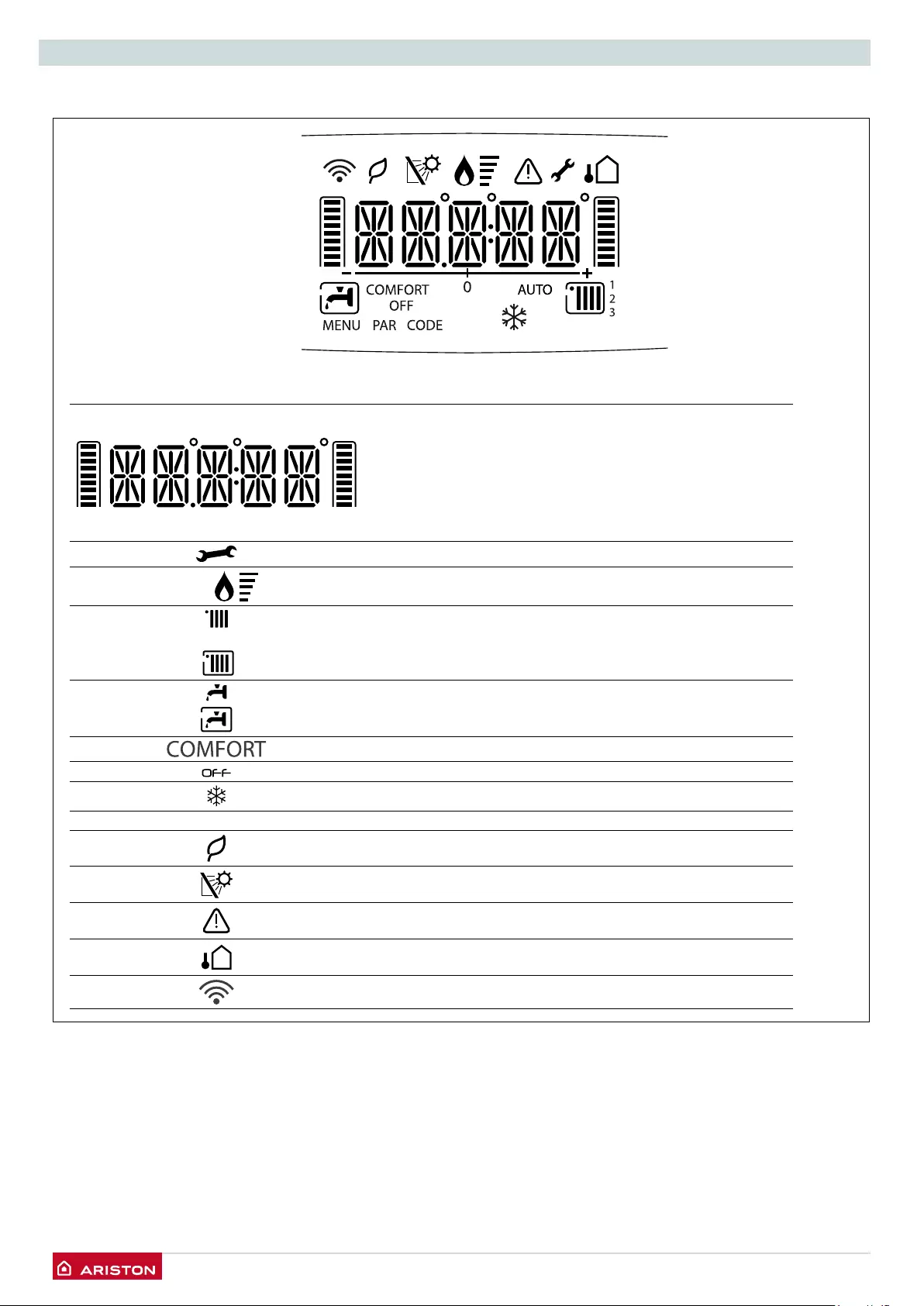
8 /
PRODUCT DESCRIPTION
DISPLAY
Legend:
Digits indicating:
- boiler status
- temperature indication with bar level
- error code signals
(ERROR)
- Request press RESET button
(boiler block)
- menu settings
Technical assistance request
Flame detected with indication of power used
Heating operation set
Heating operation active
Hot water operation set
Hot water operation active
Hot Water Comfort activated
Boiler off with antifreeze function active
Anti-frost Function Active
AUTO AUTO function activated
High efciency operation (low C.H. ow temperature)
Solar temperature probe connected - option
Error signals
The display shows the code
External temperature displayed
(with external sensor optional)
Wi-Fi active (Kit Optional)
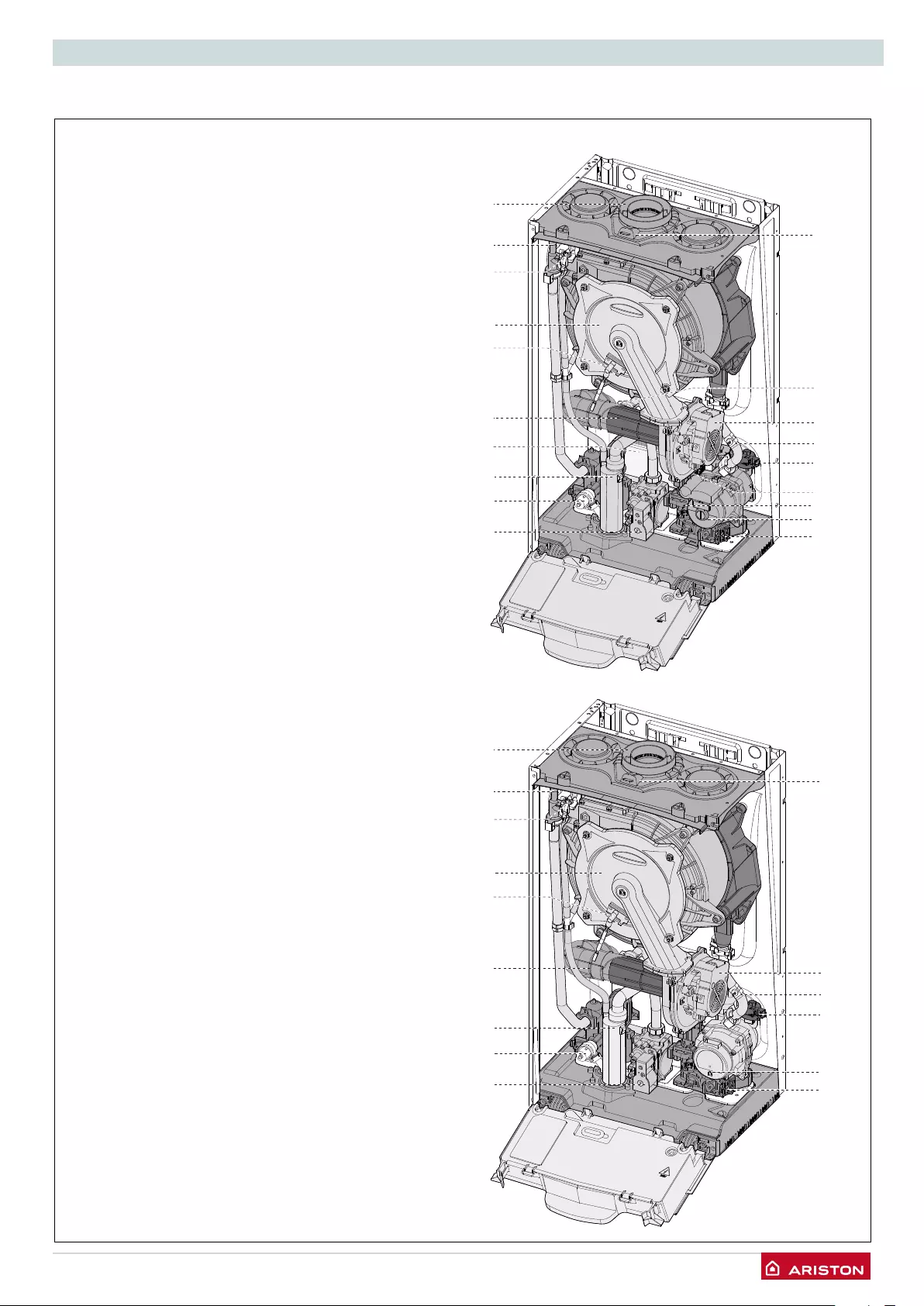
/ 9
PRODUCT DESCRIPTION
CLAS ONE / CLAS NET ONE
Overall view
1
2
5
6
8
9
10 12
13
14
15
16
17
20
18
4
7
3
19
1
2
5
6
8
9
10 12
13
16
17
20
18
4
3
1. Flue connector
2. Air relief valve
3. C.H. Flow temperature probe
4. Main heat exchanger
5. Detection Electrode
6. Air/Gas Mixer
7. Secondary heat exchanger
8 Condensate trap
9. C.H. pressure relief valve
10. Gas valve
12. C.H. circuit lter
13. Modulating circulation Pump with air release
valve
14. D.H.W. Flow switch
15. Diverter valve
16. Switch On-Off
17. C.H. Return temperature probe
18. Modulating Fan
19. Silencer
20. Combustion Analysis Test Point
CLAS SYSTEM ONE
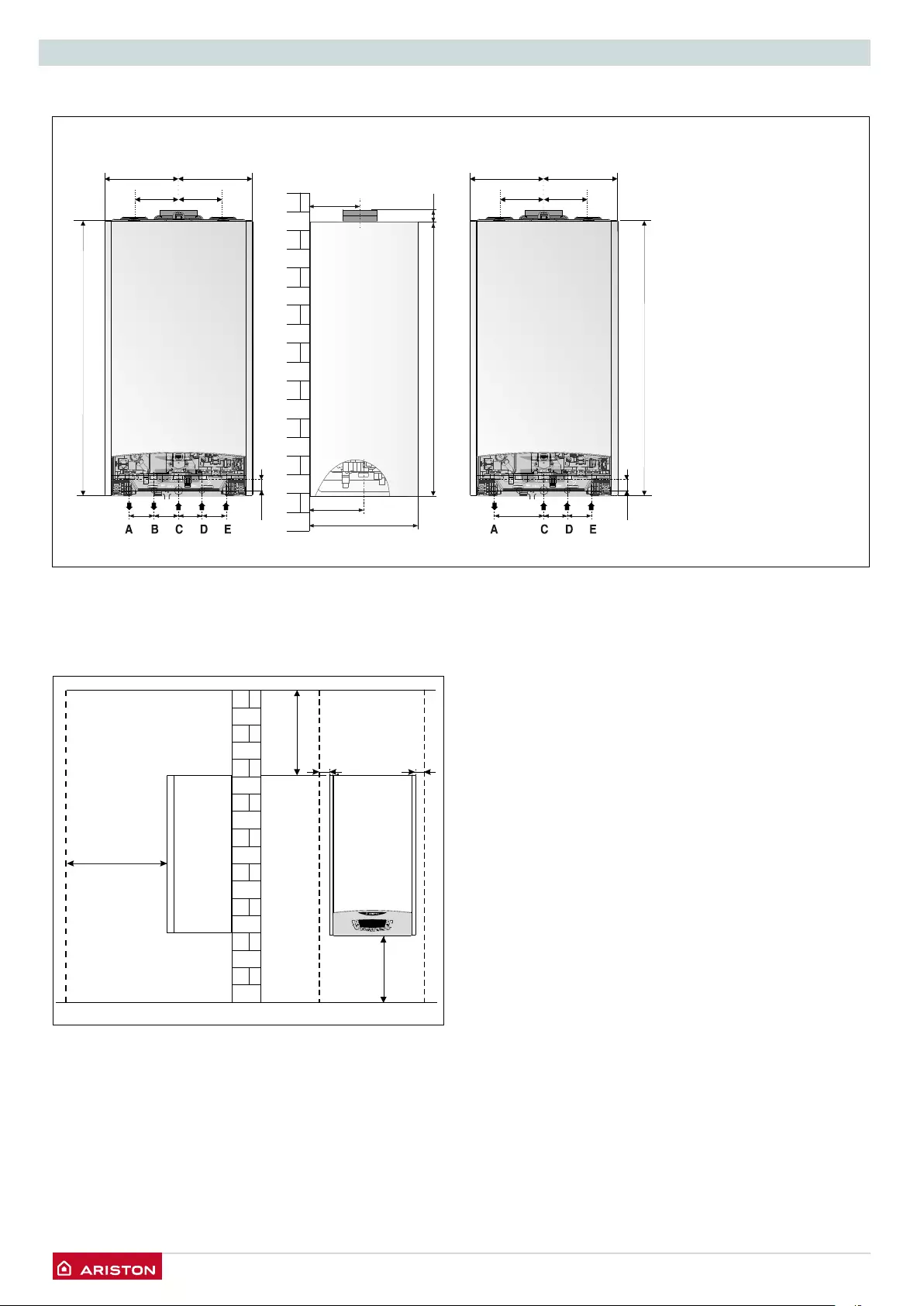
10 /
PRODUCT DESCRIPTION
Overall Dimensions
Minimum clearances
In order to allow easy access to the boiler for maintenance
operations, The boiler must be installed in accordance with the
clearances stated below.
150
315 (Mod. 24)
385 (Mod. 30/35)
180
25745
745
200
120 120
200
28
65 6567 67
745
200
120 120
200
28
132 6567
CLAS ONE / CLAS NET ONE
A. Central Heating Flow
B. Domestic Hot Water Outlet
C. Gas Inlet
D. Domestic Cold Water Inlet
E. Central Heating Return
CLAS SYSTEM ONE
450
053
003
50 50
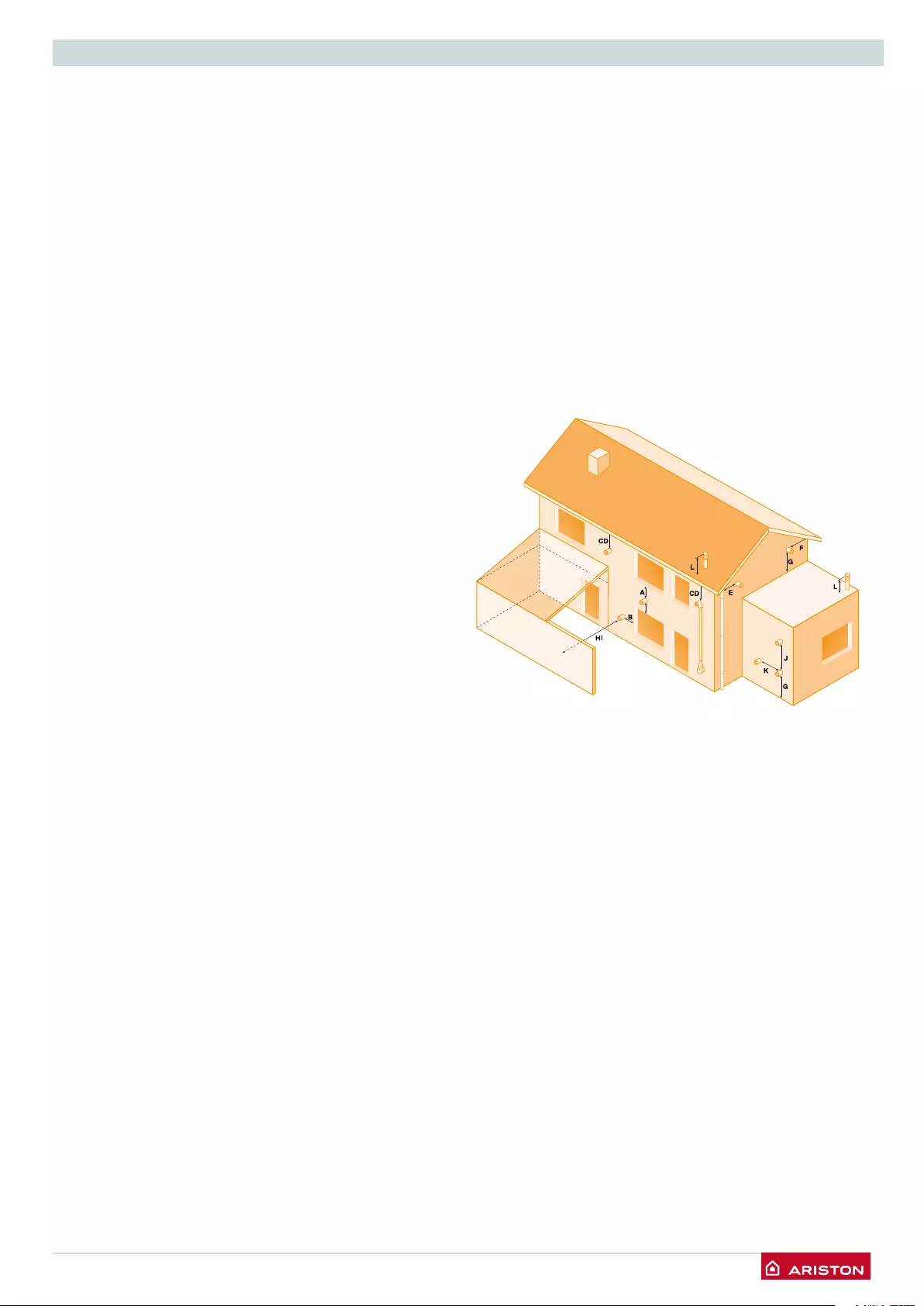
/ 11
INSTALLATION
Reference Standards
In the United Kingdom, the installation and initial start-up of the
boiler must be by a Gas Safe registered installer in accordance
with the installation standards currently in effect, as well as with
any and all local health and safety standards i.e. Gas Safe.
In the Republic of Ireland the installation and initial start-up of
the appliance must be carried out by a Competent Person in
accordance with the current edition of I.S.813 “Domestic Gas
Installations” and the current Building Regulations, reference
should also be made to the current ETCI rules for electrical
installation.
The installation of this appliance must be in accordance with
the relevant requirements of the Local Building Regulations,
the current I.E.E. Wiring Regulations, the by-laws of the local
authority, in Scotland, in accordance with the Building Standards
(Scotland) Regulation and Health and Safety document No. 635,
“Electricity at Work Regulations 1989” and in the Republic of
Ireland with the current edition of I.S. 813 and the Local Building
Regulations (IE).
C.O.S.H.H.
Materials used in the manufacture of this appliance are non-
hazardous and no special precautions are required when
servicing.
Codes of Practice
Installation should also comply with the following British
Standards Code of Practice (refer to the most recent version):
BS 7593: Treatment of water in domestic hot water
central heating systems
BS 5546: Installation of hot water supplies for
domestic purposes
BS 5440-1: Flues
BS 5440-2: Air supply
BS EN 12831 - BS EN 14336:
Forced circulation hot water systems
BS 6798: Installation of gas red hot water boilers
of rated input not exceeding 70kW
BS 6891: Installation of low pressure gas pipes up to 28mm
BS 7671: IEE Wiring Regulations
BS 4814: Specication for expansion vessels
BS 5482: Installation of L.P.G.
Technical Bulletin TB143 Flue Gas Analysis
and in the Republic of Ireland in accordance with the following
codes of practice:
I.S. 813 Domestic Gas Installations
Avoid installing the boiler where the air inlet can be polluted
by chemical products such as chlorine (swimming pool area), or
ammonia (hair dresser), or alkalin products (launderette).
Flue
Detailed information on ue assembly can be found in the
“Connecting the Flue” section.
The boiler must be installed so that the ue terminal is exposed
to the free passage of external air at all times and must not be
installed in a place likely to cause nuisance. It must not be
allowed to discharge into another room or space such as an
outhouse or closed lean-to.
Condensing boilers have a tendency to form a plume of water
vapour from the ue terminal due to the low temperature of
the ue gasses. The terminal should therefore be located with
due regard for the damage or discolouration that may occur
to building within the vicinity and consideration must also be
given to adjacent boundaries, openable windows should also
be taken into consideration when siting the ue.
The minimum acceptable clearances are shown below:
- A Directly below an opening, window, etc 300 mm
- B Horizontally to an opening, window, etc 300 mm
- C Below gutters, soils pipes or drain pipes 75 mm
- D Below eaves 200 mm
- E From vertical drain pipe or soil pipe 75 mm
- F From internal or external corner 300 mm
- G Above ground, roof or balcony level 300 mm
- H From a surface facing the terminal 600 mm
- I From a terminal facing a terminal 1200 mm
- J Vertically from a terminal on the same wall 1500 mm
- K Horizontally from an terminal on the same wall 300 mm
- L Fixed by vertical ue terminal
Note: the flue must Not be iNstalled iN a place likely to cause a
NuisaNce aNd positioNed to eNsure that products of combustioN do
Not discharge across a bouNdary
It may be necessary to protect the terminal with a guard, if this
is the case it will be necessary to purchase a stainless steel
terminal guard. Reference should be made to the Building
Regulations for guidance.
Ventilation
The room in which the boiler is installed does not require
specic ventilation. If the boiler is installed in a cupboard or
compartment ventilation is not required for cooling purposes.

12 /
INSTALLATION INSTALLATION
Gas Supply
The gas installation and tightness testing must be in accordance
with the requirements of BS6891. Ensure that the pipe size is
adequate for demand including other gas appliances on the
same supply.
Electrical Supply
The appliance requires an earthed 230V - 50 Hz supply and
must be in accordance with current I.E.E. regulations. It must
also be possible to be able to completely isolate the appliance
electrically. Connection should be via a 3 amp double pole fused
isolating switch with contact separation of at least 3mm on both
poles. Alternatively, a fused 3 amp, 3 pin plug and unswitched
socket may be used, provided it is not used in a room containing
a bath or shower. It should only supply the appliance.
Water Supply
The boiler is suitable for sealed systems only. The maximum
working pressure for the appliance is 6 bar. All ttings and
pipework for the appliance should be of the same standard. If
there is a possibility of the incoming mains pressure exceeding 6
bar, particularly at night, then a suitable pressure limiting valve
must be tted.
The boiler is designed to provide hot water on demand to
multiple outlets within the property. If there is a requirement
for greater demands, for example if the boiler has several
bathrooms and cloakrooms, a vented or unvented hot water
storage system may be used.
Showers
Any shower valves used with the appliance should be of a
thermostatic or pressure balanced type. Refer to the shower
manufacturer for performance guidance and suitability.
Flushing and Water Treatment
The boiler is equipped with a stainless steel heat exchanger.
The detailed recommendations for water treatment are given
in BS 7593 (Treatment of water in domestic hot water central
heating systems); the following notes are given for general
guidance.
If the boiler is installed on an existing system, any unsuitable
additives must be removed.
Under no circumstances should the boiler be red before the
system has been thoroughly ushed; the ushing procedure
must be in line with BS 7593.
We highly recommend the use of a ushing detergent
appropriate for the metals used in the circuit.
In hard water areas or where large quantities of water are in the
system the treatment of water to prevent premature scaling of
the main exchanger is necessary.
The formation of scale heat compromises the efciency of the
thermic exchanger because small areas of scale cause a high
increase of the temperature of the metallic walls and therefore
add to the thermal stress of the heat exchanger.
Demineralised water is more aggressive so in this situation it
is necessary to treat the water with an appropriate corrosion
inhibitor.
Any treatment of water by additives in the system for frost
protection or for corrosion inhibition has to be absolutely
suitable for all metals used in the circuit.
The use of a corrosion inhibitor in the sysem is recommended
to prevent corrosion (sludge) damaging the boiler and system;
If anti-freeze substances are to be used in the system, check
carefully that they are compatible with the metals used in the
circuit.
ARISTON suggests the use of suitable anti-freeze products,
which will prevent rust and incrustation taking place.
Periodically check the pH balance of the water/anti-freeze
mixture of the boiler circuit and replace it when the amount
measured is out of the range stipulated by the manufacturer (7
< pH < 8).
DO NOT MIX DIFFERENT TYPES OF ANTI-FREEZE
In under-oor systems, the use of plastic pipes without protection
against penetration of oxygen through the walls can cause
corrosion of the systems metal parts (metal piping, boiler etc),
through the formation of oxides and bacterial agents.
To prevent this problem it is necessary to use pipes with an
“oxygen proof barrier”, in accordance with standards DIN
4726/4729. If pipes of this kind are not used, keep the system
separate by installing heat exchangers of those with a specic
system water treatment.
Ariston suggests the installation of a magnetic lter on every
installation.
IMPORTANT
Failure to carry out the water treatment procedure will
invalidate the appliance warranty.
System Controls
The boiler is electrically controlled and is suitable for most
modern electronic time and temperature controls. The addition
of such external controls can be benecial to the efcient
operation of the system. The boiler connections for external
controls are 12V DC and so only controls of 12V DC that have
voltage free contacts should be used. (page 26).
ARISTON supply a range of wired and wireless system controls.
Contact your supplier for more details.
Location
The boiler can be installed on any suitable internal wall
(suitable sound proong may be required when installing
onto a stud partition wall). Provision must be made to allow
for the correct routing of the ue and siting of the terminal to
allow the safe and efcient removal of the ue products. A
compartment or cupboard may be used provided that it has
been built or modied for this purpose. It is not necessary to
provide permanent ventilation for cooling purposes. Detailed
recommendations are given in BS 5440 Part 2. If it is proposed
that it is to be installed in a timber framed building then reference
should be made to IGEM Document, IGE/UP/7 or advice sought
from Gas Safe.
Where a room sealed appliance is installed in a room
containing a bath or shower, the appliance and any electrical
switch or appliance control, utilising mains electricity should
be situated specically in accordance with current IEE Wiring
Regulations.
For unusual locations, special procedures may be necessary.
BS 6798 gives detailed guidance on this aspect.
Codensate Discharge
The condensate discharge hose from the boiler must have
a continuous fall of 2.5o and must be inserted by at least
50mm into a suitable acid resistant pipe - e.g. plastic waste or
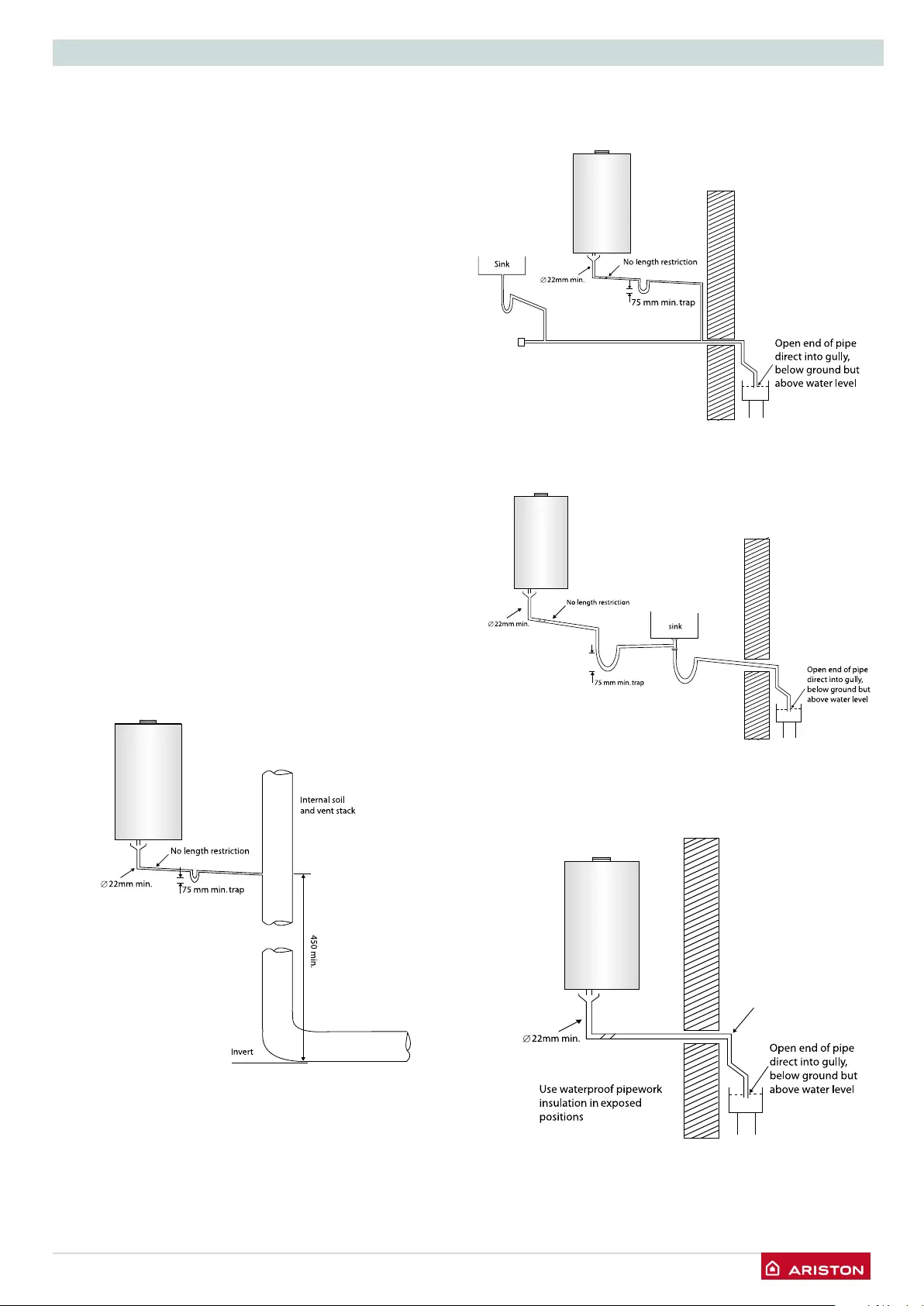
/ 13
INSTALLATION
overow pipe. The condensate discharge pipe must have a
minimum diameter of 22mm, must have a continuous fall and
preferably be installed and terminated to prevent freezing.
The discharge pipe must be terminated in a suitable position:
i) Connecting into an internal soil stack (at least 450mm above
the invert of the stack). A trap giving a water seal of at least
75mm must be incorporated into the pipe run, there also
must be an air beak upstream of the trap.
ii) Connecting into the waste system of the building such as
a washing maching or sink trap. The connection must be
upstream of the washing machine/sink. If the connection is
downstream of the waste trap then an additional trap giving
a minimum water seal of 75mm and an air break must be
incorporated in the pipe run, as above.
iii) Terminating into a gully, below the grid level but above the
water level
iv) Into a soakaway
Note: If any condensate pipework is to be installed externally
then it should be kept to a minimum and be insulated with a
waterproof insulation and have a continuous fall. The total
length of external pipe used should not exceed 3 metres.
Some examples of the type of condensate terminations can be
found below.
1. Internal termination of condensate drainage pipe to internal
stack.
2. External termination of condensate drainage pipe via internal
discharge branch (e.g. sink waste) and condensate siphon.
3. External termination of condensate drainage pipe via internal
discharge branch (e.g. sink waste - proprietary tting).
4. External termination of condensate drainage pipe via
condensate siphon
Tundish
trap
Tundish
trap
Tundish
Tundish
External pipe length
max. 3 metres
(must be insulated)
Condensate Discharge
Push t the exible condensate pipe into the outlet spigot on
the appliance. Cut to length and locate outlet into a tundish

14 /
INSTALLATION INSTALLATION
Installing the Boiler
Please check that you are familiar with the installation
requirement before commencing work (pages 11 - 15).
The installation accessories described in the following list are
included in the boiler packaging:
- Hanging bracket
- A paper template (showing the dimensions of the boiler with
5 mm side clearances)
- Connection valves (compression)
- Screws and washers
- Filling loop
- Installation, Servicing and User manual
Method of positioning the boiler on the wall
The paper template can be used to ensure the correct positioning
of kitchen cabinets etc.
The paper template has to be xed to the wall and used to
locate the position of the hanging bracket and the centre for the
ue hole.
Drill and plug the wall and secure the hanging bracket using the
screws provided ensure the hanging bracket is level. Remove
the boiler from its packaging and remove the front casing panel.
Place the boiler on the hanging bracket.
Note: the appliaNce must Not be fitted oN a combustible wall surface.
Connecting the boiler to the system
- Remove the boiler casing as described on page 14
- Remove the caps and connect the valves to the boiler using
the washers provided
- 5 x bre washers for the CH ow and return, cold water inlet, gas
and hot water outlet connections
Safety Valve Discharge
The pressure relief valve pipe is made of copper. It should
terminate below the boiler safely outside the premises. Care
should be taken that it does not terminate over an entrance or
window or where a discharge of heated water could endanger
occupants or passers by.
Fill the central heating and DHW system and bleed air from the
system as described in the Commissioning instructions (page
32).
The system should be carefully checked for leaks, as frequent
relling could cause premature system corrosion or unnecessary
scaling of the heat exchanger. The pipe from the trap should be
connected to a drain as described in the relevant regulations.
Pay special attention not to bend the condensate silicone drain
pipe is such a way as to interrupt the ow. Please only use drain
pipe material compatible with condensate products (refer to BS
6798:2009).
The condensate ow can reach 2 litres/hour because of the
acidity of the condensate products (Ph close to 2), take care
before operation.
See page 15 for condensate discharge options.
Note: Connections viewed from behind boiler
Note: Connections viewed from behind boiler
CLAS ONE / CLAS NET ONE
CLAS SYSTEM ONE
Note.
Connections viewed from
behind boiler.
WARNING!
DO NOT APPLY HEAT TO THE COPPER
SAFETY VALVE OUTLET PIPE WHILST IT IS
CONNECTED TO THE 3 BAR SAFETY RELIEF
VALVE.

/ 15
INSTALLATION
Gas connection
Make sure, using the labels on the packaging and the data plate
on the appliance itself, that the boiler is in the correct country
and that the gas category for which the boiler was designed
corresponds to one of the categories available in the country
where it will be used.
The gas supply piping must be created and measured out in
compliance with specic legal requirements and in accordance
with the maximum power of the boiler.
Check that the supplied gas corresponds to the type of gas for
which the boiler was designed (see the data plate located on
the appliance itself).
It is also important to check that the pressure of the gas
(methane or LPG) you will be using to feed the boiler is suitable,
because if it is insufcient the power may be reduced, causing
inconvenience for the user.
Water connection
The illustration below shows the connections for the water and
gas attachments of the boiler. See valves conguration on page
14.
Check that the maximum water mains pressure does not exceed
6 bar; if it does, a pressure reducing valve must be installed.
For the measuring of the pipes and of the heating bodies in the
heating system, the residual head value should be calculated
as a function of the requested ow rate, in accordance with the
values shown in the circulation pump graph.
Legend:
A. Central heating Flow
B. Domestic Hot Water Outlet
(CLAS ONE/CLAS NET ONE)
C. Gas Inlet
D. Domestic Cold Water Inlet
E. Central Heating Return
F. Safety Valve Discharge
H. Drain Valve
I. Condensate discharge
A
B
C
E
D
H
F
I
Instructions for removing the housing and inspecting the
appliance.
Before carrying out any work on the boiler, switch off the power
supply using the external bipolar switch and close the gas tap.
To access the inside of the boiler:
- unscrew the two screws from the front panel (a), pull the panel
forwards and uncouple it from the upper pins (b),
- pivot the electronic unit by pulling it forwards (c).
(a)
(b)
(c)

16 /
INSTALLATION INSTALLATION
To calculate the size of the heating installation, refer to the
"Available pressure" graph below.
Graph representing the available circulation pump pressure
ΔT20oC
Underoor heating
For appliances with underoor heating, it is possible but not
necessary to t a safety thermostat onto the underoor heating
outlet. For the electrical connection of the thermostat see the
section on “Electrical connections - pages 28-29”.
If the outlet temperature is too high, the boiler will stop both
domestic hot water and the heating production and the error
code 1 16 “oor thermostat contact open” will appear on the
display. The boiler will restart when the thermostat is closed
during automatic resetting.
If the thermostat cannot be installed, the underoor heating
equipment must be protected by a thermostatic valve, or by a by-
pass to prevent the oor from reaching too high a temperature.
BEFORE THE DEVICE IS USED, FOR THE
FIRST TIME THE TRAP MUST BE FILLED
WITH WATER.
The siphon is lled with water during
deaeration procedure of the boiler (or heating
system) - see p. 32
Ensure that the siphon contains water; if not, it
must be relled. Open the manual air vent (2)
on the main exchanger until complete lling.
Check again the system pressure on the
pressure gauge.
WARNING!
INSUFFICIENT WATER IN THE TRAP CAN
TEMPORARILY CAUSE THE FLUE GAS TO
BE EXPELLED INTO THE SURROUNDING
AMBIENT AIR
2
0
100
200
300
400
500
600
0 200 400 600 800 1000 1200
mbar
l/h
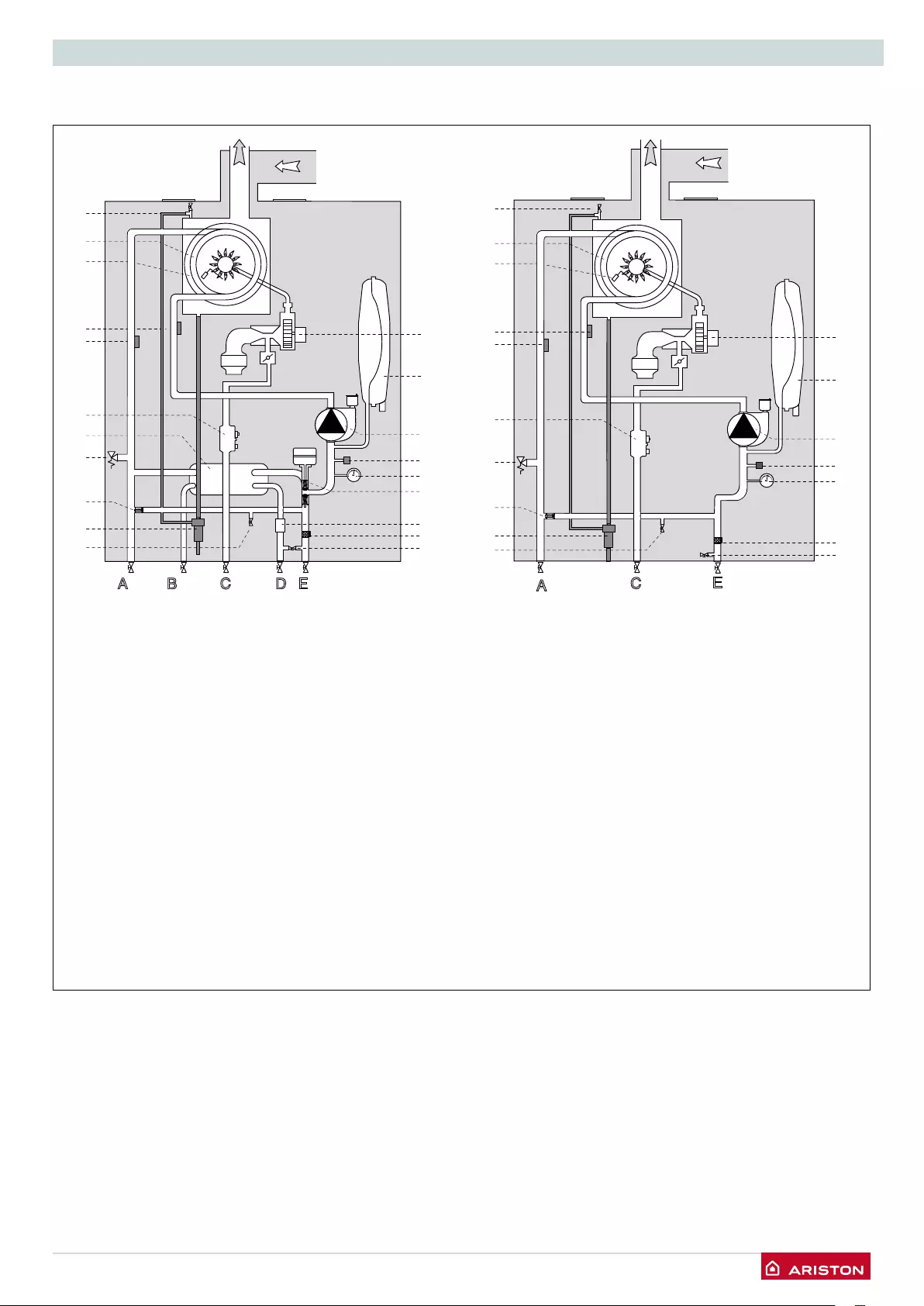
/ 17
INSTALLATION
Water circuit diagram
A B C D E
13
14
15
16
18
17
19
20
1
4
3
9
11
10
12
8
7
5
6
21
1. Air relief valve
3. Main Heat Exchanger
4. Detection/Ignition electrode
5. Central Heating Return Temperature Probe
6. Central Heating Flow Temperature Probe
7. Gas Valve
8. Secondary Exchanger
9. Safety valve
10. Automatic By-pass
11. Drain valve
12. Condensate Trap
13. Filling loop
14. Central Heating Filter
15. D.H.W. Flow Switch
16. Diverter valve
17. Pressure Gauge
18. Switch On/Off
19. Modulating Circulation Pump with air release valve
20. Expansion Vessel
21. Modulating Fan
ACE
13
14
18
17
19
20
21
1
4
3
9
10
12
11
7
5
6
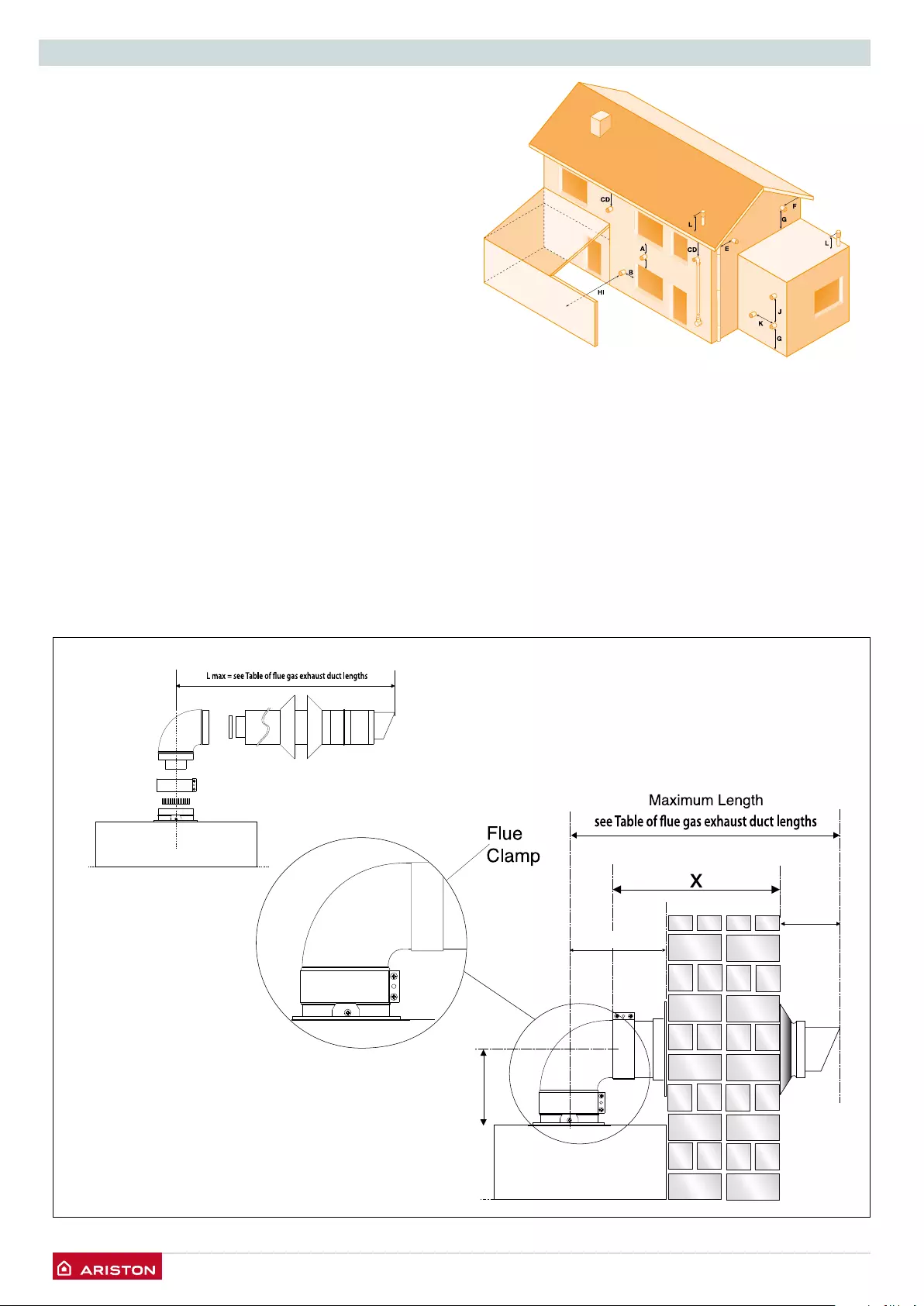
18 /
INSTALLATION INSTALLATION
Connecting the Flue
Flue System
The provision for satisfactory ue termination must be made as
described in BS 5440-1.
The appliance must be installed so that the ue terminal is ex-
posed to outdoor air.
The terminal must not discharge into another room or space
such as an outhouse or lean-to.
It is important that the position of the terminal allows a free pas-
sage of air across it at all times.
The terminal should be located with due regard for the damage
or discolouration that might occur on buildings in the vicinity, it
must also be located in a place not likely to cause nuisance.
In cold or humid weather water vapour may condense on lea-
ving the ue terminal.
The effect of such “steaming” must be considered.
If the terminal is less than 2 metres above a balcony, above
ground or above a at roof to which people have access, then a
suitable stainless steel terminal guard must be tted.
The minimum acceptable spacing from the terminal to obstruc-
tions and ventilation openings are specied in Fig. 1.
- A Directly below an opening, window, etc 300 mm
- B Horizontally to an opening, window, etc 300 mm
- C Below gutters, soils pipes or drain pipes 75 mm
- D Below eaves 200 mm
- E From vertical drain pipe or soil pipe 75 mm
- F From internal or external corner 300 mm
- G Above ground, roof or balcony level 300 mm
- H From a surface facing the terminal 600 mm
- I From a terminal facing a terminal 1200 mm
- J Vertically from a terminal on the same wall 1500 mm
- K Horizontally from an terminal on the same wall 300 mm
- L Fixed by vertical ue terminal
Fig. 1
118 mm
150 mm
Minimum Length = 500 mm
180 mm
Fig. 2
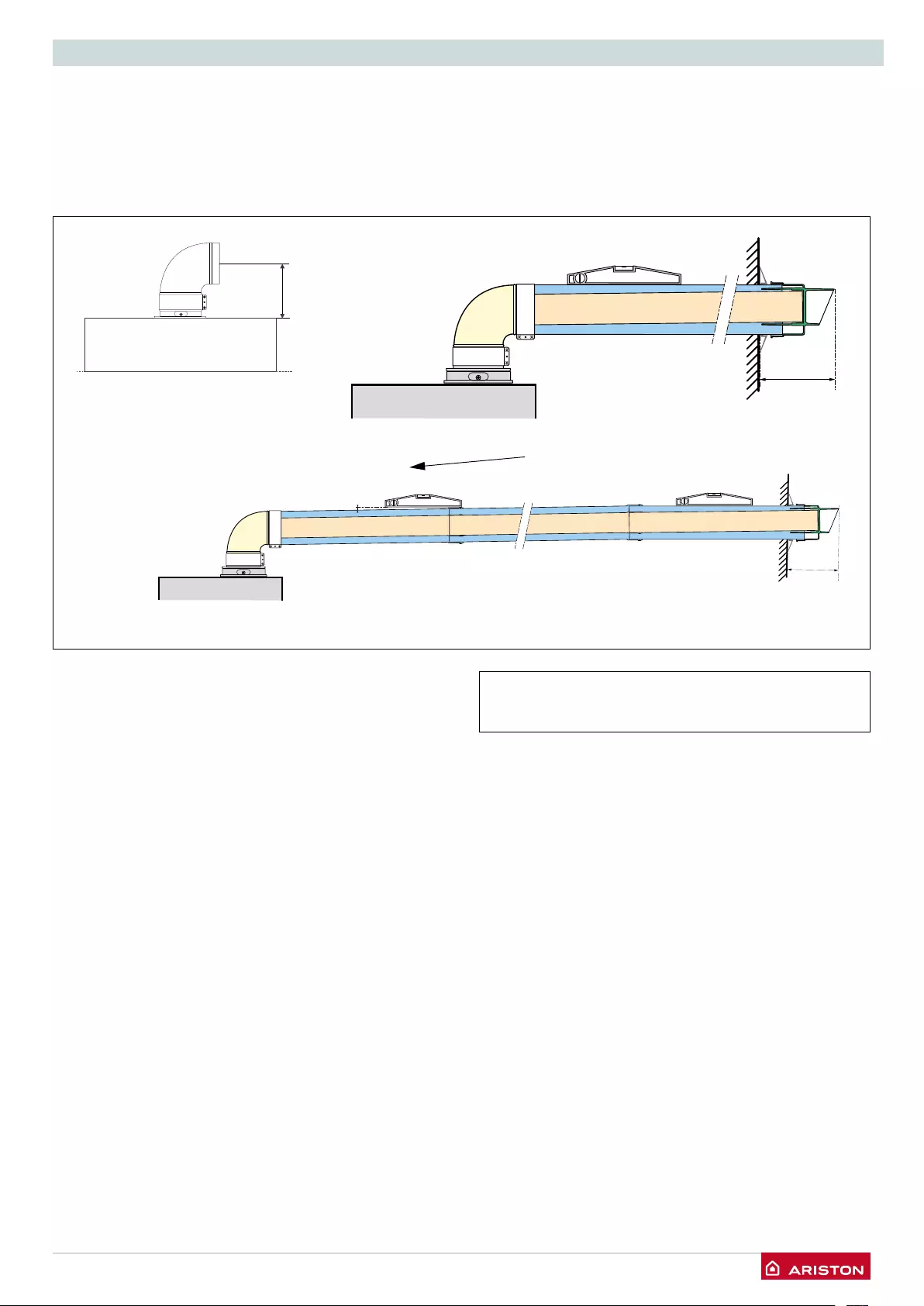
/ 19
INSTALLATION
Warning
The exhaust gas ducts must not be in contact with or close
to inammable material and must not pass through building
structures or walls made of inammable material.
When replacing an old appliance, the ue system must be
changed.
Important
Ensure that the ue is not blocked.
Ensure that the ue is supported and assembled in accordance
with these instructions.
150 mm
118
* Min slope: 1˚
1˚= 17.5mm per metre
150 mm
* pente
Installation without extension
Installation with extension
Level
Level
Fitting the Coaxial Flue (Ø 60 / 100 Horizontal)
Contents:
1x Silicone O-Ring (60mm)
1x Elbow (90°)
2x Wall Seals (Internal & External)
1x Flue Pipe including Terminal (1 metre - 60/100)
2x Flue Clamps
4x Screws
2x Seals
Once the boiler has been positioned on the wall, t the rubber
ue seal into the internal ue turret (see diagram opposite),
Insert the elbow into the socket and rotate to the required
position. note: It is possible to rotate the elbow 360° on its
vertical axis.
Using the ue clamp, seals and screws supplied (Fig 4) secure
the elbow to the boiler.
The 1 metre horizontal ue kit (3318073) supplied is suitable for
an exact X dimension of 753mm.
Measure the distance from the face of the external wall to
the face of the ue elbow (X - Fig 2), this gure must now be
subtracted from 753mm, you now have the total amount to be
cut from the plain end of the ue.
Draw a circle around the outer ue and cut the ue to the
required length taking care not to cut the inner ue, next cut the
inner ue ensuring that the length between the inner and outer
ue is maintained. (Fig 4).
e.g.
X = 555mm
753-555 = 198mm (Length to be cut from the plain end of the
ue).
Once cut to the required length, ensure that the ue is free from
burrs and reassemble the ue. If tting the ue from inside of
the building attach the outer wall seal to the ue terminal and
push the ue through the hole, once the wall seal has passed
through the hole, pull the ue back until the seal is ush with the
wall. Alternatively, the ue can be installed from outside of the
building, the outer seal being tted last.
Should the ue require extending, the ue connections are push
t, however, one ue bracket should be used to secure each
metre of ue.
Note: See table for maximum and minimum ue runs.
slope
Fig. 3
Note: A Plume management kit is available for 60/100
horizontal termination. Instructions for installation are
supplied with the Plume management kit.
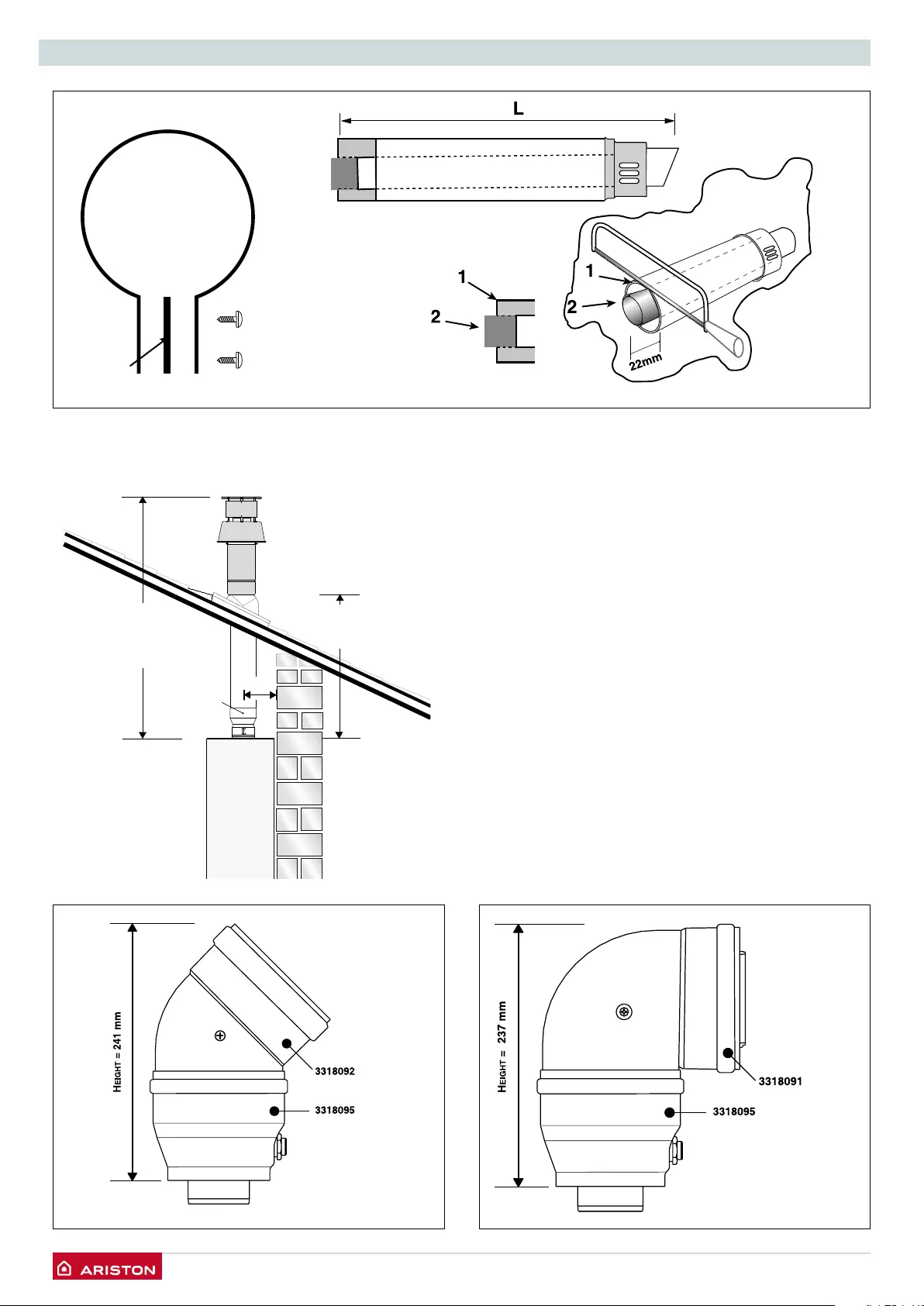
20 /
INSTALLATION INSTALLATION
Fitting the 5” Flue
(Ø 80 / 125 Horizontal/vertical) Once the boiler has been positioned on the wall, it is necessary
to insert the Ø80/125 adaptor (Fig. 5) for both horizontal and
vertical ue runs into the boiler ue socket (not supplied with
ue kit - Part No 3318095).
Push the adaptor onto the boilers ue connection, grease the
seals then add extensions or elbows as required, secure the
adaptor, using the clamp and screws provided.
To t extensions or elbows it is rst necessary to ensure that
the lip seal is tted correctly into the inner ue, once veried,
it is simply necessary to push them together, no clamps are
necessary to secure the ue components.
Before proceeding to t the ue, ensure that the maximum ue
length has not been exceeded (See the tables) and that all
elbows and bends have been taken into consideration, for each
additional 90° elbow 1 metre must be subtracted from the total
ue length, and for each 45° 0.5 metres must be subtracted from
the total ue length (the height of the vertical adaptor and a 45°
bend can be seen in Fig.6 and a 90° bend in Fig. 7).
Note: DO NOT cut the vertical ue kit.
180 mm
Total length
of Vertical Kit
1240 mm
5" Adaptor
Part no: 3318095
* This length will vary
according to the type
of ashing installed
Useable length
of Vertical ue
575 mm*
Fig. 5
Clamp
Seal
Screws
Fig. 4
Fig. 6 Fig. 7
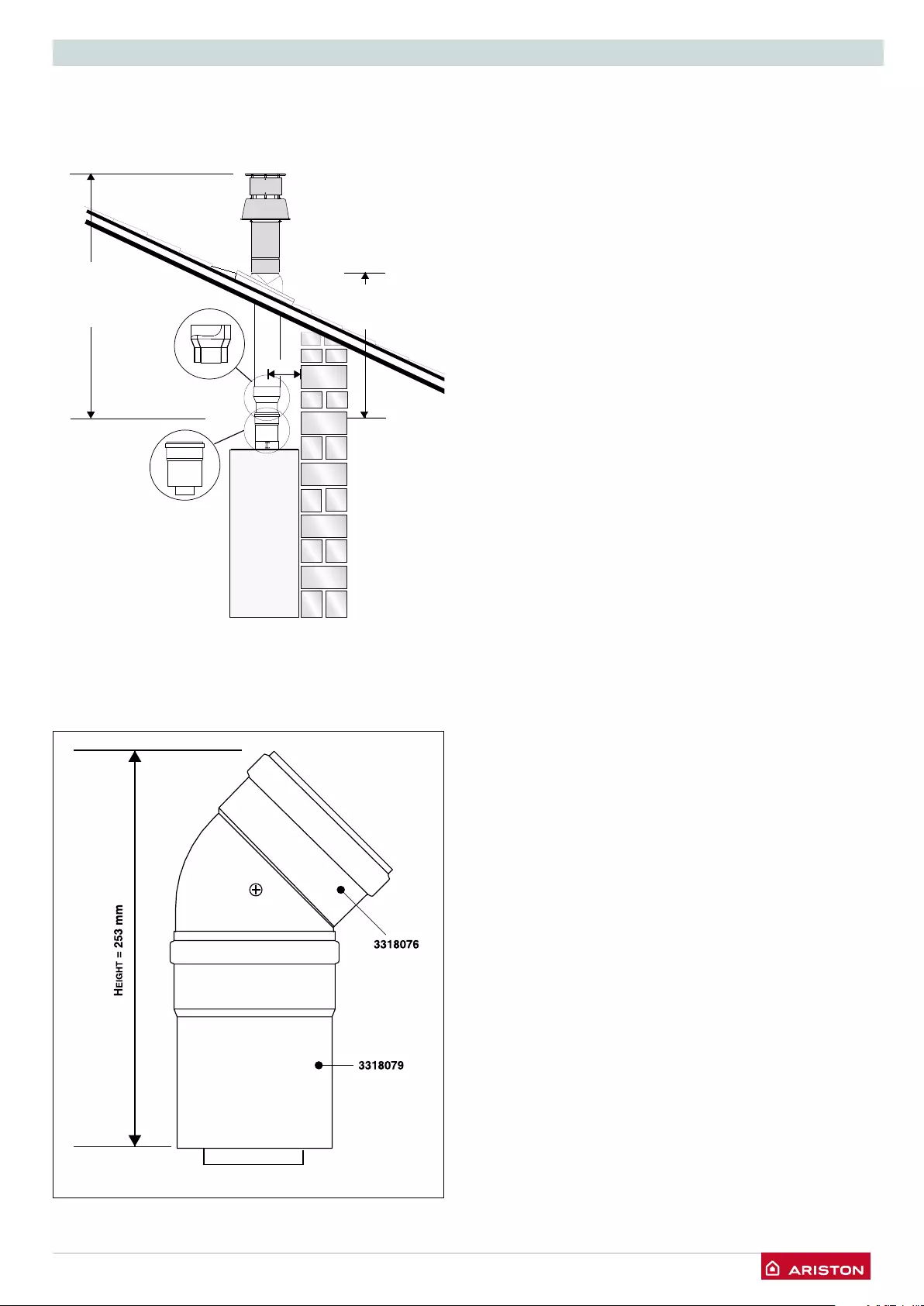
/ 21
INSTALLATION
Fitting the Coaxial Flue
(Ø 60 / 100 Vertical)
Note: See table for maximum and minimum ue runs.
Contents:
1x Conical Adaptor (60/100mm)
1x Vertical Flue Kit (80/125mm)
The vertical ue kit is supplied with a specially designed
weather proof terminal tted, it can be used either with a at
roof or a pitched roof.
The Vertical ue kits useable lengths with the pitched roof
ashings are indicated in Fig. 7.
Before proceeding to t the ue, ensure that the maximum ue
length has not been exceeded (See the tables) and that all
elbows and bends have been taken into consideration, for each
additional 90° elbow 1 metre must be subtracted from the total
ue length, and for each 45° 0.5 metres must be subtracted from
the total ue length (the height of the vertical adaptor and a 45°
bend can be seen in Fig. 8).
Mark the position of the ue hole in the ceiling and/or roof (see
Fig. 7 for distance from wall to the centre of the ue).
Cut a 130mm diameter hole through the ceiling and/or roof and
t the ashing plate to the roof.
DO NOT cut the vertical ue kit.
To connect the vertical ue kit directly to the boiler, place the
vertical starter kit (Part No. 3318079) (see Fig. 7) onto the exhaust
manifold and secure with the clamp, t the vertical adaptor onto
the vertical starter kit (note: there is no need to use a clamp to
secure this as it is a push t connection), the vertical ue kit must
then be inserted through the roof ashing, this will ensure that
the correct clearance above the roof is provided as the terminal
is a xed height.
Should extensions be required, they are available in 1 metre
(Part No. 3318077), 500mm (Part No. 3318078) and they must be
connected directly to the vertical starter kit before connecting
the adaptor to allow the vertical ue kit to be tted. In the event
that extension pieces need to be shortened, they must only be
cut at the male end and it must be ensured that the inner and
outer ue remain ush.
When utilising the vertical ue system, action must be taken
to ensure that the ue is supported adequately to prevent the
weight being transferred to the appliance ue connection by
using 1 ue bracket per extension.
When the ue passes through a ceiling or wooden oor, there
must be an air gap of 25mm between any part of the ue
system and any combustible material. The use of a ceiling
plate will facilitate this. Also when the ue passes from one
room to another a re stop must be tted to prevent the passage
of smoke or re, irrespective of the structural material through
which the ue passes.
180 mm
Vert Adaptor
(supplied with ue kit)
Vertical Starter
Part No: 3318079
* This length will vary
according to the type
of ashing installed
Total length
of Vertical Kit
1355 mm
Useable length
of Vertical ue
690 mm*
Fig. 7
Fig. 8

22 /
INSTALLATION INSTALLATION
Fitting the Twin Pipe (Ø80 / 80)
Note: See table for maximum and minimum ue runs.
Where it is not possible to terminate the ue within the distance
permitted for coaxial ues, the twin ue pipe can be used by
tting a special adaptor to the ue connector and using the
aperture for the air intake located on top of the combustion
chamber.
Always ensure that the ue is adequately supported, using one
ue bracket per extension and avoiding low points. (ARISTON
supply suitable clamps as Part No. 3318015).
To utilise the air intake it is necessary to:
1) Remove the top of the air intake by cutting it with a suitable
knife.
2) Insert the header on the tube or the elbow up until the lower
stop (you do not have to use the washer).
3) Insert the elbow/header in the boiler air intake hole and fasten
it with screws.
The twin ue pipes can be tted with or without additional elbows
and need no clamps, simply ensure that the lip seal is inserted
in the female end of the ue pipe and push the extension piece
fully into the previous section of ue pipe or elbow, check that
the lip seal is not dislodged when assembling the ue (greasing
the seal will aid assembly).
Twin pipe can also be converted back to Coaxial ue to enable
vertical termination with a coaxial kit by using the pipe bridge
(Twin - Coaxial Adaptor - Part No. 3318089). When running the
twin ue pipe vertically.
It is not possible to terminate concentrically horizontally.
Termination is only possible with separate air and exhaust
terminals.
When siting the twin ue pipe, the air intake and exhaust
terminals must terminate on the same wall, the centres of the
terminals must be a minimum of 280 mm apart and the air intake
must not be sited above the exhaust terminal (refer to Fig. 10).
The air intake pipe can be run horizontally, however, the terminal
and the nal 1 metre of ue must be installed either horizontally
or with a slight fall away from the boiler to avoid rain ingress.
It is also strongly recommended that the air intake pipe run be
constructed of insulated pipe to prevent condense forming on
the outside of the tube.
Ensure the exhaust tube has a minimum fall back to the boiler of
1˚ / metre (1˚ = 17.5mm/metre)
The maximum permissible ue length for twin ue is dependent
on the type of run used (see table on page 24).
For further information relating to ue runs not illustrated, please
contact the Technical Department on 0333 240 7777.

/ 23
INSTALLATION
For coaxial systems, the maximum development value,
mentioned in the table below also takes into account an elbow.
For twin ue systems the maximum development value,
mentioned in the table includes the exhaust gas/air intake
terminal.
Twin ue systems outlets should respect the following
instructions:
1- Use the same ø 80 mm ue pipes for the air intakes and
exhaust gas ducts.
2- If you need to insert elbows in the air intake and exhaust gas
ducts, you should consider for each one the equivalent length
to be included in the calculation of developed length.
3- The exhaust gas duct should jut above the roof by at least 0.5
m.
4- The intake and exhaust gas ducts in Type C13 + C53 must be
installed on the same wall, or where the exhaust is vertical
and the air intake horizontal, the terminals must be on the
same side of the building.
EXHAUST
AIR INTAKE
AIR INTAKE
AIR INTAKE MUST NOT BE
FITTED ABOVE THE EXHAUST
195
105
120 180
Fig. 9
Fig. 10
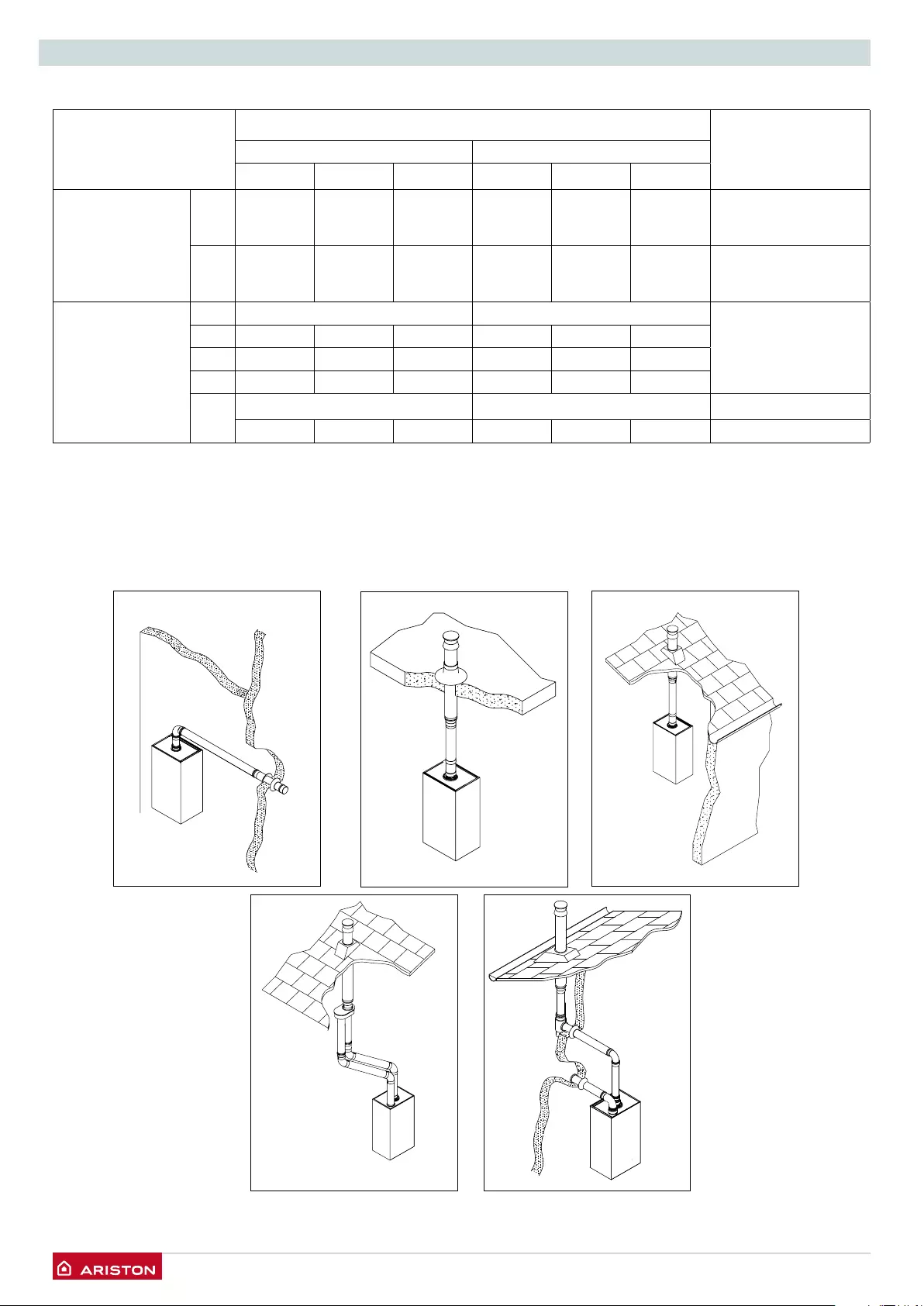
24 /
INSTALLATION INSTALLATION
Table of ue gas exhaust duct lengths
S1 = Air intake S2 = Flue gas exhaust
S1 = S2 - Air intake and ue gas exhaust equal lengths
S1 + S2 - Air intake and ue gas exhaust unequal lengths
TYPE C13
TYPE C33 TYPE C53
TYPE C33 TYPE C33
FLUE TYPE
Maximum Extension Exhaust-air (m)
Diameter of pipe
(mm)
CLAS ONE / CLAS NET ONE CLAS ONE SYSTEM
24 30 38 18 24 30
Coaxial System
C13
C33
C43
8 7 6 8 8 7 ø 60/100
C13
C33
C43
33 24 27 32 33 24 ø 80/125
Twin-pipe System
S1 = S2
ø 80/80
C13 24/24 26/26 16/16 36/36 24/24 26/26
C33 48/48 40/40 32/32 48/48 40/40 32/32
C43 24/24 26/26 16/16 36/36 24/24 26/26
C53 S1 + S2 S1 + S2
60 50 35 50 60 50 ø 80/80

/ 25
INSTALLATION
Electrical connections
For increased safety, ask a qualied technician to perform a
thorough check of the electrical system.
The manufacturer is not responsible for any damage caused by
the lack of a suitable earthing system or by the malfunctioning
of the electricity mains supply.
Make sure that the system is able to withstand the maximum
power absorbed by the boiler (this is indicated on the appliance
data plate). Check that the section of the wires is suitable and is
not less 0,75 mm2
The appliance must be connected to an efecient earthing
system if it is to operate correctly.
The power supply cable must be connected to a 230V-50Hz
network, where the L-N poles and the earth connection are all
respected.
Important!
In the event that the power supply cable must be changed,
replace it with one with the same specications.
Power supply cable
Important!
The appliance is supplied with a y-lead already
connected, this must be connected to a 240V supply fused
at 3 Amp and must facilitate completed electrical isolation of
the appliance, by use of a fused double pole isolator having a
contact separation of at least 3mm in all poles or alternatively
by means of a 3A fused three pin plug and unswitched
shuttered socket outlet both complying with BS1363.
The use of multiplugs, extension leads or adaptors is strictly
prohibited.
It is strictly forbidden to use the piping from the hydraulic,
heating and gas systems for the appliance earthing connection.
The boiler is not protected against the effects caused by
lightning. If the mains fuses need to be replaced, use 2A rapid
fuses.
Peripheral unit connection
To access peripheral unit connections carry out the following
steps:
- Disconnect the boiler from the power supply
- Remove the casing
- Rotate the control panel while pulling it forwards
- Unhook the two clips to have access to the peripherical
connections and the main P.C.B.
H05V2V2-F
60 mm
N
L
BUS
T B
FLOOR
TA2
SE TNK SOL TA1
CN1
CUBE S NET (standard for CLAS NET ONE)
WiFi Room Thermostat
SENSYS
Remote Control (option)
Outdoor
Sensor
Room Thermostat
1
(option)
OK
1234567
Peripheral connections:
BUS = Remote control connection
FLOOR/TA2 = the underoor heating thermostat or the room
thermostat 2 (selected via parameter 223)
SE = the external sensor.
SOL = Solar temperature probe
TA1 = the room thermostat 1
WARNING!
BEFORE PERFORMING ANY WORK ON
THE BOILER, FIRST DISCONNECT IT FROM
THE ELECTRICAL POWER SUPPLY USING
THE EXTERNAL BIPOLAR SWITCH AND
REMOVE THE FUSE.
BUS
T B
TA2 SE TNK SOL TA1

26 /
INSTALLATION INSTALLATION
Room Thermostat / Remote Clock Connection
To connect a room thermostat, it is necessary to:
1. Open the control panel
2. Loosen the cable clamp using a screwdriver and insert the
wires leading from the room thermostat
3. Connect the wires to the terminals as indicated in the gure
below, removing the link
4. If a remote time clock is to be tted, using a volt free switching
time clock connect the switching wires from the time clock
following points 1 - 3 above
5. If using an external time clock and room thermostat, these
must be connected in series as shown in diagram C,
6. Ensure that they are well connected and not subject to stress
when the control panel is closed
DO NOT CONNECT 240V TO ANY PERIPHERAL CONNECTIONS
Outdoor sensor connection
- Introduce the outdoor sensor wires
- Loosen the cable clamp using a screwdriver and insert the
wires leading from the outdoor sensor one at a time.
- Connect the wires to the terminals as indicated in the gure
below;
- Make sure that they are well connected and that they are
not subject to stress when the control panel lid is opened or
closed;
- Close the ap again, then replace the control panel cover
and the front casing.
- Refer to page 40 for setting the parameters when using the
outdoor sensor.
Note: wheN coNNectiNg the boiler to exterNal coNtrols, do
Not ruN 240V cables aNd cables for switchiNg circuits
(which are low Voltage) together, use seperate cables to
preVeNt iNduced Voltage oN the low Voltage circuits.
Connector SE on PCB
Outdoor Sensor
Connector TA on PCB
(low voltage switching)
Connector TA on PCB
(low voltage switching)
Connector TA on PCB
(low voltage switching)
Cylinder connection (CLAS SYSTEM ONE)
The boiler can be connected to a central heating system
that uses two zone valves to allow connection to an indirect
storage cylinder.
There are two wiring diagrams shown, one for the connection
to an Unvented Cylinder and one for connection to an open
vented cylinder.
In both cases the boiler connection is shown as TA1.
When connecting the boiler to an external cylinder do not run
240V cables and the cables for the TA1 together, use separate
cables to prevent induced voltage on the low voltage
switching circuit.
Note: the use of a ‘y’ plaN system is Not possible with the
clas system oNe boiler due to the low Voltage switchiNg of
the appliaNce uNless suitable relay coNtrols are used.
Important!!
Ensure that a balancing valve is tted on the cylinder return
and balanced correctly at commissioning stage.
(see p.25)

/ 27
INSTALLATION
Fitting instructions for:
• Internal mechanical time clock
• Internal RF receiver for Ariston programmable
room thermostat
These instructions to be used in conjunction with the appliance
installation instructions. Ensure the appliance is electrically
isolated before working on the appliance.
Remove the outer casing, and remove the front control panel by
removing the 2 securing screws.
Remove the clock blanking plate (or existing clock if tting the
RF receiver in a product with an existing mechanical clock) from
the front control panel of the boiler.
Using the 4 securing screws supplied with the clock accessory,
secure the clock/RF receiver into position, ensuring the
accessory is oriented correctly.
Connect the wires to the clock accessory using the spade
connectors (see g. 1 for wiring conguration)
Fig. 1
Reassemble appliance, turn on electrical supply and operate
accessory using instructions supplied.
1 Ground (Blue)
2 24 V (Black)
3 CH 1 (Brown)
4 NOT USED
Rear view of
Time clock
Accessory
Rear view of
Time clock
Accessory
1
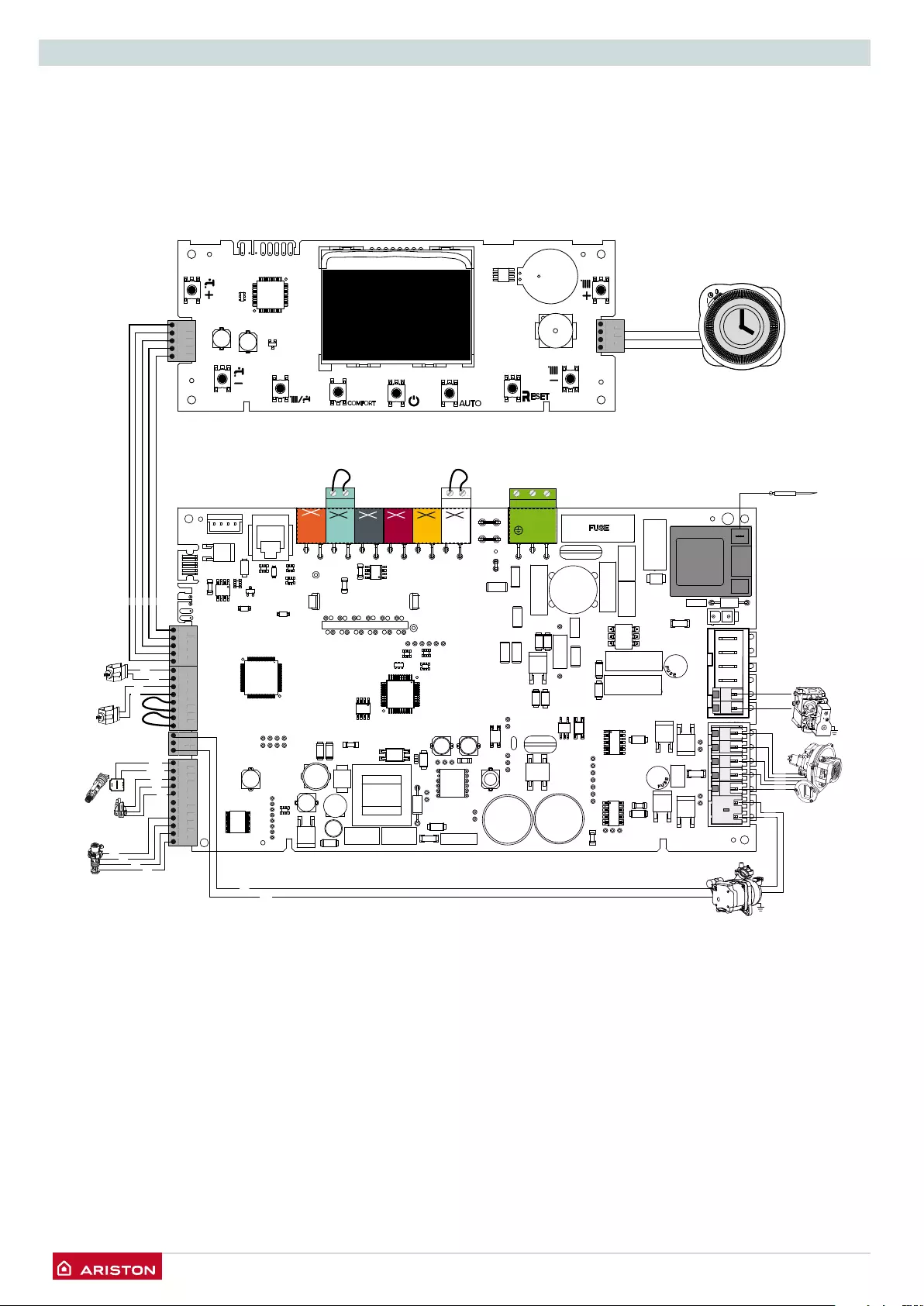
28 /
INSTALLATION INSTALLATION
Electrical diagram
For increased safety, ask a qualied technician to perform a
thorough check of the electrical system.
The manufacturer is not responsible for any damage caused by
the lack of a suitable earthing system or by the malfunctioning
of the electricity mains supply.
CLAS ONE
CLAS NET ONE
N L
NL
BUS
T B
FLOOR
TA2
230 V
SE TNK SOL TA1
230 V 230 V 230 V 230 V 230 V
Bk
Bk
Gry
Bk
Bl
Br
Bk
Bl
Rd
Wh
Br
Bl
Rd
Bl Bl
Rd
Br Bk
D.H.W.
flow switch
Switch ON/OFF
Diverter valve
C.H. return
temperature
probe
C.H. flow
temperature
probe
Detection/Ignition
electrode
GAS VALVE
Modulating
fan
Modulating circulation
pump

/ 29
INSTALLATION
CLAS SYSTEM ONE
N L
NL
BUS
T B
FLOOR
TA2
230 V
SE TNK SOL TA1
230 V 230 V 230 V 230 V 230 V
Bk
Bk
Bl
Br
Bl
Rd
Bl Bl
Rd
Br Bk
Switch ON/OFF
C.H. return
temperature
probe
C.H. flow
temperature
probe
Detection/Ignition
electrode
GAS VALVE
Modulating
fan
Modulating circulation
pump

30 /
INSTALLATION INSTALLATION
Earths omitted for clarity
R/STAT
REMOTE 2 CHANNEL PROGRAMMER
TERMINAL
STRIP
C/H
2 PORT VALVE
240V
3AMP
L
N
E
L N
Remove
Link
CYL STAT
ON OFF
L
N
H/W
2 PORT
VALVE
Boiler
HW CH
BUS TA2 SE TNK SOL TA1
Note:
Boiler switching on TA1 is low voltage,
use a seperate cable to supply TA1.
Do not use 5 core cable.
MOTOR N
LMOTOR
ON OFF
S plan wiring diagram.
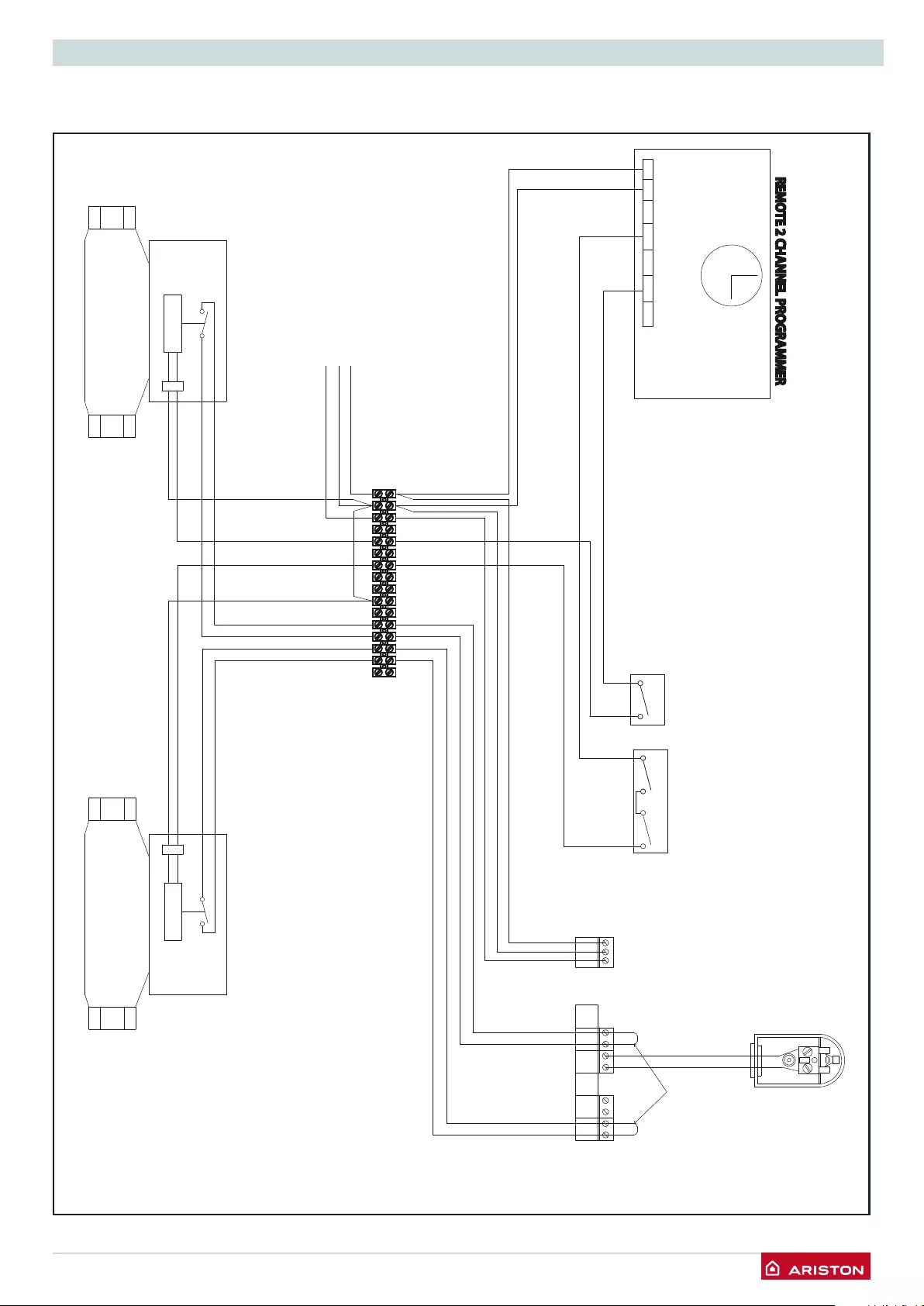
/ 31
INSTALLATION
Earths omitted for clarity
R/STAT
REMOTE 2 CHANNEL PROGRAMMER
TERMINAL
STRIP
C/H
2 PORT VALVE
240V
3AMP
L
N
E
L N
Remove
Links
CYL STAT
ON OFF
L
N
H/W
2 PORT
VALVE
Outside sensor
Boiler
Change parameter:
223 from 0 to 1
521 from 1 to 3
421 from 1 to 0
Activate Auto Function
BUS TA2 SE TNK SOL TA1
Note: Boiler switching on TA1 & TA2 is low
voltage. Use a separate cable to supply TA1 &
TA2. Do not mix high voltage and low voltage
wires in the same cable.
MOTOR N
LMOTOR
ON OFF
S plan wiring diagram using an outside sensor.

32 /
COMMISSIONING
Initial preparation
Ariston Thermo UK Ltd support the benchmark initiative.
On pages 77 and 78 of this manual the Benchmark
Commissioning Checklist and Service interval Record can be
found. It is important that this is completed in the presence of
your customer, they are shown how to use it, and it is signed by
them. Please instruct your customer that they must have this
manual with them whenever they contact a service engineer
or us.
Preliminary electrical system checks to ensure electrical safety
must be carried out by a competent person i.e. polarity, earth
continuity, resistance to earth and short circuit.
Electricity supply
- Check that the voltage and frequency of the electricity supply
correspond to the data shown on the boiler data plate;
- Make sure that the earthing connection is efcient.
Filling the Heating System:
ATTENTION!!
CONNECT THE PIPE OF CONDENSATE DISCHARGE
BEFORE REFILLING AND THE DE-AERATION OF THE
HEATING CIRCUIT.
Remove the front casing panel and lower the control panel as
described on page 15.
Open the central heating flow and return cocks supplied with
the connection kit;
Open the manual air vent positioned at the side of the primary
exchanger (2). The valve is already connected to a discharge
pipe related to the condensate trap.
Close all air release valves on the central heating system;
Gradually open the valves at the filling point (filling loop) until
water is heard to flow, do not open fully;
Open each air release tap starting with the lowest point and
close them only when clear water free of air is visible;
Continue filling the system until at least 1.5 bar registers on the
pressure gauge;
Inspect the system for water tightness and remedy any leaks
discovered.
importaNt!
maNually VeNt the heat exchaNger at the maNual air VeNt. failure
to VeNt adequately may damage the heat exchaNger (page 9, legeNd
2).
Filling of the DHW System:
Close all hot water draw off taps;
Open the cold water inlet cock supplied with the connection kit;
Slowly open each draw off tap and close them only when clear
water, free of bubbles, is visible.
Gas Supply:
Inspect the entire installation including the gas meter and test
for tightness. The entire installation should be in accordance
with the relevant standards. In GB this is BS 6891 and in IE this
is the current edition of I.S.813.
The connection on the the appliance is a 15mm (22mm on
38Kw) nut and olive located at the rear of the gas service cock.
If the gas supply serves other appliances, ensure that an
adequate supply is available both to the boiler and the other
appliances when they are in use at the same time.
Pipe work must be of an adequate size. The final pipe size
must not be smaller than the appliance inlet size.
Open the gas cock (supplied with the connection kit) to the
appliance and check the gas connection on the appliance for
leaks.
Water Treatment:
The boiler is equipped with a stainless steel heat exchanger.
The detailed recommendations for water treatment are given
in BS 7593 (Treatment of water in domestic hot water central
heating systems); the following notes are given for general
guidance;
If the boiler is installed on an existing system, any unsuitable
additives must be removed;
Under no circumstances should the boiler be fired before the
system has been thoroughly flushed; the flushing procedure
must be in line with BS7593.
Firstly fill the central heating system with the power off, and
flush through cold, fill the central heating system again, adding
a flushing detergent, run the boiler on central heating until it
reaches its operating temperature and flush the system, refill
the system with a suitable corrosion inhibitor,
Note: Failure to carry out the FlushiNg procedure will result iN the
warraNty becomiNg void.
2

/ 33
COMMISSIONING
FIRST IGNITION OPERATION
1. Check the electrical
supply.
Complete ...............................................................................
Date . . . . . . . . . . . . . . . . . . . . . . . .
Installer . . . . . . . . . . . . . . . . . . . . .
2. Check the type of gas
and change the gas if
necessary.
Complete ...............................................................................
3. Check the gas tightness.
Complete . . . . . . . . . . . . . . . .
4. Measure the gas inlet.
Complete . . . . . . . . . . . . . . . .
5. Check the Flue
Complete . . . . . . . . . . . . . . . .
6. Fill the installation.
Complete . . . . . . . . . . . . . . . .
7. Check the hydraulic water
tightness.
Complete . . . . . . . . . . . . . . . .
8. Ensure the pump is
operating.
Complete . . . . . . . . . . . . . . . .
9. Purge the air with once
pressing on ESC button
during 5 sec.
Complete . . . . . . . . . . . . . . . .
10. Set the heating power.
Complete . . . . . . . . . . . . . . . . . . . . . . . . . . . . . . . . . . . .
11. Balance the central
heating circuit.
Complete . . . . . . . . . . . . . . . .
12. Check the operation in
DHW mode.
Complete . . . . . . . . . . . . . . . .
13. Adjust DHW ow rate on
the boiler (if necessary).
Complete . . . . . . . . . . . . . . . .
15. Check gas rate.
Complete . . . . . . . . . . . . . . . .
14. Check combustion by
pressing the RESET button
for 5 sec.
Complete . . . . . . . . . . . . . . . .
16. Check the ionisation
current.
Complete . . . . . . . . . . . . . . . .
17. Explain to the end user
the working of the boiler.
Complete . . . . . . . . . . . . . . . .
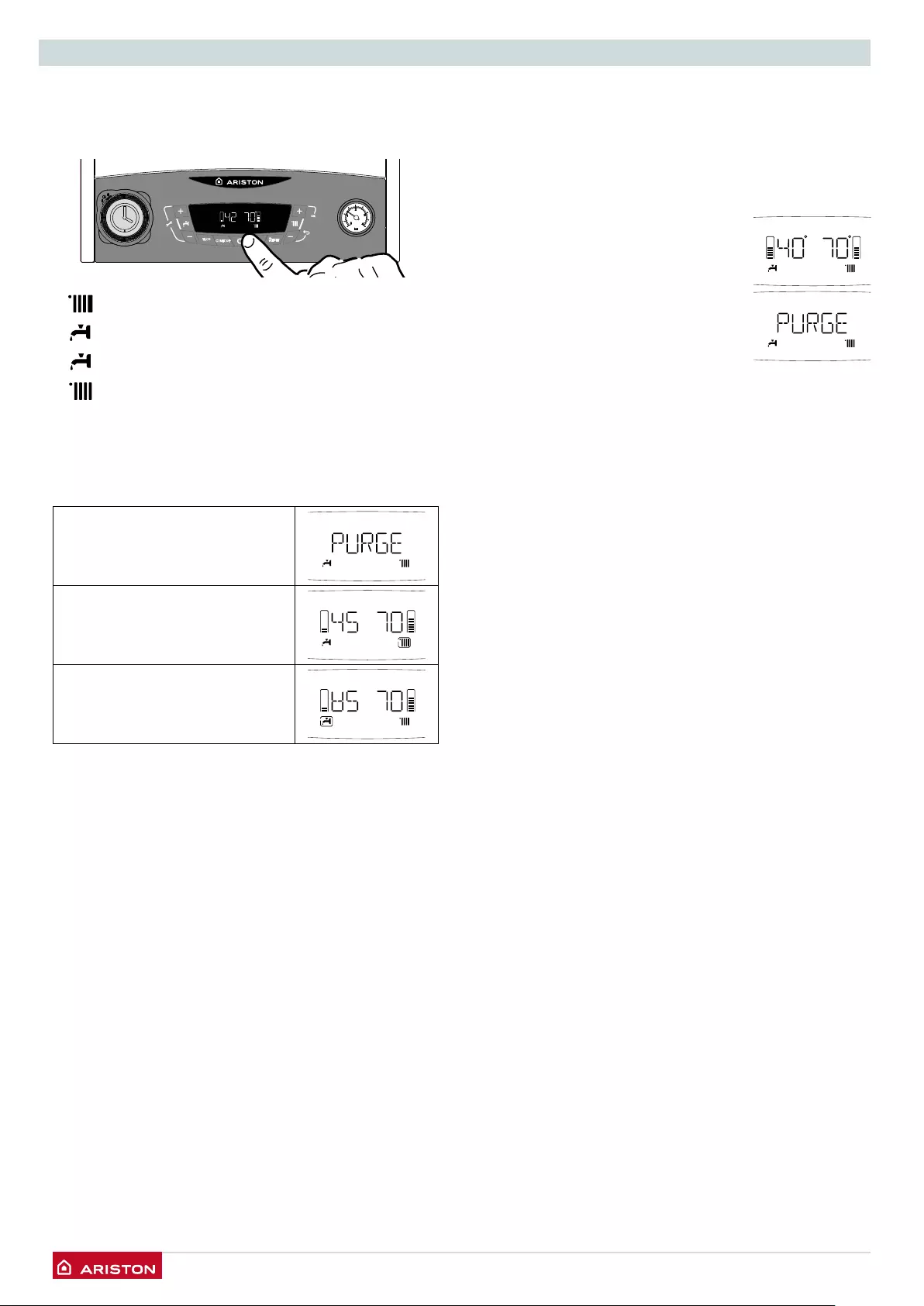
34 /
COMMISSIONING
Ignition procedure
Press the ON/OFF button on the control panel to switch on the
boiler. The display shows:
● the operating mode:
winter
summer
Only heating - CLAS SYSTEM ONE
● The gures indicate:
-
the ow temperature when no heating requests have been made
- the ow temperature in central heating mode
-
the temperature of the hot water set in domestic hot water
The carrying out of certain functions is shown:
Deaeration cycle started
Centrl Heating Post-circulation
D.H.W. circuit Post-circulation
Electricity supply
- Check that the voltage and frequency of the electricity supply
correspond to the data shown on the boiler data plate;
- Make sure that the earthing connection is efcient.
First ignition
1. Make sure that:
- The gas valve is closed;
- The electrical connection has been properly carried out.
Make sure that, in any case, the green/yellow earthing wire
is connected to an efcient earthing system;
- Use a screwdriver to lift the cap on the automatic air relief
valve;
- Switch on the boiler (by pressing the ON/
OFF button) and use the mode button to
select the standby mode, where no hot
water or heating requests are made.
- Start the deaeration cycle by pressing
mode for 5 seconds
The boiler will start a deaeration cycle
lasting about 7 minutes (See below). If
you need to stop it press mode. During the deaeration cycle
open the manual air vent (2) on the heat exchanger and
close when clear water free of air is visible.
- At the end, check that the system is completely deaerated
and, if not, repeat the procedure.
- Bleed the air from the radiators;
- The exhaust duct for combustion products should be suitable
and free from any obstructions;
- Any necessary ventilation inlets in the room should be open
(type B installation).
- Check whether the condense trap contains water; if not, it
must be relled. If necessary, open the manual air vent on
the main exchanger until complete lling.
N.B.: if the boiler will not be used for long periods, the
trap should be lled before the boiler is started up again.
It is dangerous not to rell the siphon as fumes may be
released into the environment.
2. Open the gas cock and check the connection seals, including
the boiler connection joints, making sure that the meter does
not detect any passage of gas. Eliminate any leaks.
3. Start the boiler by selecting the heating or domestic hot
water operation using the mode button.
Description of Function
Deaeration cycle
During the lling stage or if there is excess air in the system,
the deaeration cycle can be activated by holding the mode
button for 5 seconds. The boiler will start a cycle which lasts
approximately 7 minutes. When this is complete the menu screen
will be restored. The cycle may either be repeated, if necessary,
or stopped by pressing mode. Press the mode button until the
normal display screen is restored. if the cycle is stopped be sure to
maNually VeNt the appliaNce.

/ 35
COMMISSIONING
Combustion checking procedure
The order of operations for this procedure must always be
respected.
Refer to Technical Bulletin 143 on Gas Safe Register website for
further information on combustion analysis of domestic boilers.
Operation 1 - Supply pressure check
Loosen the screw 1 and insert the pressure gauge connection
pipe into the pipe tap.
Switch the boiler on at maximum power.
To activate combustion test function:
- Press the mode selector to ensure the icons displayed.
- Press & hold the reset button for 10 seconds. ‘ ’ will
appear on the screen. Ensure the boiler is on max power by
pressing the button 2 .
The supply pressure should correspond to the value established
in relation to the type of gas ,for which the boiler is designed see
Table summarising changes.
Note:
The absolute minimum working pressure measured at the inlet
test nipple on the gas valve is 17.5 mbar.
Operation 2 - Preparing the measuring equipment
Connect the calibrated ue gas analyser to the left-hand
combustion outlet by unscrewing the screw and removing the
blanking cover.
Operation 3 - Adjusting the CO2 at maximum gas ow rate
(domestic hot water)
Draw off the domestic hot water at the maximum water ow rate
(if a combi).
Select the Test function by pressing the
RESET button for 10 seconds.
WARNING! When the cleaning function is activated, the
temperature of the water coming out of the boiler may be
more than 65°C.
On the display appear and the icon
. The boiler is foced to the maximum
heating power.
Press the 2 button to forced the boiler at
the maximum DHW power. On the display
appear the icon .
Wait 1 minute for the boiler to stabilise before
carrying out the combustion analyses.
Read the CO2 value (%) and compare it with the values given in
the table below
N.B.: VALUES WITH THE CASING CLOSED.
If the CO2 value (%) read differs from the values given in the
table, then adjust the gas valve following the instructions below,
otherwise move directly onto operation 4.
Adjusting the gas valve at maximum gas ow
Adjust the gas valve by turning setting screw 4 clockwise in
increments to reduce the CO2 level (a 1 turn adjusts the CO2
level by approximately 0.2%). Wait 1 minute after each change in
setting for the CO2 value to stabilise.
If the value measured corresponds to the value given in the
table, max adjustment is complete, otherwise start the setting
procedure again.
N.B. The Test function is automatically deactivated after 10
minutes or manually by briey pressing the RESET button.
Operation 4 - Checking the CO2 at minimum gas ow
With the Test function active, press the 2
button to select the icom and
. The boiler is forced to the minimum power.
Wait 1 minute for the boiler to stabilise before
carrying out the combustion analyses.
If the CO2 value (%) read differs by 0.5 %
from the value found, then adjust the gas valve following the
instructions below, otherwise move directly onto operation 5.
Adjusting the gas valve to minimum gas ow
Remove cap and adjust screw 2 by turning anti-clockwise in
increments to reduce the CO2 level. Wait 1 minute after each
adjustment for the CO2 value to stabilise.
WARNING! this adjustment is sensitive: a rotation of a 1 turn
corresponds to 0.2% of CO2.
1 32 4
2
4
1
CLAS NET ONE 24 / 30 /38
CLAS ONE 24 / 30 / 38
CLAS SYSTEM ONE 18 / 24 / 30
Gas CO
2
(%) MAX CO
2
(%) MIN
G20 8,7% ÷ 9,7% 8,4% ÷ 9,4%
G31 9,5% ÷ 10,5%
ATTENTION! CO
2
max – CO
2
min > 0,5%
1 32 4
4
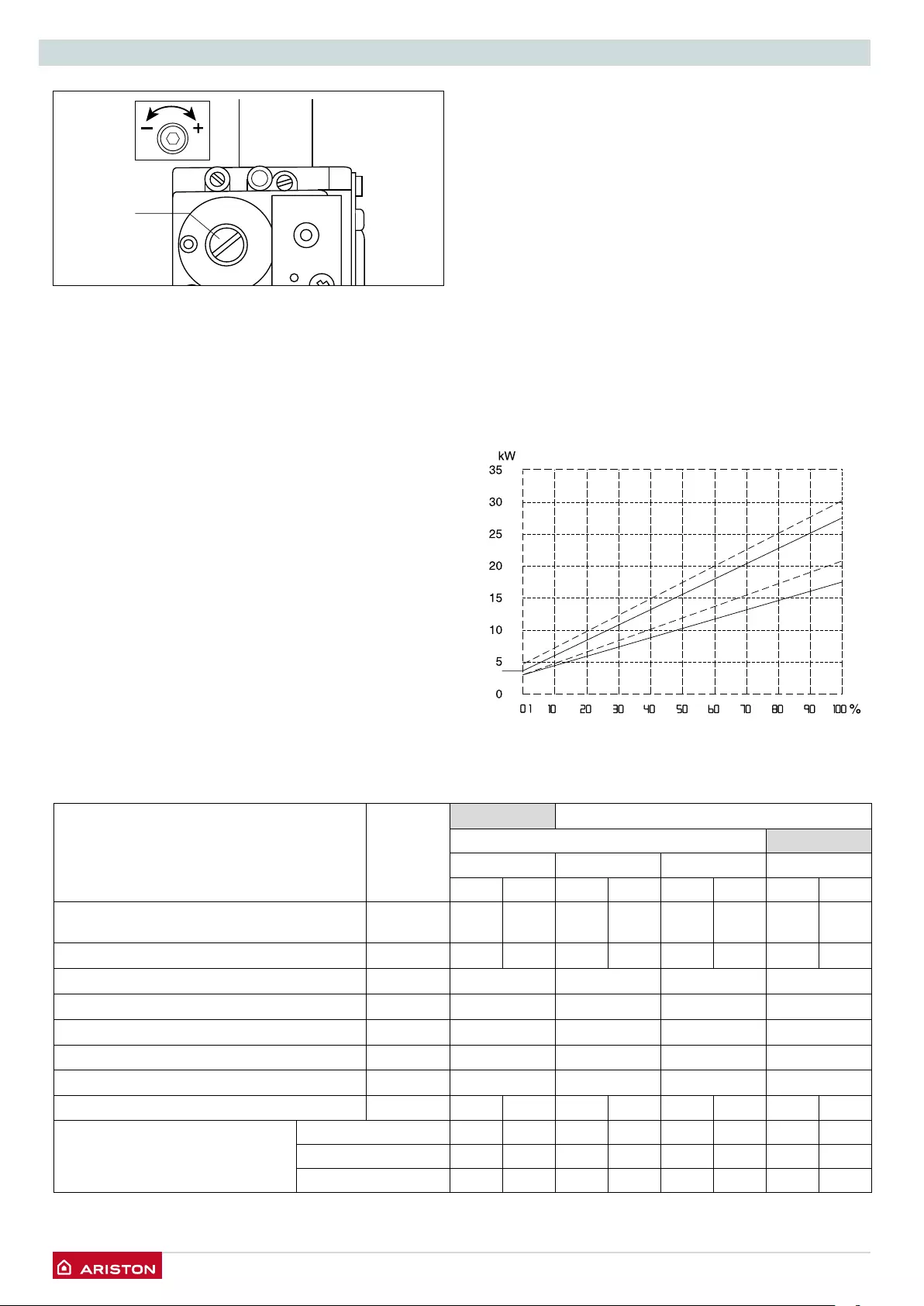
36 /
COMMISSIONING
If the value measured corresponds to the value given in the
table, adjustment is complete, otherwise start the setting
procedure again.
Attention! If the value of the CO2 at the minum power has
been changed, it is necessary repet the adjusting at maximum
gas ow.
Operation 5 - Ending the adjustment
Exit cleaning mode by pressing RESET.
Stop the draw-off.
Verify and repair any leaks of gas.
Ret the front panel to the device.
Ret the blanking cover at combustion test point.
menu 2 - Boiler parameters
submenu 3 - parameter 1 Maximum Heating Power adjustment
submenu 2 - parameter 0
Soft light Ignition
submenu 3 - parameter 5 Heating ignition delay
Maximum Heating Power adjustment
The maximum heating power can be adjusted to between the
maximum power allowed by the boiler and the minimum power).
The display shows the value between 100% (“100” on the
display) and 0% (“0”) of this interval.
To check the maximum heating power, access menu 2/sub menu
3/parameter 1, check the value and, if necessary, modify it as
indicated in the Gas Regulation table below. (See page 40 for
more details).
Checking slow ignition power
The soft light can be adjusted between the maximum power
(shown on the display as “100”, i.e. 100%) and the minimum
power (shown on the display as “1”, i.e. 1%).
To check the slow ignition power, access menu 2/sub menu 2/
parameter 0.
Heating ignition delay adjustment
This parameter – menu 2/sub menu 3/parameter 5 - can be used
to manually (0) or automatically (1) set the delay time before the
subsequent reignition of the burner after it has switched off on
reaching the desired temperature in central heating mode.
By selecting manual, it is possible to set the delay in minutes
using the successive parameter (menu 2/sub menu 3/parameter
6), to a time between 0 and 7 minutes.
Automatic selection means that the boiler will establish the
delay time based on the set-point temperature
30,2
27,4
17,6
21,4
3,4
3,9
4,7
CLAS ONE / CLAS NET ONE / SYSTEM 30
CLAS ONE / CLAS NET ONE /SYSTEM 35
CLAS ONE SYSTEM 18
CLAS ONE / CLAS NET ONE / SYSTEM 24
1 32 4
2
Table summarising changes
parameter
CLAS NET ONE / CLAS ONE
CLAS SYSTEM ONE
18 24 30 38
G20 G31 G20 G31 G20 G31 G20 G31
Lower Wobbe index (15°C, 1013 mbar)
( MJ/m3)45,67 70,69 45,67 70,69 45,67 70,69 45,67 70,69
Inlet Gas pressure 20 30-37 20 30-37 20 30-37 20 30-37
Slow ignition 220 98 64 62 62
Maximum C. H.power Adjustable (%) 231 60 56 60 60
Minimum power (%) 233 3 3 3 5
Max CH power (%) 234 60 75 84 85
Max DHW power (%) 232 60 90 90 100
Gas diaphragm ((Ø) mm 5,0 (*) 3,6 5,0 (*) 3,6 5,8 (*) 4,0 6,8 (*) 4,7
Gas ow max/min
(15°C, 1013 mbar)
(nat - m3/h) GPL - kg/h)
max D.H.W 1,905 1,398 2,751 2,020 3,175 2,330 4,02 2,95
max C.H 1,905 1,398 2,328 1,709 2,963 2,175 3,28 2,41
min 0,391 0,287 0,391 0,287 0,455 0,334 0,5 0,43
(*) Gas diaphragm integrated in the air/gas mixer
(NON-REMOVABLE)

/ 37
COMMISSIONING
ON
OFF
1
2
5
6
l
FR
Dans le cas d’une dureté de l’eau
supérieure à 20 °f, prévoir un traitement de
’eau.
NL
Bij waterhardheid van meer dan 20
°f, een waterverzachter voorzien.
DE
Wenn
der Härtegrad des Wasser über 11°dH (20 °f)
beträgt, ist eine Wasserenthärtung
vorzusehen.
IT
Se l’acqua ha una durezza
superiore a 20 °f, prevedere un dispositivo di
trattamento.
ES
En el caso de que la dureza
del agua sea superior a 20 °f, prever un
tratamiento del agua.
PT
Nos casos em que a
dureza da água seja superior a 20 °f, prever
um sistema de tratamento de água.
UK
If the
water hardness is more than 20 °f, install a
water softener.
CZ
V prípade, ze tvrdost vody
presahuje 20 °f, je treba aplikovat vhodnou
úpravnu vody.
HU
Ha a víz keménysége
nagyobb, mint 20°f német keménységi fok,
akkor a víz kezelésér l gondoskodni kell.
PL
twar wody jest w
nale y zainstalow owiednie ur zenie.
TR
20 °f su sertli ini geçen sular için su
ar
ıtma tavsiye edilmelidir (su arıtma
teriye aittir).
RO
Daca apa are o duritate
ma
i m
are dacat 20 °f, este necesara tratarea in
ea
labi
l a acesteia.
RU
.
XXXX
xxxxx
xxxxx
xxx
XXXX
xxx
MIN
Q
MAX
P
60/80°C
G30 - G31 28/37 mbar
1009942-05
5
4
2
1
3
Converting the appliance from Natural gas to LPG
These appliances are designed to operate with different gas
types.
The appliance must only be converted for use with a different
gas type by a Gas Safe Registered installer.
To convert the appliance to LPG:
(use these instructions in conjunction with the Instruction sheet
supplied with the LPG Kit).
1.
Electrically isolate the appliance (g 1)
2. Turn off the gas supply (g 2)
3. Remove the outer case, lower the
front control panel.
4. Remove the silencer (g 3)
5. Disconnect the gas supply from
the venturi assembly (g 4)
6. Inset the correct diaphragm
(depending on the output of the
appliance) into the venturi spigot
(g 5)
7. Reassemble the gas supply onto the venture assembly (g 4)
and reattach the silencer.
8. Turn on gas supply and test for tightness
9. Purge gas supply
10. Turn the electrical supply on to the appliance.
11. Commission the appliance, check the working pressure is
adequate then test and adjust the CO² values at maximum
and minimum output described in the commissioning section
of the appliance installation instructions. Ensure the ue
gas analyser used is calibrated and set for the gas group
the appliance is being
adjusted for.
12. Check the appliance
for gas leaks using
gas leak detection
uid.
13. Afx the label to
the appliance that
is supplied with the
conversion kit.
AUTO function
This is a function which enables the boiler to automatically
adapt its operation routine (the temperature of the heating
elements) in line with the outdoor conditions, in order to achieve
and maintain the requested room temperature conditions.
Depending on the peripheral units connected and the number
of zones controlled, the boiler adjusts its ow temperature
automatically.
The various
corresponding
parameters should
therefore be set (see
adjustments menu).
To activate the function,
press the auto button.
Example 1:
Single zone system (high-temperature) with on/off room
Thermostat:
In this case the following parameters must be set:
4 21 - Activation of temperature adjustment using sensors
- Select 1 = Basic temperature adjustment
2 44 - Boost Time (optional)
The wait time for the ow temperature increase in steps of
4°C may be set. The value varies according to the type of
system and installation.
If the Boost Time value = 00 the function is not activated.
Example 2:
Single zone system (high-temperature) with on/off room
Thermostat + outdoor sensor:
In this case the following parameters must be set:
4 21 - Activation of temperature adjustment using sensors
- Select 3 = outdoor sensor only
4 22 - Temperature adjustment curve selection
- Select the relevant curve according to the type of
system, installation, heat insulation used in the building,
etc.
4 23 - Perform a parallel curve shift if necessary, increasing
or decreasing the set-point temperature (this may also
be modied by the user, using the heating temperature
adjustment knob, which, with the Auto function activated,
is used to shift the curve in a parallel manner).
Example 3:
Single zone system (high-temperature) with Sensys controller +
outdoor sensor
In this case the following parameters must be set:
4 21 - Activation of temperature adjustment using sensors
- select 4 = outdoor sensor + room sensor
4 22 - Temperature adjustment curve selection
- Select the relevant curve according to the type of
system, installation, heat insulation used in the building,
etc
4 23 - Perform a parallel curve shift if necessary, increasing or
decreasing the set-point temperature. (This may also be
changed by the user by the buttons 8 which, with the
Auto function activated, is used to shift the curve in a
parallel manner.)
4 24 - Inuence of room sensor
- used to adjust the inuence the room temperature has
on the calculation of the set-point ow temperature (20 =
maximum, 0 = minimum).
Note: See page 40 for details on accessing menus.

38 /
BOILER PROTECTION DEVICES
Boiler protection devices
The boiler is protected from malfunctioning by means of internal
checks performed by the electronic microprocessor P.C.B., which
stops the boiler from operating if necessary.
In the event of the boiler being shut off in this manner, a code
appears on the display which refers to the type of shut-off and
the reason behind it.
There are two types of shut-off:
Safety shut-off
This type of error is “volatile”, which means
that the boiler starts up again automati-
cally as soon as the problem which caused
the shut-off is removed; the error is indicat-
ed by the « » symbol which appears
on the display and the error code.
In fact, soon as the cause of the shut-off
disappears, the boiler starts up again and
continues to operate normally.
In the event of error 108 - Shut-off due to insufcient water
pressure inside the heating circuit - the boiler will perform a
safety shut-off.
You can increase the pressure by lling the
heating circuit.
In this case or if the re-balancing request is
performed on a frequent basis, switch the
boiler off, turn the external electric switch to
the OFF position, shut off the gas cock and
contact a qualied technician to check for
any leaks of water.
Shutdown
This type of error is “non-volatile”, which means that it is not
removed automatically. To restore normal operation press the
button on the control panel.
Important
If this shutdown occurs frequently, contact an authorised
Technical Service Centre for assistance. For safety reasons, the
boiler will permit a maximum of 5 resets in 15 minutes (5 presses
of the RESET button); at the 6th attempt within this 15-minute
period the boiler will shut down and may only be operated
again after the electricity supply has been disconnected. If
the shutdown is occasional or an isolated event, this is not a
problem.
Malfunction warning
This warning is shown by the display in the following format:
5 P1 = FIRST IGNITION ATTEMPT UNSUCCESSFUL
the rst gure indicating the operational assembly is followed
by a P (warning) and the code relating to the specic warning.
The rst gure of the error code (e.g. 1 01) indicates within which
operational assembly the error occurred.
1 - Primary Circuit
2 - Domestic Hot Water Circuit
3 - Internal Electronic Part
4 - External Electronic Part
5 - Ignition and Detection
6 - Air inlet - ue gas outlet
7 - Multi-zone Heating
Table summarising error codes
Central Heating circuit
Display Description
1 01 Overheat
1 03
Insufcient circulation
1 04
1 05
1 06
1 07
1 08 Insufcient water (request lling)
1 09 System pressure > 3 bar
1 10
C.H. Flow temp. probe circuit open / short circuit
1 12 C.H. Return temp. probe circuit open / short circuit
1 14 External sensor circuit open / short circuit
1 16 Floor Thermostat contact open
1 18 Heating delivery probe problem
1 P1
Insufcient circulation indication
1 P2
1 P3
1 P4
D.H.W. circuit
2 05
DHW In Probe Open Circuit (Solare temp. probe)
Internal P.C.B.’s
3 01 EEPROM error
3 02 Comunication error
3 03 Main P.C.B. error
3 04 Too many (> 5) resets in 15 minutes
3 05
Main P.C.B. error
3 06
Main P.C.B. error
3 07 Main P.C.B. error
3 P9 Sched.Maintanace-Call Service
External P.C.B.’s
4 11 Room sensor circuit open or short circuit Zone 1
4 12 Room sensor circuit open or short circuit Zone 2
4 13 Room sensor circuit open or short circuit Zone 3
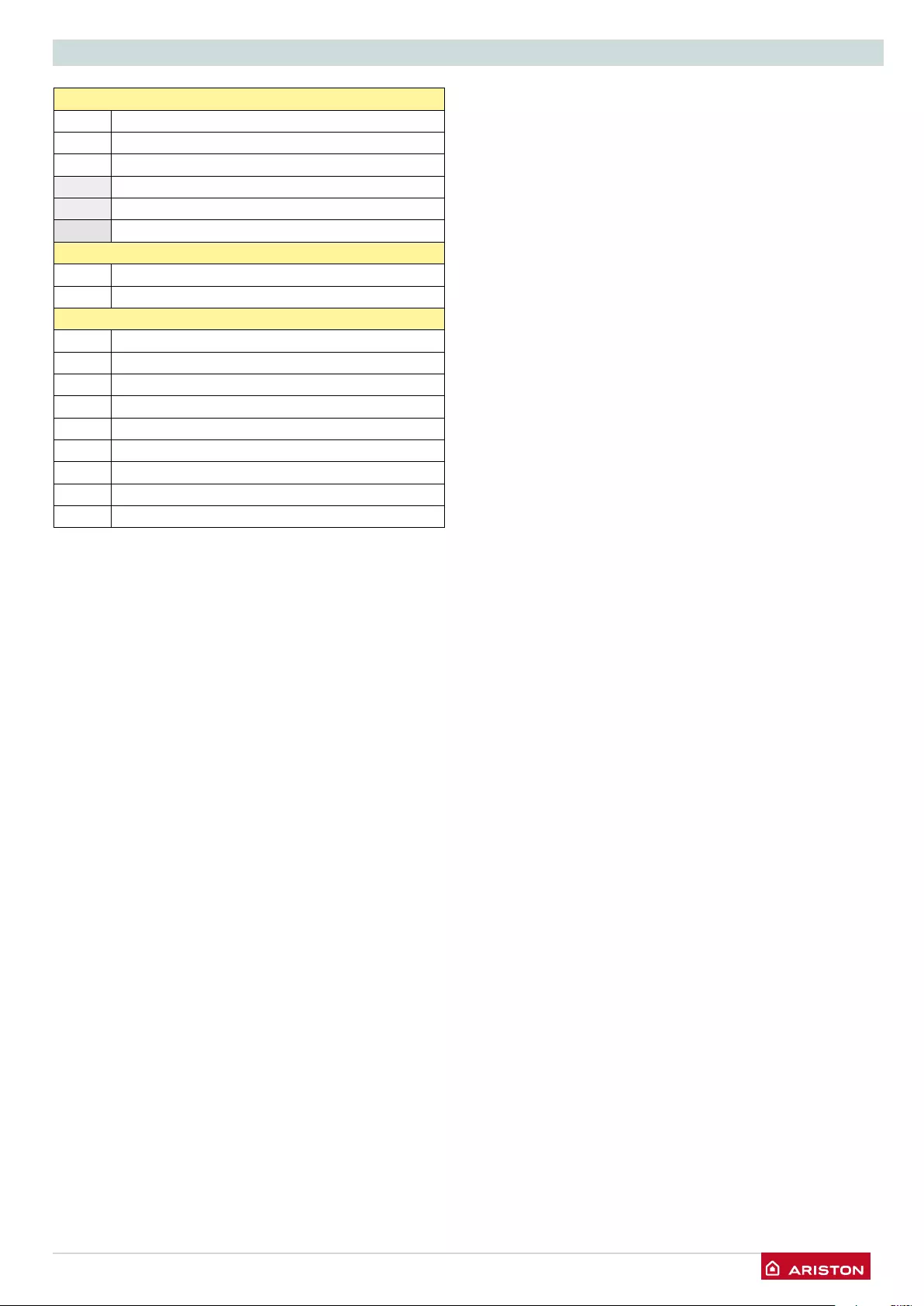
/ 39
BOILER PROTECTION DEVICES
Anti-frost Device.
The anti-frost function acts on the central heating ow tempe-
rature probe, independently from other regulations, when the
electrical supply is turned on.
If the primary circuit temperature is between 3°C and 8°C the
pump will run (with the diverter valve switching between cen-
tral heating and hot water every 1 minute) until the temperature
reaches > 9°C.
If the ow temperature remains between 3°C and 8°C the pump
will continue to run for a maximum of 20 minutes unless a tem-
perature above > 9°C is detected in the central heating ow, af-
ter this the the burner will re (heating position) until a tempera-
ture of > 30°C is detected.
If the central heating ow temperature is < 3°C, the burner will
re (heating position) at minimum power until the temperature
reaches > 35°C, the burner will go out.
If lockout is caused by overheat the burner will not re but the
pump will continue to run (heating position).
The anti-frost device activates only when (with the boiler opera-
ting correctly):
- the system pressure is correct;
- the boiler is electrically powered;
- there is a supply of gas.
Ignition and Detecion
5 01 No ame detected
5 02 Flame detected with gas valve closed
5 04 Flame lift
5 P1 1st Ignition Failed
5 P2 2nd Ignition Failed
5 P3 Flame cut-off
Air Inlet / Flue gas outlet
6 10 Overheat (Main heat exchanger)
6 12 Insufcient fan speed
Multi-zone Heating (Heating Zone Modules - optional)
7 01 Zone 1 send sensor defective
7 02 Zone 2 send sensor defective
7 03 Zone 3 send sensor defective
7 11 Zone 1 return sensor defective
7 12 Zone 2 return sensor defective
7 13 Zone 3 return sensor defective
7 22 Zone 2 overheating
7 23 Zone 3 overheating
7 50 All Heating Zones locked
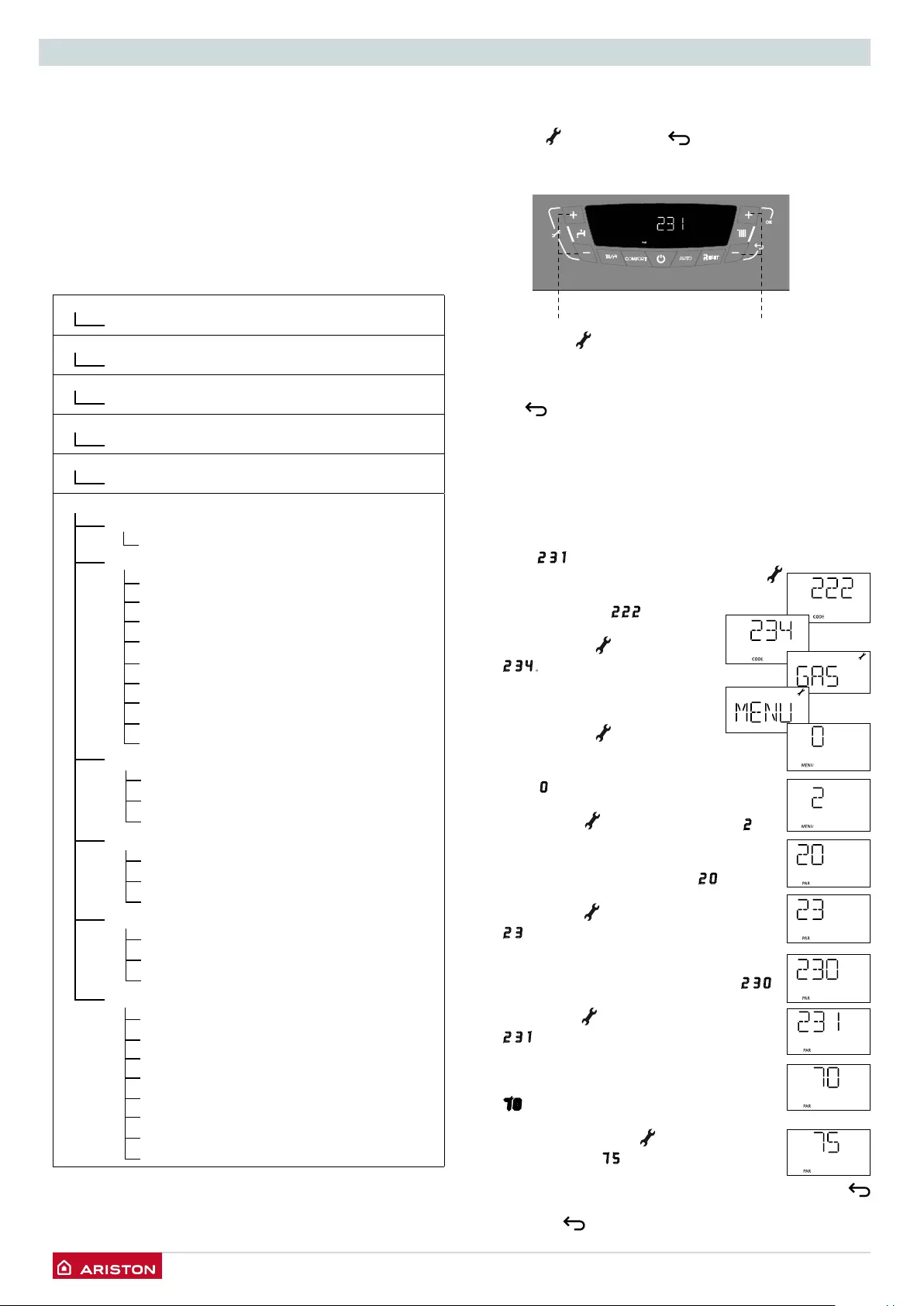
40 /
SETTINGS - ADJUSTMENT - PROBLEM IDENTIFICATION MENUS
Accessing the settings - adjustment - problem identication menus
The boiler can be used to manage the heating and domestic hot
water production system in its entirety.
Navigation within the menus enables the boiler system +
connected peripheral units to be customised, optimising
operation for maximum comfort and maximum saving. It also
provides important information relating to the efcient operation
of the boiler.
Before access to the menus, the display show some “quick
settings” to have direct access to the parameters.
To see all available parameters and menu access to view FULL
MENU.
GAS - Direct access to the parameters:
220 - 231- 232- 233 - 234 - 270
SET - Direct access to the parameters:
220 - 231- 223 - 245 - 246
PCB - Direct access to the parameters:
220 - 228 - 229 - 231- 232- 233 - 234 - 247 - 250 - 253
VIS - Direct access to the parameters:
821 - 822 - 824 - 825 - 827 - 830 - 831 - 832 - 833- 840 - 835
ZONE - Direct access to the parameters:
402 - 502 - 602 - 420 - 520 - 620 -434 - 534 - 634 - 830
FULL MENU - see table on following pages
0NETWORK
0 4 User Interface
2 Boiler Parameter
2 0 General setting
2 2 Boiler parameter
2 2 General setting
2 3 C.H. Parameters - Part 1
2 4 C.H. Parameters - Part 2
2 5 Domestic Hot Water
2 6 Boiler manual settings
2 7 Test & Utilities
2 8 Menù 2 Reset to factory setting
4 Zone 1 Parameters
4 0 Set-point Zone1
4 2 Zone 1 Setting
4 3 Diagnostics
5 Parametri Zona 2
5 0 Set-point Zone2
5 2 Zone 2 Setting
5 3 Diagnostics
6Parametri Zona 3
6 0 Set-point Zone3
6 2 Zone 3 Setting
6 3 Diagnostics
8Service Parameter
8 0 Statistics-1
8 1 Statistics-2
8 2 Boiler
8 3 Boiler Temperature
8 4 Solar & Storage
8 5 Service
8 6 Error History
8 7 Free parameter
The parameters relating to each individual menu are listed in the
following pages.
The various parameters can be accessed and modied using the
“+” and“-” , “+” OK and “-” buttons. (see g. below).
The description of the menus and of each individual parameter will
be shown on the display.
2. “+” and “-” buttons to access and modify
the parameters.
8. “+” OK button to store the adjustments of various
parameters.
“-” (ESC) button to exit from the parameters.
2 8
The menus and parameters number is shown by the gures of
the display.
CAUTION! THE MENUS RESERVED FOR QUALIFIED
TECHNICIANS MAY ONLY BE ACCESSED AFTER SETTING
THE ACCESS CODE.
To access the Menus, open the cover and proceed as follows (for
example: 231
1. Simultaneously press the 2 “+” and “-”
buttons for 5 seconds. Insert the service code,
the display shows 222
2. Press the “+” button to select
234.
3. Press the “+” OK button. the display
shows the rst “quick setting”
GAS
4. Press the “+” button to select
MENU
(Complete MENU)
3. Press the “+” OK button.The display shows
menu 0
4. Press the “+” button to select menu 2
.
5.
Press the “+” OK button to access to the menu.
The display shows the sub-menu 20.
4. Press the “+” button to select the sub-menu
23.
3. Press the “+” OK button to access to the sub-
menu. The display shows the parameter 230.
4. Press the “+” button to select the parameter
231.
5. Press the “+” OK button to access to the
parameter. The display shows the value “ex:
70” .
6. Press the 2 “+” or “-” button to select the
new value “ex: 75”
7. Press the “+” OK button pto save the change or press “-”
(ESC) button to exit without saving.
Press the “-” (ESC) button until the normal display screen is
restored.
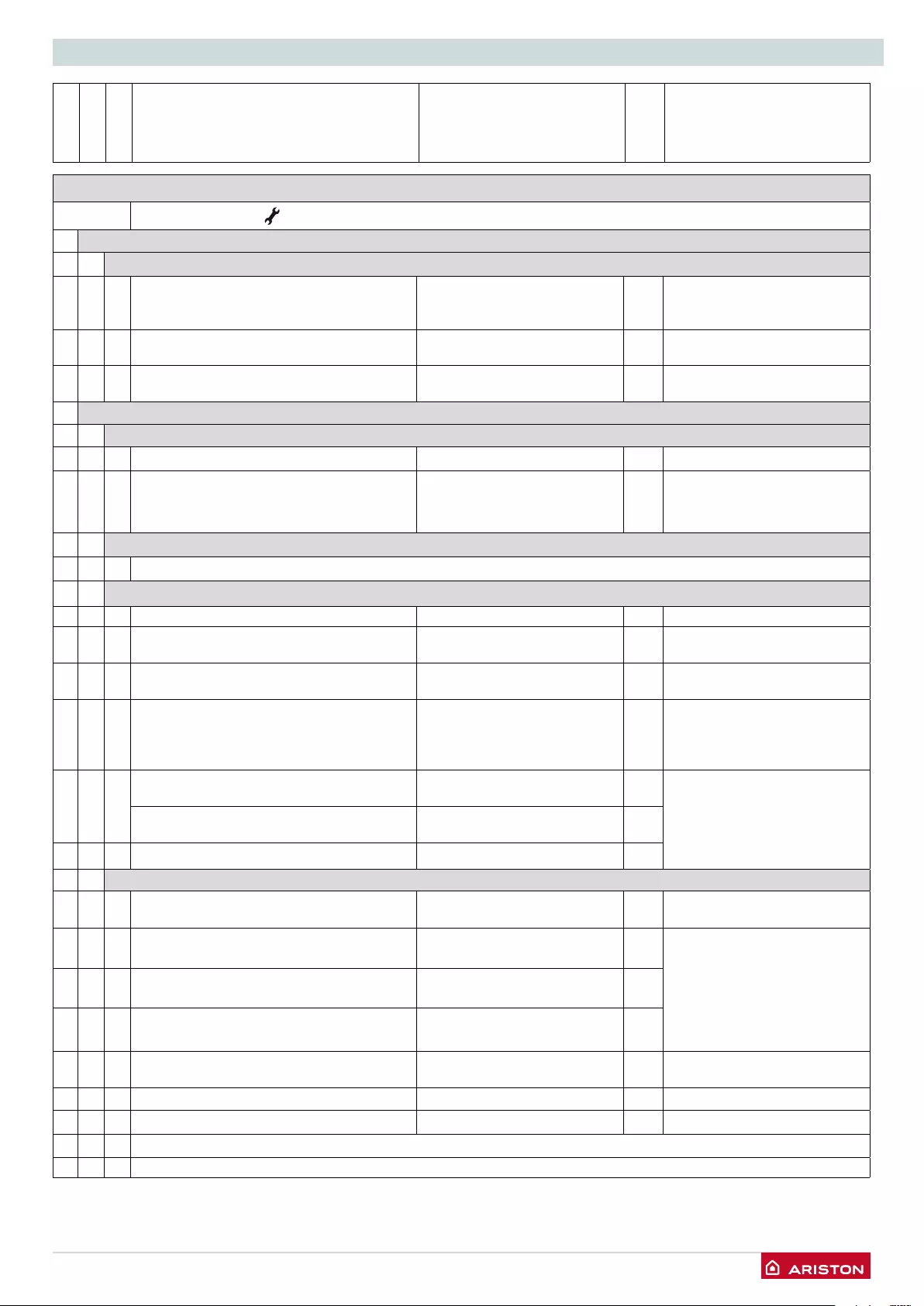
/ 41
SETTINGS - ADJUSTMENT - PROBLEM IDENTIFICATION MENUS
menu
sub-menu
Parameter
Description value
default setting
SERVICE CODE
Press
the button “+”
to select code 234 and press ok. Turn the encoder to select MENU and press OK button
0NETWORK
0 4 DISPLAY SETTING
0 4 0 Zone to be set by display 1 = 1 Zone
2 = 2 Zone
3 = 3 Zone
1
0 4 1 Backlight timing
from 0 to 10 (minutes) or 24
(hour)
24
0 4 2Thermoregulation button deactivation 0 = OFF
1 = ON
0
2BOILER PARAMETER SETTING
20GENERAL
200DHW Setpoint Temperature from 36 to 60 (°C) Setting by DHW button 2
20 1
DHW Pre-heating 0 = OFF
1 = ON
RESERVED FOR TECHNICAL
ASSISTANCE
Only if the PCB is changed
21 BOILER PARAMETERS
20 0
Boiler circulator type (NOT ACTIVE)
2 2 BOILER GENERAL SETTINGS
2 2 0Soft ignition from 0 to 90 60 See parag. Gas settings
2 2 3 Underoor thermostat or zone 2 ambient
thermostat selection
0 = Floor safety thermostat
1 = Zone 2 ambient thermostat
0
2 2 4Thermoregulation 0 = Absent
1 = Present
0
2 2 5Heating ignition delay 0 = Deactivated
1 = 10 seconds
2 = 90 seconds
3 = 210 seconds
0
2 2 8Boiler Version - CLAS ONE / CLAS ONE NET
CANNOT BE MODIFIED
from 0 to 5 0
RESERVED FOR TECHNICAL
ASSISTANCE
Only if the PCB is changed
Boiler Version - CLAS SYSTEM ONE
CANNOT BE MODIFIED
from 0 to 5 2
2 2 9Set boiler heat power
2 3 BOILER PARAMETER - PART 1
2 3 1Maximum heating power setting from 0 to 99 60 see the “Gas setting” table,
information on Starting
2 3 2 Domestic hot water maximum percentage
CANNOT BE MODIFIED
from 0 to 99
RESERVED FOR TECHNICAL
ASSISTANCE
Only if the gas or PCB is
changed
see “gas setting” table
233Minimum percentage
CANNOT BE MODIFIED
from 0 to 99
2 3 4Heating maximum percentage
CANNOT BE MODIFIED
from 0 to 99
2 3 5Selection of ignition delay type when
heating
0 = Manual
1 = Automatic
1
2 3 6 Ignition delay when heating timer setting from 0 to 7 (minutes) 3
2 3 7 Post-circulation when heating from 0 to 15 minutes or OC (AC) 3
2 3 8<Not Available>
2 3 9<Not Available>
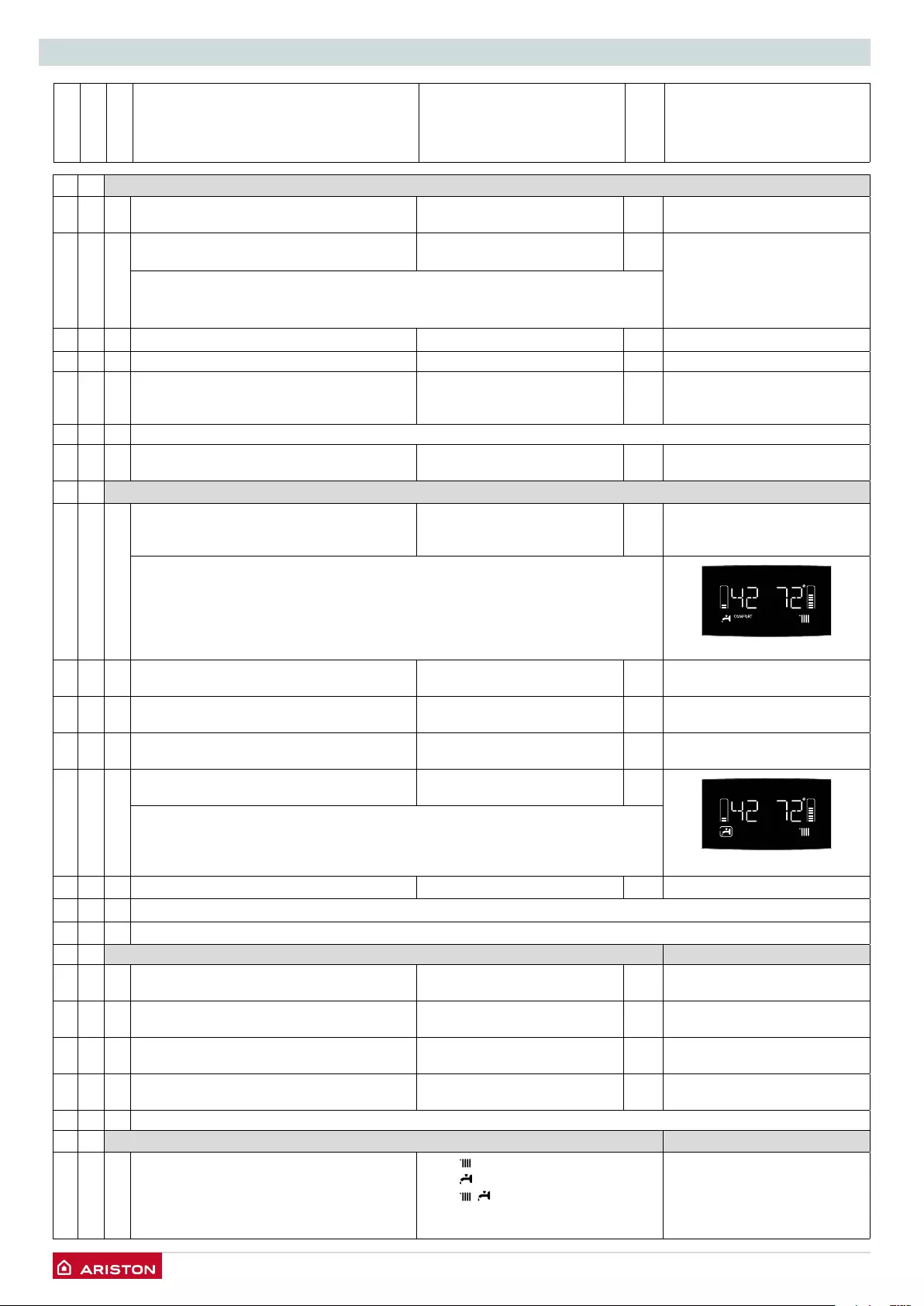
42 /
SETTINGS - ADJUSTMENT - PROBLEM IDENTIFICATION MENUS
menu
sub-menu
Parameter
Description value
default setting
24 BOILER PARAMETER - PART 2
243Post-ventilation after heating request 0 = OFF
1 = ON
0
244Time delay after heating temperature
increase
from 0 to 60
(minutes)
16 Activated only with thermostat
On/Off and heating control
activated
(parameter 421 - 521 - 621 = 01)
This parameter allows the time delay to be set before automatic increase of the ow
temperature calculated in increments of 4°C (max 12°C). If this parameter retains the
value 00, this function is not active.
24 5 Circulation pump MAX speed from 75 to 100
246Circulation pump MIN speed from 40 to 100
247Device indicator for heating circuit pressure 0 = temperature sensor only
1 = pressure switch at minimum
2 = pressure sensor
1 RESERVED FOR TECHNICAL
ASSISTANCE
Only if the PCB is changed
24 8 <Not Available>
24 9 External temperatura correction from -3 to +3 (°C) 0 Only active with external sensor
connected
25 DOMESTIC HOT WATER PARAMETER
25 0 COMFORT function
CLAS ONE - CLAS NET ONE
0 = deactivated
1 = timed
2 = always on
0Timer = activated for 30 minutes
after domestic hot water draw-
off
The appliance allows the hot water heating comfort to be increased via the
“COMFORT” function.
This function keeps the secondary exchanger temperature stable when the boiler is
not in use. When the function is active, the display shows COMFORT
Note: this function can be activated and deactivated by pressing the COMFORT
button
25 1 Comfort Anti-cycling Time
CLAS ONE - CLAS NET ONE
from 0 to 120 (minutes) 0
252Hot water ow delay
CLAS ONE - CLAS NET ONE
from 5 to 200 (0.5 to 20 secon-
ds)
5 Anti “water hammering”
253Extinction of the burner in D. H. W.
CLAS ONE - CLAS NET ONE
0 = anti-scale (stop at > 67°C)
1 = + 4°C /setting
0
25 4 Post-circulation and post-ventilation after a
domestic hot water draw-off
0 = OFF
1 = ON
0
OFF = 3 minutes post-circulation and post-ventilation after domestic hot water draw-
off if the boiler temperature measured requires it.
ON = always on for 3 minutes post-circulation and post-ventilation after domestic
hot water draw-off.
255Domestic hot water timer from 0 to 30 (minutes) 0
257<Not Available>
25 8 <Not Available>
2 6 BOILER MANUAL SETTINGS Only to test components
2 6 0Manual mode activation 0 = OFF
1 = ON
0
2 6 1Boiler pump control 0 = OFF
1 = ON
0 Set parameter 260=1
2 6 2 Fan control 0 = OFF
1 = ON
0 Set parameter 260=1
2 6 3 3 way valve control 0 = Sanitary
1 = Heating
0 Set parameter 260=1
2 6 4<Not Available>
2 7 TEST & UTILITIES
2 7 0Test mode TEST+ = Max Heating power
TEST+ = Max DHW power
TEST+ = Minimum power.
activation can also be obtained
by pressing the Reset button
for 10 seconds. The function is
deactivated after 30 minutes or
by pressing Reset

/ 43
SETTINGS - ADJUSTMENT - PROBLEM IDENTIFICATION MENUS
menu
sub-menu
Parameter
Description value
default setting
2 7 1Bleed cycle press OK button for 5 seconds see First Ignition parag.
28 RESET MENU’ 2
28 0 Automatically resetting to the default setting
in menu 2
Reset
OK = yes
ESC = no
To reset all default parameter
settings, press the OK button
4 ZONE 1 PARAMETER
4 0 ZONE 1 TEMPERATURE SETTING
4 0 2Heating xed temperature setting
“Heating xed temp”
from 35 to 82 °C
(high temperature - para. 420
=1)
70 Activated only with temperature
control and xed temperature
(see 421)
from 20 to 45 °C
(high temperature - para. 420
=0)
20
42ZONE 1 SETTING
420Heating appliance temperature value setting 0 = from 20 to 45°C
(low temperature)
1 = from 35 to 85°C
(high temperature)
select in the appliance type
base
421Basic heating control type selection type
depending on the peripheral devices
connected
0 = xed ow temperature
1 = device On/Off
2 = room sensor
3 = external sensor only
4 = room sensor +
external sensor
1To activate heating control,
press the AUTO button. The
display lights up the AUTO
symbol
422Slope from 0_2 to 0_8 (low temperature)
from 1_0 to 3_5 1_5 (high temperature)
Flow Temperature
Low temperature High temperature
External temperature
Ambiente temperature
setting value
°C
20
25 15
30
40
50
60
70
80
90
100 °C
10
2.5 3.0 3.5 2.0
1.5
1.2
1.0
0.8
0.6
0.4
0.2
5 0 -5 -10 -15 -20 °C
If the external sensor is used,
the boiler calculates the
most suitable heating ow
temperature taking the external
temperature and the type of
appliance into account.
The type of curve must be
chosen according to the type of
appliance radiator and the heat
losses present in the building.
42 3 Parallel shift from - 7 to + 7 (low temperature) 0
from - 14 to + 14
(high temperature)
To adapt the thermal curve to the appliance requirements, it is possible to perform
a parallel shift of the curve in order to alter the calculated ow temperature and
therefore the ambient temperature.
By accessing this parameter or pressing the buttons 8 the curve can be shifted in a
parallel manner as indicated in the gure shown below.
The value is indicated on the display:
- from -7 to +7
(low temperature)
- from -14 to +14
(high temperature)
Each step represents a ow temperature increase/decrease of 1°C in relation to the
set-point value.
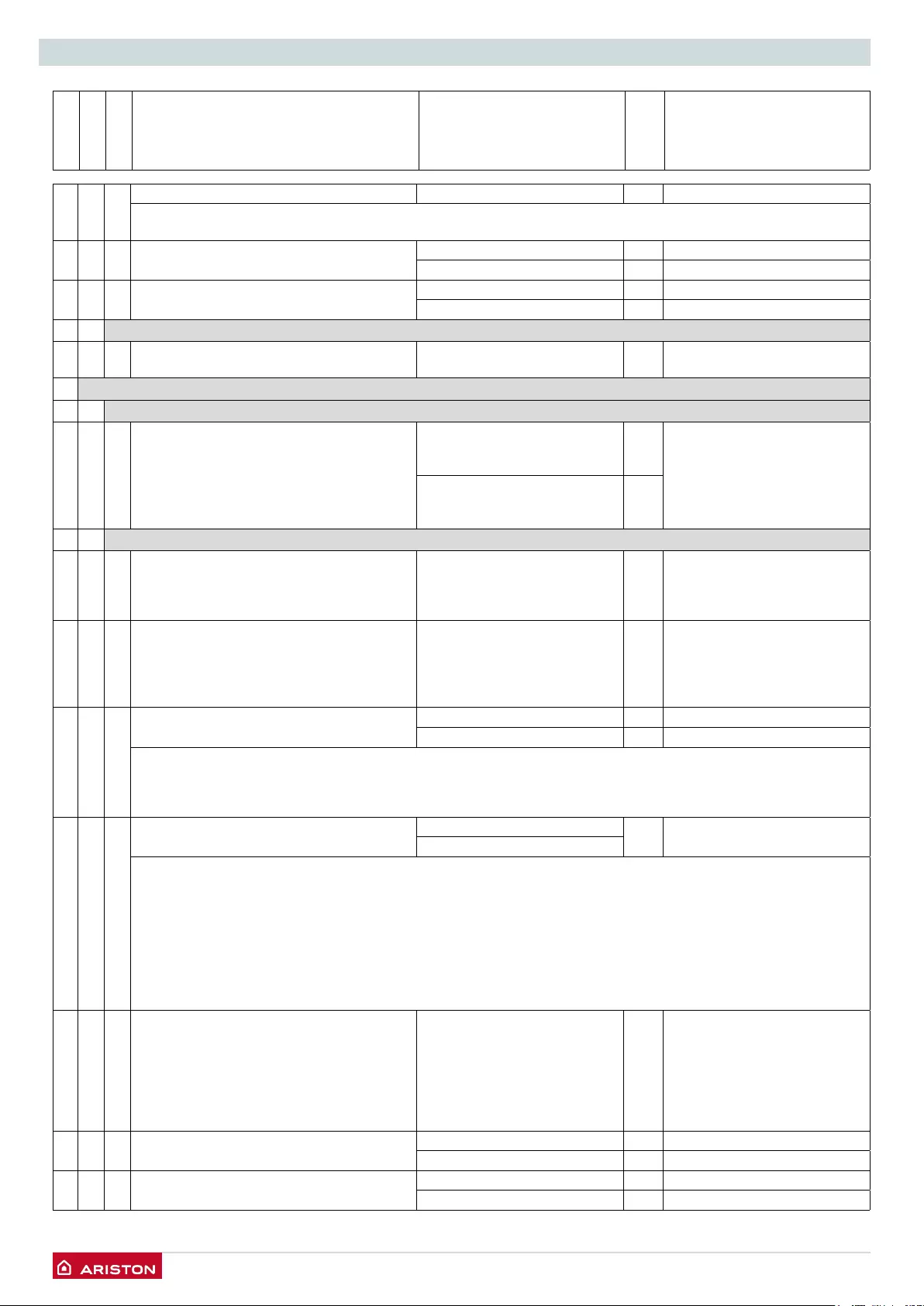
44 /
SETTINGS - ADJUSTMENT - PROBLEM IDENTIFICATION MENUS
menu
sub-menu
Parameter
Description value
default setting
424Compensation from 0 to 20 20
if setting = 0, the temperature taken from the ambient sensor does not affect the calculation of the setting. If setting = 20,
the temperature taken has maximum inuence on the setting.
425Zone 1 heating MAXIMUM temperature
setting
from 35 to 85 °C 82 if parameter 420 = 1
from 20 to 45 °C 45 if parameter 420 = 0
42 6 Zone 1 heating MINIMUM temperature
setting
from 35 to 85 °C 35 if parameter 420 = 1
from 20 to 45 °C 25 if parameter 420 = 0
43DIAGNOSTICS
434Zone 1 heat request 0 = OFF
1 = ON
5 ZONE 2 PARAMETER
5 0 ZONE 2 TEMPERATURE SETTING
5 0 2Heating xed temperature setting
“Heating xed temp”
from 35 to 82 °C
(high temperature - para. 420
=1)
70 Activated only with temperature
control and xed temperature
(see 521)
from 20 to 45 °C
(high temperature - para. 420
=0)
20
52ZONE 2 SETTING
520Heating appliance temperature value setting 0 = from 20 to 45°C
(low temper ature)
1 = from 35 to 85°C
(high temperature)
1select in the appliance type
base
521Basic heating control type selection type
depending on the peripheral devices
connected
0 = xed ow temperature
1 = device On/Off
2 = NOT PRESENT
3 = external sensor only
4 = NOT PRESENT
1To activate heating control,
press the AUTO button. The
display lights up the AUTO
symbol
522Slope from 0_2 to 0_8 (low temperature)
from 1_0 to 3_5 1_5 (high temperature)
- see graph on the previous page
If the external sensor is used, the boiler calculates the most suitable heating ow temperature taking the external
temperature and the type of appliance into account.
The type of curve must be chosen according to the type of appliance radiator and the heat losses present in the building.
52 3 Parallel curve shift Zone 2 Offset from - 7 to + 7 (low temperature) 0
from - 14 to + 14
(high temperature)
To adapt the thermal curve to the appliance requirements, it is possible to perform a parallel shift of the curve in order
to alter the calculated ow temperature and therefore the ambient temperature.
By accessing this parameter or pressing the buttons 12 the curve can be shifted in a parallel manner as indicated in the
gure shown below.
The value is indicated on the display:
- from -7 to +7
(low temperature)
- from -14 to +14
(high temperature)
Each step represents a ow temperature increase/decrease of 1°C in relation to the
set-point value.
524Compensation from 0 to 20 20 if setting = 0, the temperature
taken from the ambient sensor
does not affect the calculation
of the setting. If setting = 20,
the temperature taken has
maximum inuence on the
setting.
525Zone 2 heating MAXIMUM temperature
setting
from 35 to 85 °C 82 if parameter 520 = 1
from 20 to 45 °C 45 if parameter 520 = 0
52 6 Zone 2 heating MINIMUM temperature
setting
from 35 to 85 °C 35 if parameter 520 = 1
from 20 to 45 °C 25 if parameter 520 = 0
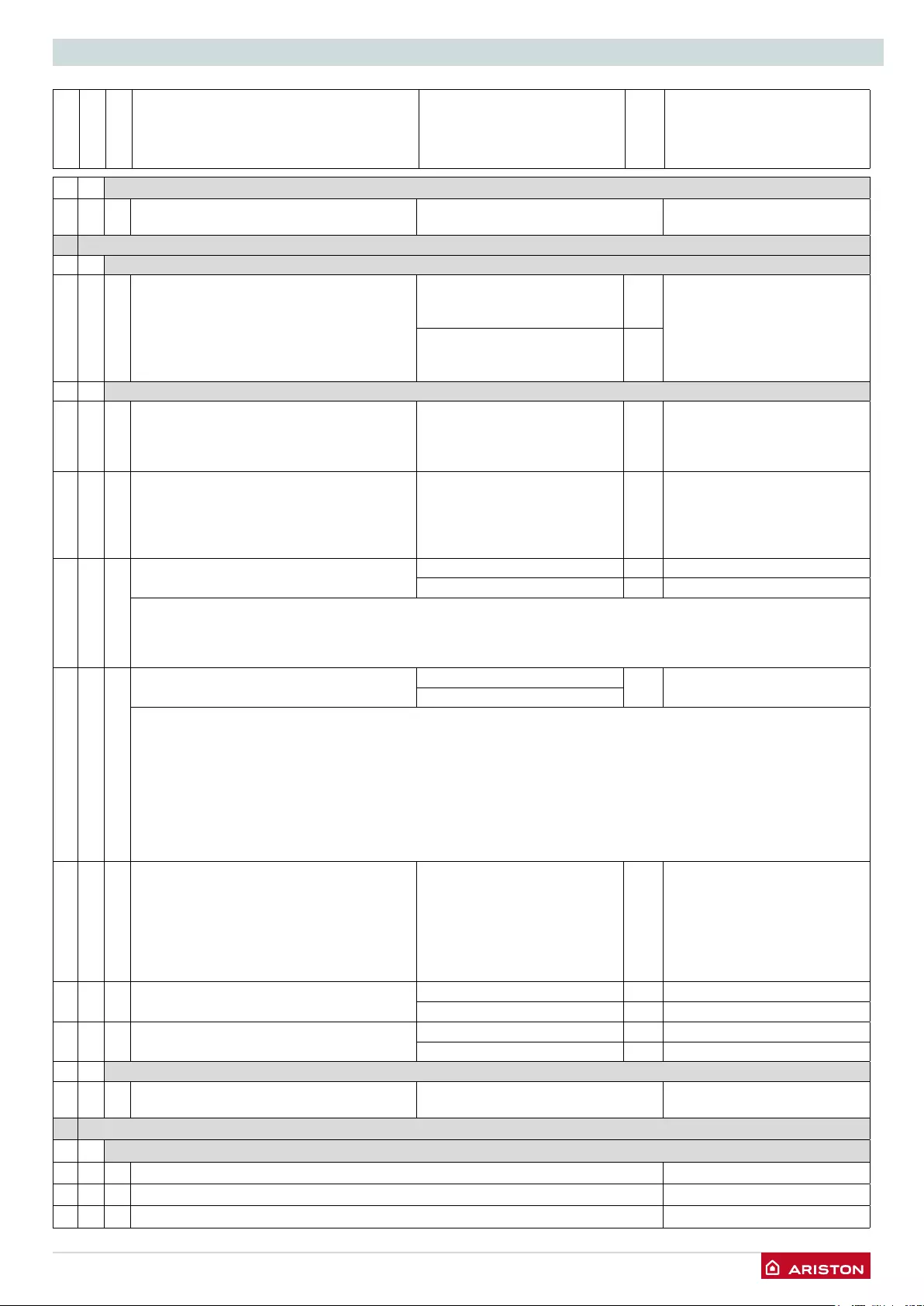
/ 45
SETTINGS - ADJUSTMENT - PROBLEM IDENTIFICATION MENUS
53DIAGNOSTICS
534Zone 2 heat request 0 = OFF
1 = ON
6ZONE 3 PARAMETER
60 ZONE 3 TEMPERATURE SETTING
602Heating xed temperature setting
“Heating xed temp”
from 35 to 82 °C
(high temperature - para. 420
=1)
70 Activated only with temperature
control and xed temperature
(see 621)
from 20 to 45 °C
(high temperature - para. 420
=0)
20
6 2 ZONE 3 SETTING
6 2 0Heating appliance temperature value setting 0 = from 20 to 45°C
(low temper ature)
1 = from 35 to 85°C
(high temperature)
1select in the appliance type
base
6 2 1Basic heating control type selection type
depending on the peripheral devices
connected
0 = xed ow temperature
1 = device On/Off
2 = NOT PRESENT
3 = external sensor only
4 = NOT PRESENT
1To activate heating control,
press the AUTO button. The
display lights up the AUTO
symbol
622Slope from 0_2 to 0_8 (low temperature)
from 1_0 to 3_5 1_5 (high temperature)
- see graph on page 42
If the external sensor is used, the boiler calculates the most suitable heating ow temperature taking the external
temperature and the type of appliance into account.
The type of curve must be chosen according to the type of appliance radiator and the heat losses present in the building.
6 2 3 Parallel curve shift Zone 2 Offset from - 7 to + 7 (low temperature) 0
from - 14 to + 14
(high temperature)
To adapt the thermal curve to the appliance requirements, it is possible to perform a parallel shift of the curve in order
to alter the calculated ow temperature and therefore the ambient temperature.
By accessing this parameter or pressing the buttons 12 the curve can be shifted in a parallel manner as indicated in the
gure shown below.
The value is indicated on the display:
- from -7 to +7
(low temperature)
- from -14 to +14
(high temperature)
Each step represents a ow temperature increase/decrease of 1°C in relation to the
set-point value.
6 2 4Compensation from 0 to 20 20 if setting = 0, the temperature
taken from the ambient sensor
does not affect the calculation
of the setting. If setting = 20,
the temperature taken has
maximum inuence on the
setting.
6 2 5Zone 3 heating MAXIMUM temperature
setting
from 35 to 85 °C 82 if parameter 620 = 1
from 20 to 45 °C 45 if parameter 620 = 0
6 2 6 Zone 3 heating MINIMUM temperature
setting
from 35 to 85 °C 35 if parameter 620 = 1
from 20 to 45 °C 25 if parameter 620 = 0
6 3 DIAGNOSTICS
6 3 4Zone 3 heat request 0 = OFF
1 = ON
8 SERVICE PARAMETERS
8 0 BOILER STATISTICS-1
8 0 0
Number of diverter valve cycles (n x10)
8 0 1
Time of circulator on (h x 10)
8 0 2
Number of boiler circulator cycles (n x10)
menu
sub-menu
Parameter
Description value
default setting

46 /
SETTINGS - ADJUSTMENT - PROBLEM IDENTIFICATION MENUS
8 0 3
Boiler Life Time (h x 10)
8 0 4
Time of fan ON (h x 10)
8 0 5
Number of fan cycles (n x10)
8 0 6
Number of ame detection in CH (n x10)
8 1 7
Number of ame detection in DHW (n x10)
8 1 BOILER STATISTICS-2
8 1 0 Number of hours burner operating in heater mode (xxh/10)
811Number of hours burner operating in hot water mode (xxh/10)
8 1 2Number of ame separations (nr/10)
8 1 3Number of ignition cycles (nr/10)
8 1 4 Average length of heating request (minutes)
82 BOILER
821Fan Status 0 = OFF
1 = ON
822Fan speed (x100) rpm
824Diverter valve position 0 = D.H.W.
1 = Central Heating
82 7 Modulating Pump (%)
828Gas Power (kW)
83BOILER TEMPERTURE
831Heating ow temperature (in °C)
83 2 Heating backow temperature (in °C)
8 4 SOLAR & STORAGE
8 4 2Solar appliance water input temperature activated only with the solar kit
connected
8 5 SERVICE
8 5 0 Months to next maintenance from 0 to 60 (month) 24
If setted the boiler will display that is time to call the installer for maintenance
8 5 1 Enable Maintenance advice 0 = OFF
1 = ON
0
8 5 2Maintenance Warning Reset Reset? OK= Yes Esc = No
to erase the advice for maintenance
8 5 32nd Heat Exchanger Clogging State 0 = DHW Exchanger OK
1 = Partially Clogged
2 = Very Clogged Please
Replace
8 5 4 PCB hardware version
855PCB software version
86 ERROR LIST
86010 last errors from ERROR 0 to ERROR 9
This parameter allows the last 10 boiler errors agged to be displayed, indicating the day, month and year.
When the parameter is accessed, the errors are displayed listed from ERROR 0 to ERROR 9.
For each error, the following sequence is displayed:
E00 - error number
108 - error code
861Error list reset Reset
OK = yes
ESC = no
menu
sub-menu
Parameter
Description value
default setting

/ 47
MAINTENANCE
Important
Maintenance is an essential part of the safe and
efcient operation of the boiler and ensures its
durability. It should be performed according to the
instructions given in current legislation. Perform
combustion analysis regularly in order to check the
operating efciency of the boiler and to make sure
any polluting substances released are within the
boundaries set by current legislation.
Before beginning maintenance work:
- Disconnect the appliance from the electricity supply by
turning the external bipolar switch to the “OFF” position;
- Close the gas valve and the central heating and domestic
hot water system valves.
After the work has been completed the initial settings will be
restored.
General comments
It is recommended that the following inspections be
carried out on the boiler at least once a year:
1. Check the seals in the water part and, if necessary, replace
the gaskets and restore the seal to perfect working order.
2. Check the seals in the gas part and, if necessary, replace
the gaskets and restore the seal to perfect working order.
3. Visually check the overall condition of the boiler.
4. Visually check and, if necessary, disassemble and clean
the burner.
5. Following the inspection detailed in point “3”, disassemble
and clean the combustion chamber, if necessary.
6. Following the inspection detailed in point “4”, disassemble
and clean the burner, if necessary.
7. Cleaning the primary heat exchanger
8. Make sure the following heating safety devices are
operating correctly:
- temperature limit safety device.
9. Make sure that the following gas part safety devices are
operating correctly:
- absence of gas or ame safety device (ionisation).
10. Check the efciency of the domestic hot water production
process (test the ow rate and temperature).
11. Perform a general inspection of the boiler operation.
12. Remove oxide from the detection electrode using an emery
cloth.
13. These checks are not exhaustive. Further mechanical,
electrical and combustion maintenance checks may be
required.
Operational test
After having carried out the maintenance operations, ll the
heating circuit at a pressure of approximately 1.5 bar and release
the air from the system.
Fill the domestic hot water system at the same time.
- Begin operating the boiler.
- If necessary, release the air from the heating system again.
- Check the settings and make sure all the command,
adjustment and monitoring parts are working correctly.
- Check the ue system is sealed and operating correctly.
Draining procedures
The heating system must be drained using the following
procedure:
- Switch off the boiler, make sure the external bipolar switch is
in the OFF position and shut off the gas valve;
- Loosen the automatic air relief valve;
- Open the system drain off cock and collect the escaping water
in a container;
- Empty the water from the lowest points of the system (where
applicable).
If the system is to be left inactive in areas where the room
temperature may fall below 0°C during winter, we recommend
that anti-freeze liquid is added to the water in the heating system
in order to avoid the need for repeated draining; when this liquid
is used make sure it is compatible with the stainless steel used
for the bodywork of the boiler.
We recommend the use of anti-freeze products which contain
PROPYLENE GLYCOLS as these inhibit corrosion and that they
are used in conjunction with the anti-scaling and anti-corrosion
function, in the quantities suggested by the manufacturer, at the
mimimum temperature.
Regularly check the pH level of the water/anti-freeze mix in the
boiler circuit and replace it when the value measured is lower
than the limit prescribed by the manufacturer.
DO NOT MIX DIFFERENT TYPES OF ANTI-FREEZE.
The manufacturer will not be held liable for any damage caused
by the appliance or the system due to the use of inappropriate
anti-freeze substances or additives.
Draining the domestic hot water system and indirect cylinder
Every time there is a danger of freezing, the domestic hot water
system must be drained as follows:
- Shut off the water mains inlet valve;
- Open all the hot and cold water taps;
- Empty the water from the lowest points of the system (where
applicable).
WARNING
Before handling, empty all components which may contain hot
water, performing bleeding where necessary.
Descale the components in accordance with the instructions
provided on the safety data leaet supplied with the product
used, make sure the room is well ventilated, wear protective
clothing, avoid mixing different products, and protect the
appliance and surrounding objects.
Seal all openings used to take a gas pressure reading or to
make any gas adjustments.
If a smell of burning is detected or smoke is seen leaking from
the appliance, or there is a smell of gas, disconnect it from the
electricity supply, shut off the gas valve, open the windows and
call for technical assistance.
Cleaning the primary exchanger
Cleaning the combustion side
The inside of the primary exchanger is accessed by removing
the burner. Wash with water and detergent using a non-metallic
rie-type brush, rinse with water.
Cleaning the trap
The trap is accessed by emptying the condensate bowl located
in the bottom section. Wash with water and detergent.
Replace the condensate collection bowl in its housing.
NB: In the event of prolonged use of the appliance, the trap
must be lled before being used again.
A lack of water in the trap is dangerous and may cause pro-
ducts to be released into the atmosphere.

48 /
MAINTENANCE GUIDE
1. GENERAL ACCESS
1.1 General Access
Tools
TIME 3 min
Remove the two screws
1
1.0 Disconnect the boiler
Before beginning maintenance work:
a. Disconnect the appliance from the electricity supply.
Press the ON/OFF button and wait 1 minute (the 3-way
valve turn on Stand-by position)
ATTENTION!! With the 3-way valve on heating position
is not possible to remove the motor.
Turn the external bipolar switch to the “OFF” position.
b. Close the gas valve and the central heating and domestic
hot water system valves.
1
Remove the front panel
2
Lower the electrical front panel
3
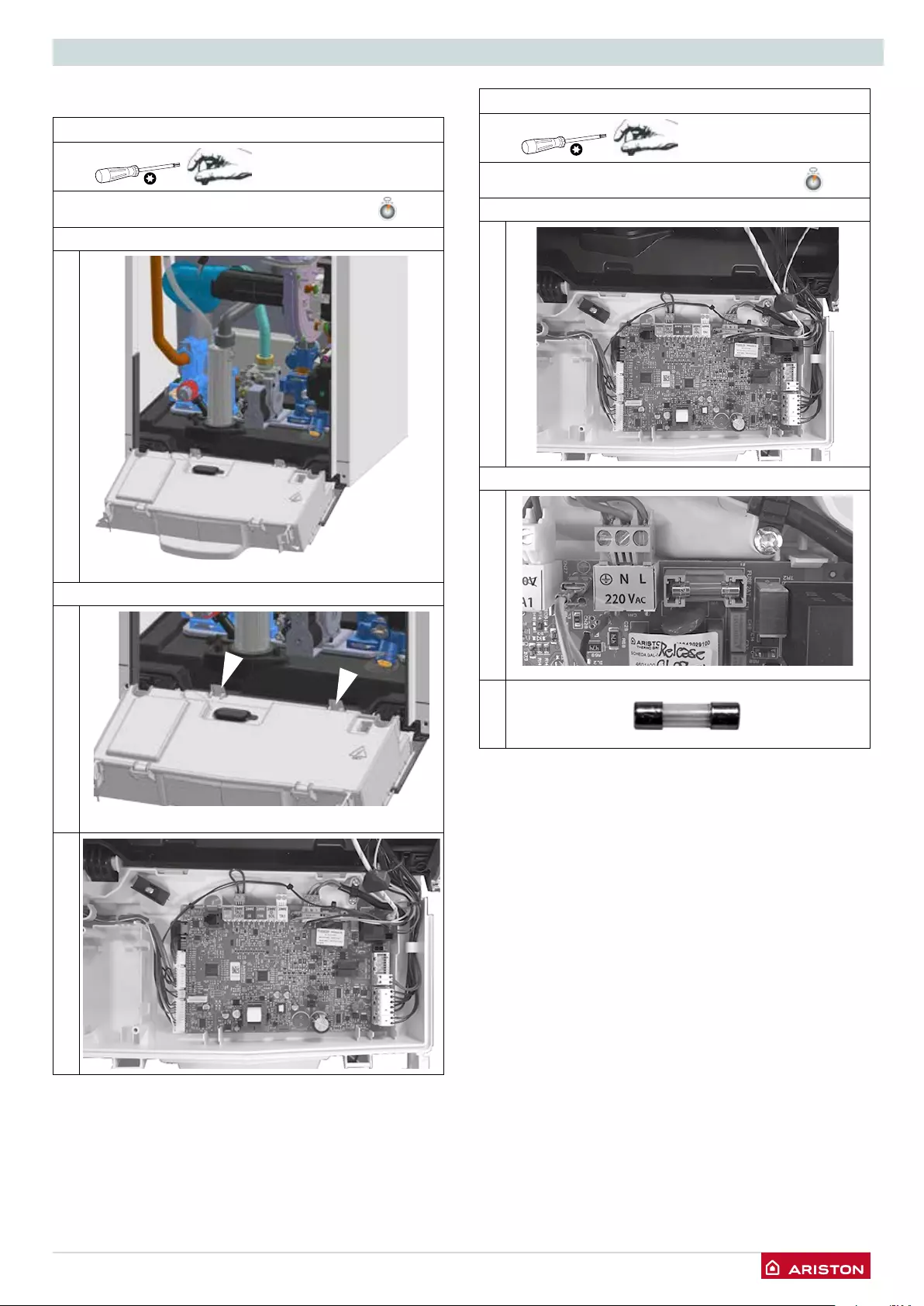
/ 49
MAINTENANCE GUIDE
2. ELECTRICAL UNIT
2.1 Control box access
Tools
TIME 4 min
Remove the front panel as above and pivot the electricl box
1
Unhook the two clip and remove the cover
2
3
2.2 Fuse
Tools
TIME 5 min
Open the control box as above
1
Remove the fuse
2
3

50 /
MAINTENANCE GUIDE
2.3 Main P.C.B.
Tools
TIME 5 min
After opening the control box, disconnect the elctrical plug
connections
1
Unhook and remove the P.C.B.
2
2.4 Display P.C.B.
Tools
TIME 5 min
Unscrews the two screws and pull the assembly towards you
1
Disconnect the elctrical plug connections and unhook and
remove the P.C.B.
2
3

/ 51
MAINTENANCE GUIDE
2.5 Time clock
Tools
TIME 5 min
Unscrews the two screws and pull the assembly towards you
1
Disconnect the elctrical plug connections.
Unscrew the four screws and remove the Time clock.
2
3

52 /
MAINTENANCE GUIDE
3. HYDRAULIC UNIT
3.1 RIGHT HAND HYDRAULIC BLOCK ASSEMBLY
1
2
3
4
10
11
6
7
8
9
Legend:
1 - Diverter valve motor
2 - Diverter valve
3 - D.H.W. ow switch assembly
4 - C.H. drain valve
6 - Central heating lter
7 - Pump
8 - Primary water pressure switch
9 - Auto air vent
10 - Central Heating return
11 - Cold water inlet (D.H.W.)
3.2. 3 Way valve unit
Tools
TIME 5 min
Drain the boiler (see 3.3).
Unplug the diverter valve cable
1
Rotate clockvise to unhook the locking ring.
2
Remove the 3 way valve motor.
3
Remove the clip and lift the diverter valve from the assem-
bly.
4
WHEN REASSEMBLING, ENSURE THE DIVERTER VALVE IS
ALIGNED CORRECTLY.
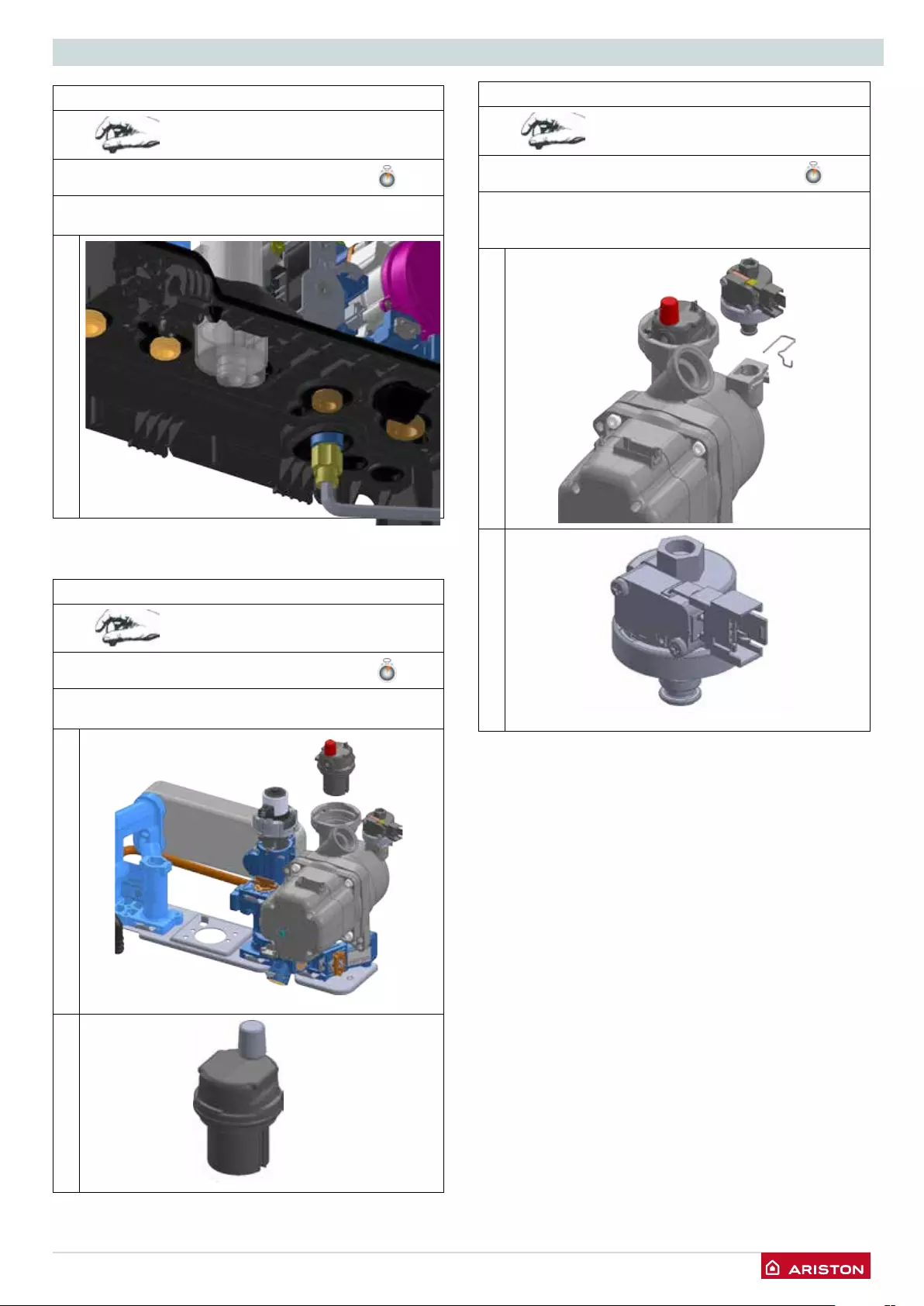
/ 53
MAINTENANCE GUIDE
3.3 Draining
Tools
TIME 5 min
Turn the drain valve anti-clockwise to open and drain the
water from the boiler
1
3.4 Automatic air vent
Tools
TIME 5 min
Drain the boiler (see 3.3).
Unscrew anticlockwise the AAV from the assembly.
1
2
3.5 Primary water pressure sensor
Tools
TIME 5 min
Drain the boiler (see 3.3).
Slide the xing clip, (it is held captive) unplug the electrical
connector and lift the sensor from the assembly.
1
2
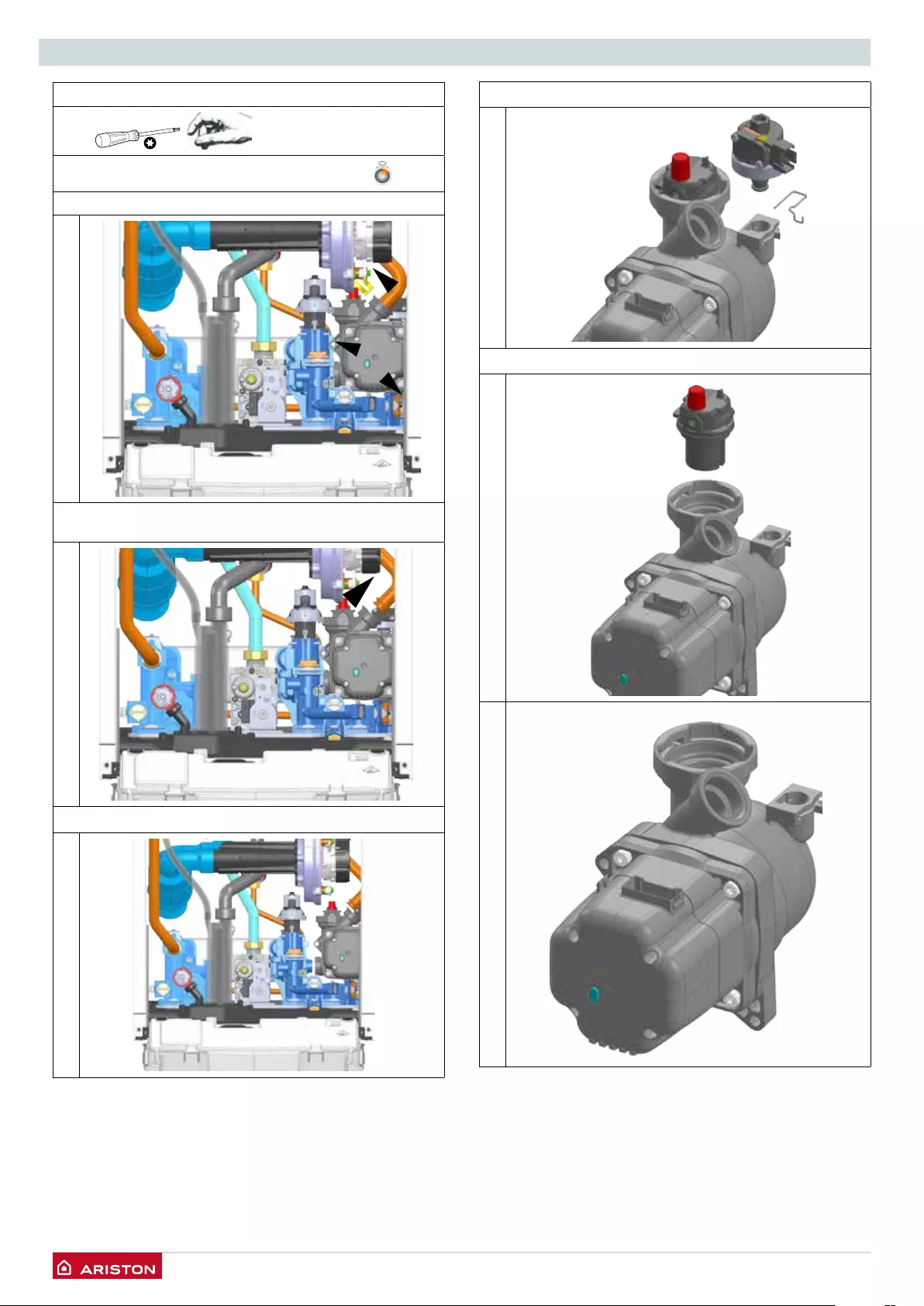
54 /
MAINTENANCE GUIDE
3.6 Pump
Tools
TIME 10 min
Drain the boiler (see 3.3). Remove the clip and the two screws
1
Disconnect the pipe and then move the pump to the right to
disengage
2
Remove the pump
3
Remove the sensor (see 3.5)
4
Remove the AAV (see 3.4)
5
6

/ 55
MAINTENANCE GUIDE
3.8 D.H.W. Flow switch assembly
Tools
TIME 10 min
Drain the boiler (see 3.3). Remove the clip and pull the ow
switch assembly upward.
1
2
3.7 C.H. Filter
Tools
TIME 5 min
Drain the boiler (see 3.3).
Remove the clip and remove the pressure gauge
1
2
Remove the clip and remove the lter
3
4
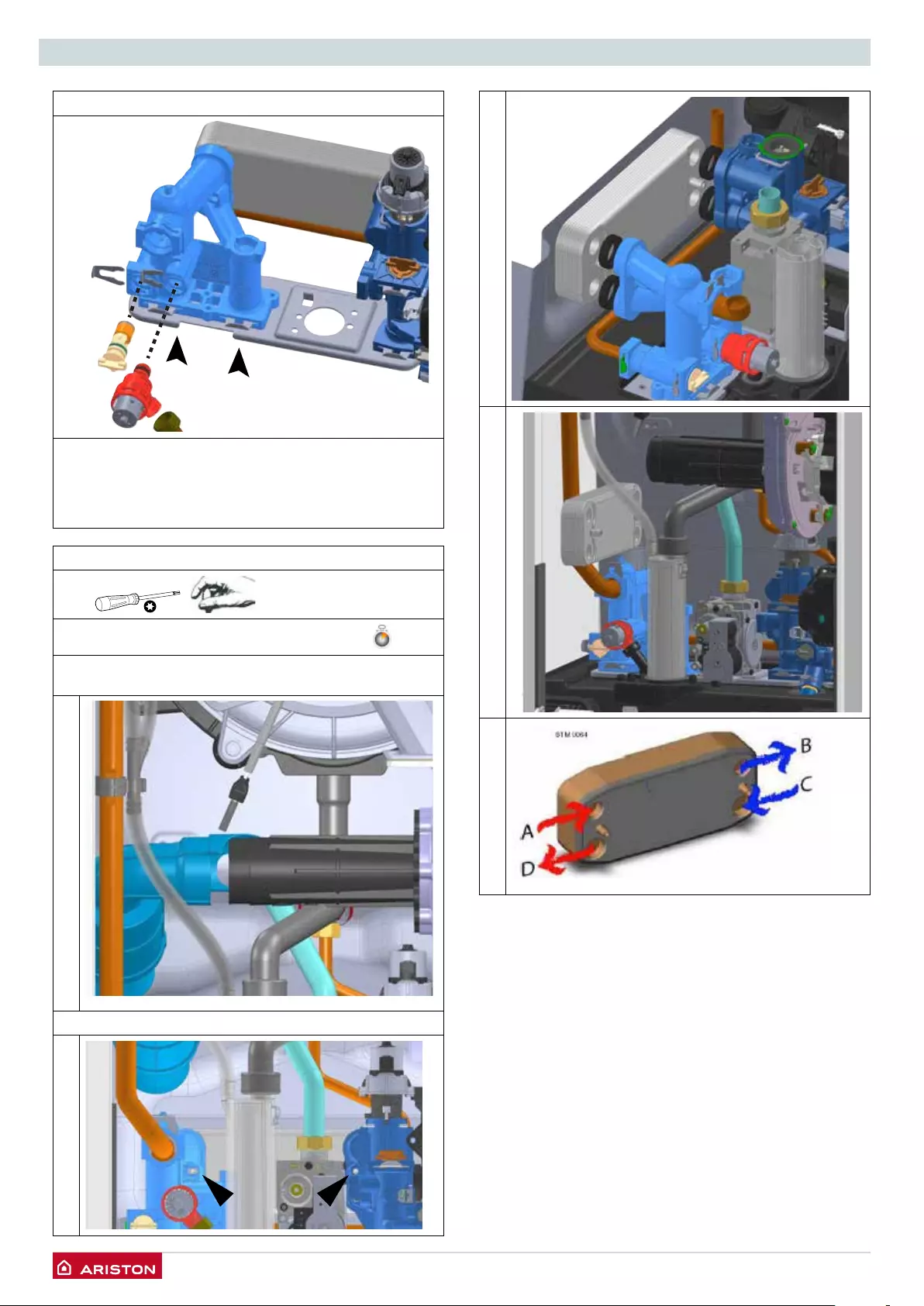
56 /
MAINTENANCE GUIDE
3.10 Secondary heat exchanger
Tools
TIME 10 min
Drain primary and domestic hot water circuits.
Remove the silencer.
1
Remove the two screws and remove the heat exchanger
2
3.9 LEFT HAND HYDRAULIC BLOCK ASSEMBLY
1
234
Legend:
1 - By-pass assembly
2 - Safety valve
3 - Central heating ow
4 - Domestic hot water outlet
3
4
5
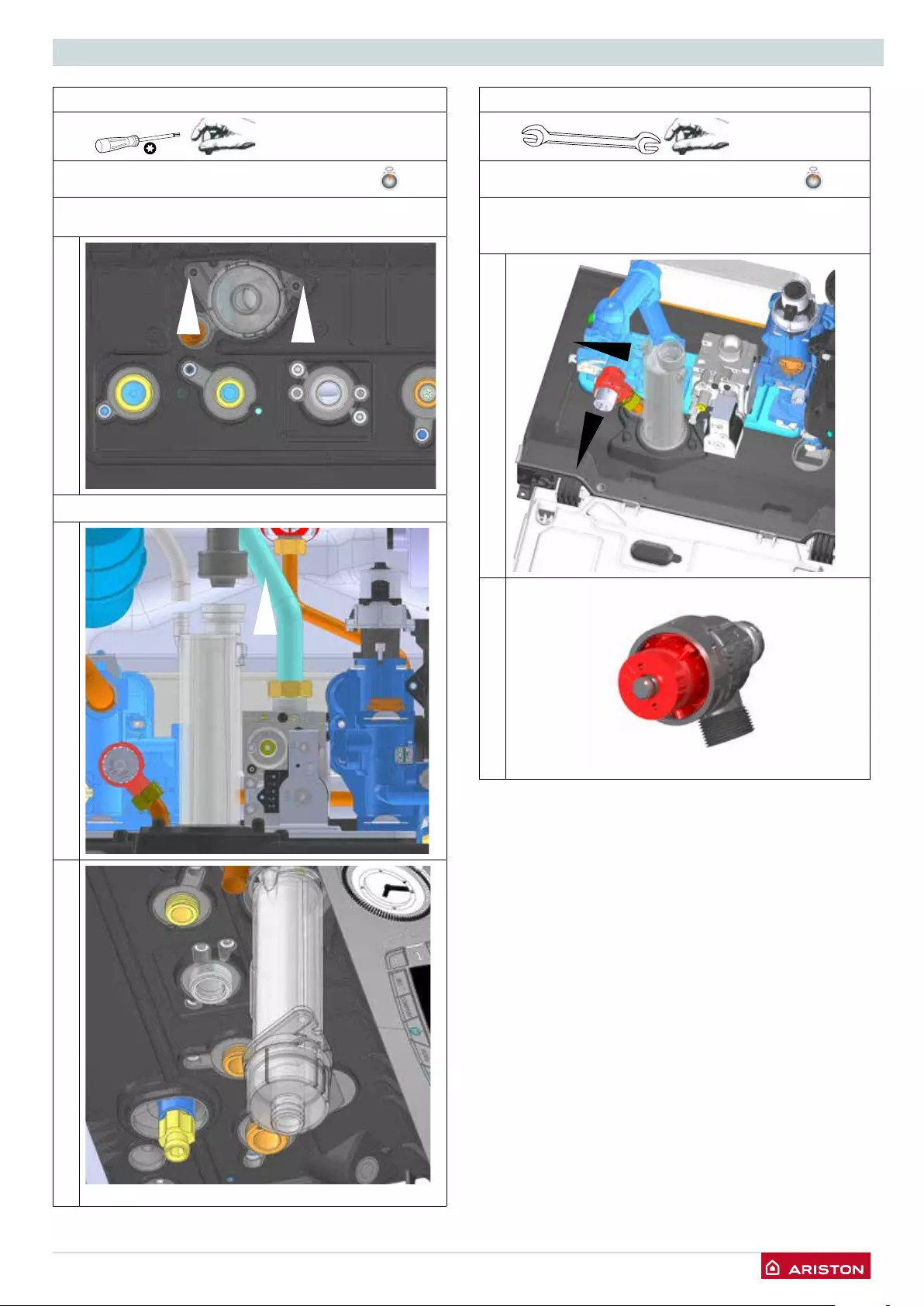
/ 57
MAINTENANCE GUIDE
3.11 Condensate trap
Tools
TIME 5 min
Disconnect the condensate discherge pipe from the bottom of
the boiler. Unscrerw the two screws.
1
Disconnect the condensate pipe from the condensate trap
2
3
3.12 Safety valve
Tools
TIME 5 min
Drain the boiler (see 3.3). Disconnect the discharge pipe.
Remove the st clip on the left and pull the safety valve
towards you
1
2
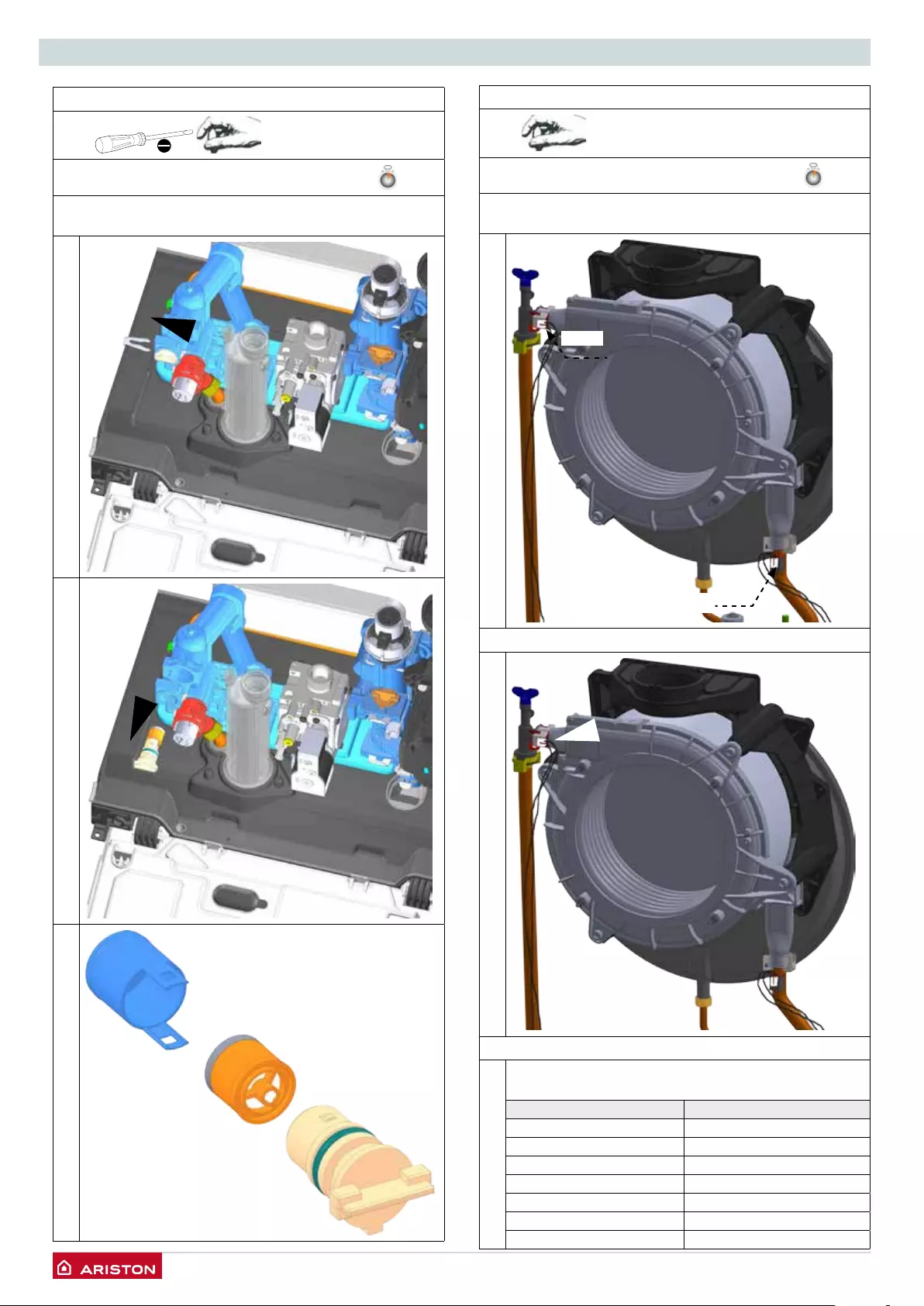
58 /
MAINTENANCE GUIDE
3.14 By-pass assembly
Tools
TIME 5 min
Drain the boiler (see 3.3). Remove the clip and pull the as-
sembly towards you
1
2
3
3.15 Temperature sensors
Tools
TIME 5 min
NTC1 : Black
NTC2: Red
1
Unplug the electrical connectors
2
Remove the clip and the temperature sensor
IMPORTANT ! Do not use conducting paste for the
contact sensors because it will alter the resistance value.
TEMPERATURE RESISTANCE (kOhm)
0 27
10 17
20 12
25 10
30 8
40 5
50 4
NTC1
NTC2
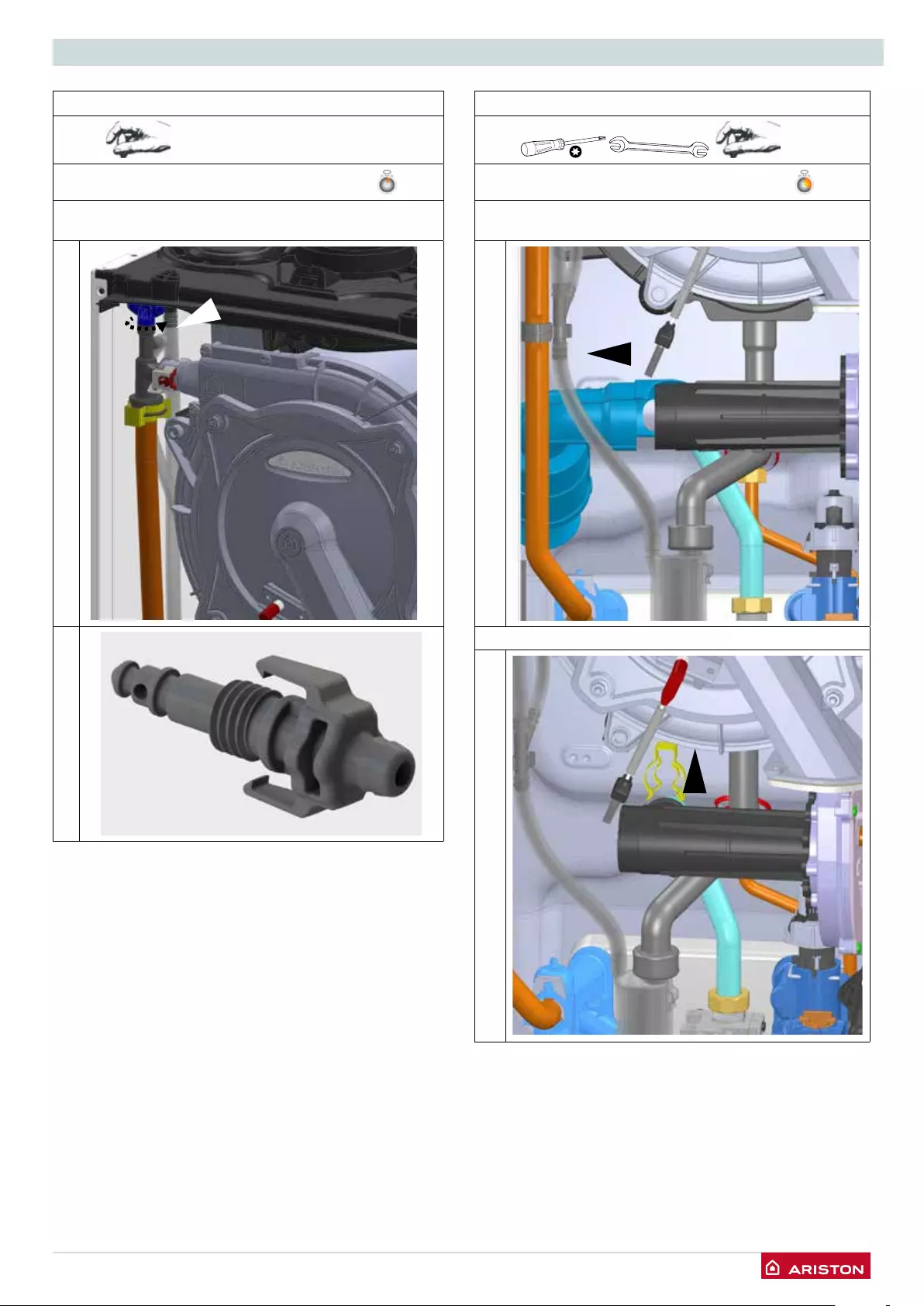
/ 59
MAINTENANCE GUIDE
3.16 Manual Air vent
Tools
TIME 5 min
Drain boiler (see 3.3)
Unscrew and lift the manual air vent from the exchanger
1
2
3.17 Main heat exchanger
Tools
TIME 20 min
Drain boiler (see 3.3)
Remove the silencer
1
Isolate the gas supply and disconnect the gas pipe.
2
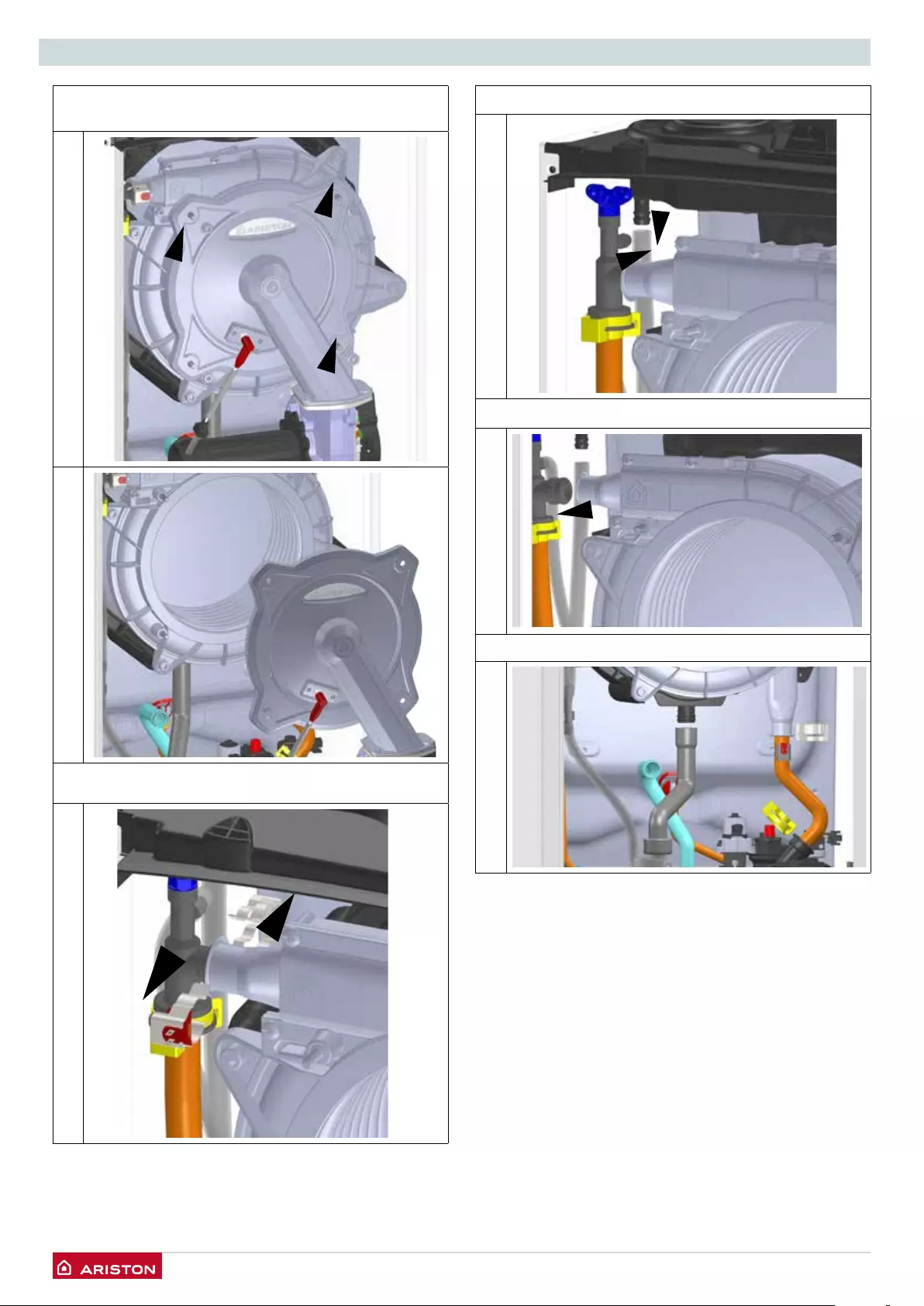
60 /
MAINTENANCE GUIDE
Disconnect the cable of the electrode.
Remove the four nuts and remove the burner unit
3
4
Remove the two clips to disconnet the exhanger on the hea-
ting ow side
5
Disconnect the plastic pipes from the manual air vent.
6
Disconnect the heating ow pipe
7
Disconnect the condensate pipe
8
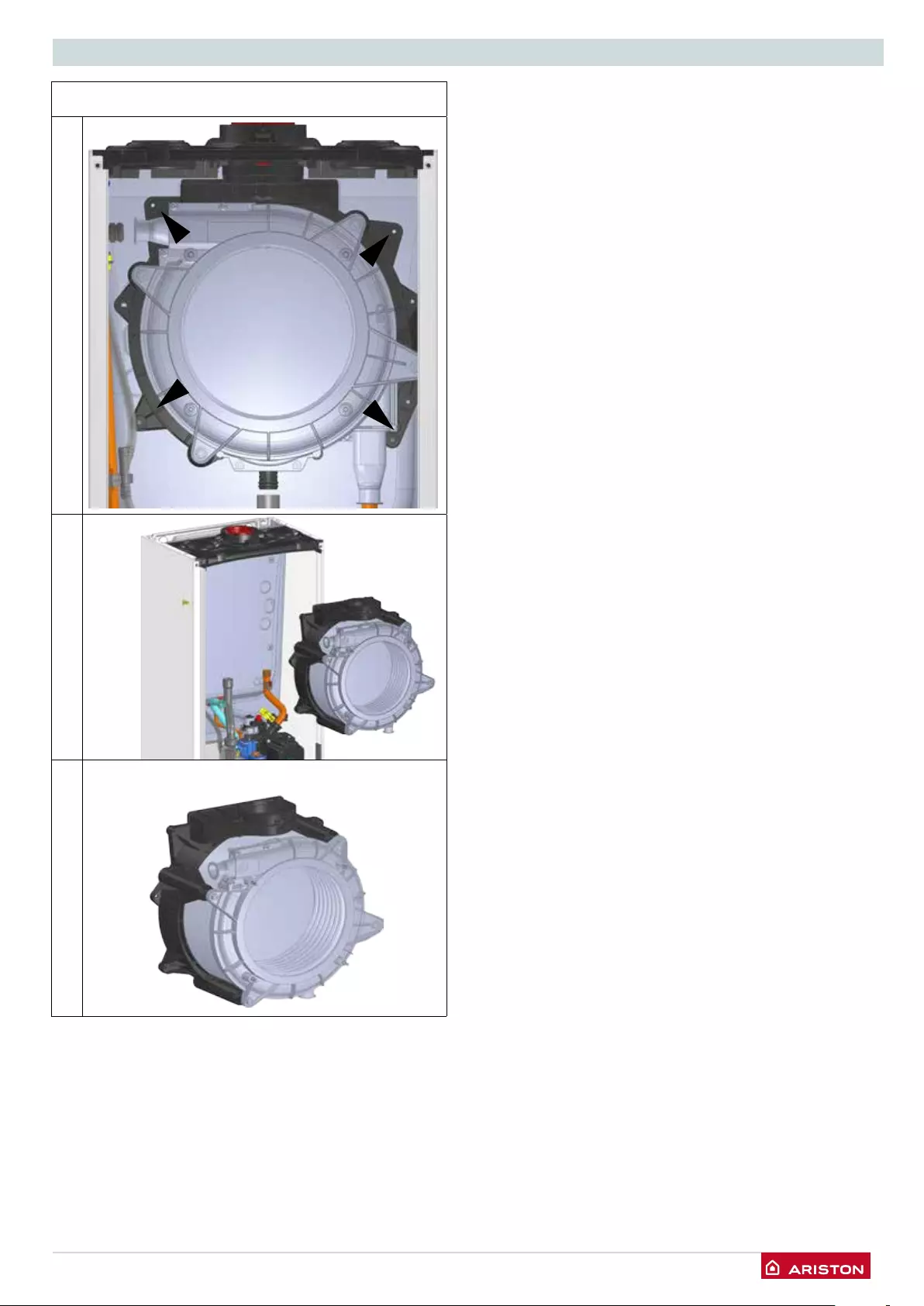
/ 61
MAINTENANCE GUIDE
Unscrew the four screws to remove the heat exchanger
9
10
11

62 /
MAINTENANCE GUIDE
4. BURNER UNIT
Legend:
1 - Ceramic bre
2 - Burner
3 - Silencer
4 - Mixing tube
5 - Fan
6 - Detection/Ignition electrode
1
2
3
4
6
5
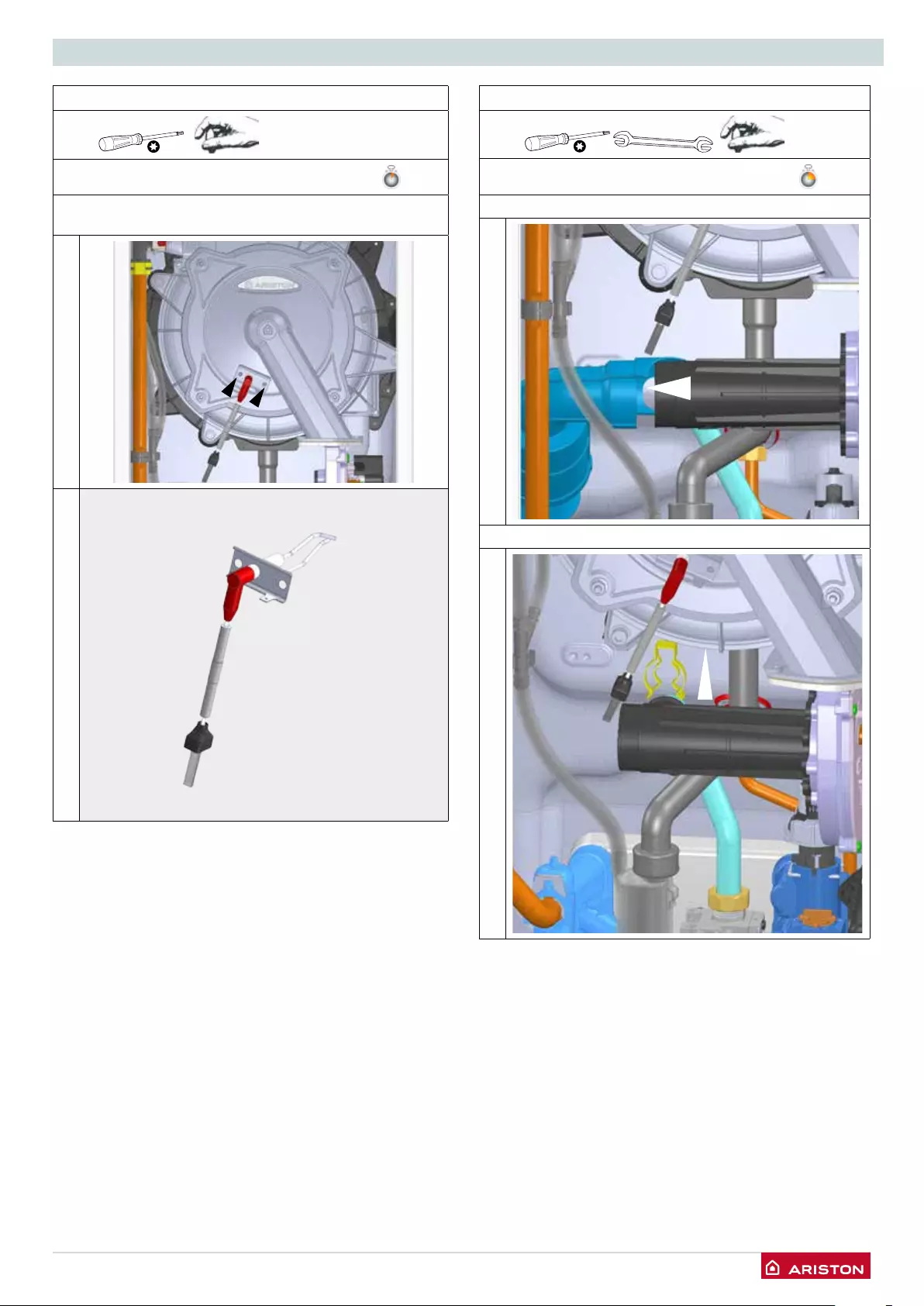
/ 63
MAINTENANCE GUIDE
4.1 Electrode (detection and ignition)
Tools
TIME 5 min
Unplug the electrode on the control box
Remove the screws and pull the electrodes towards you.
1
2
4.2 Burner
Tools
TIME 15 min
Remove the silencer
1
Isolate the gas supply. Disconnect the gas pipe.
2
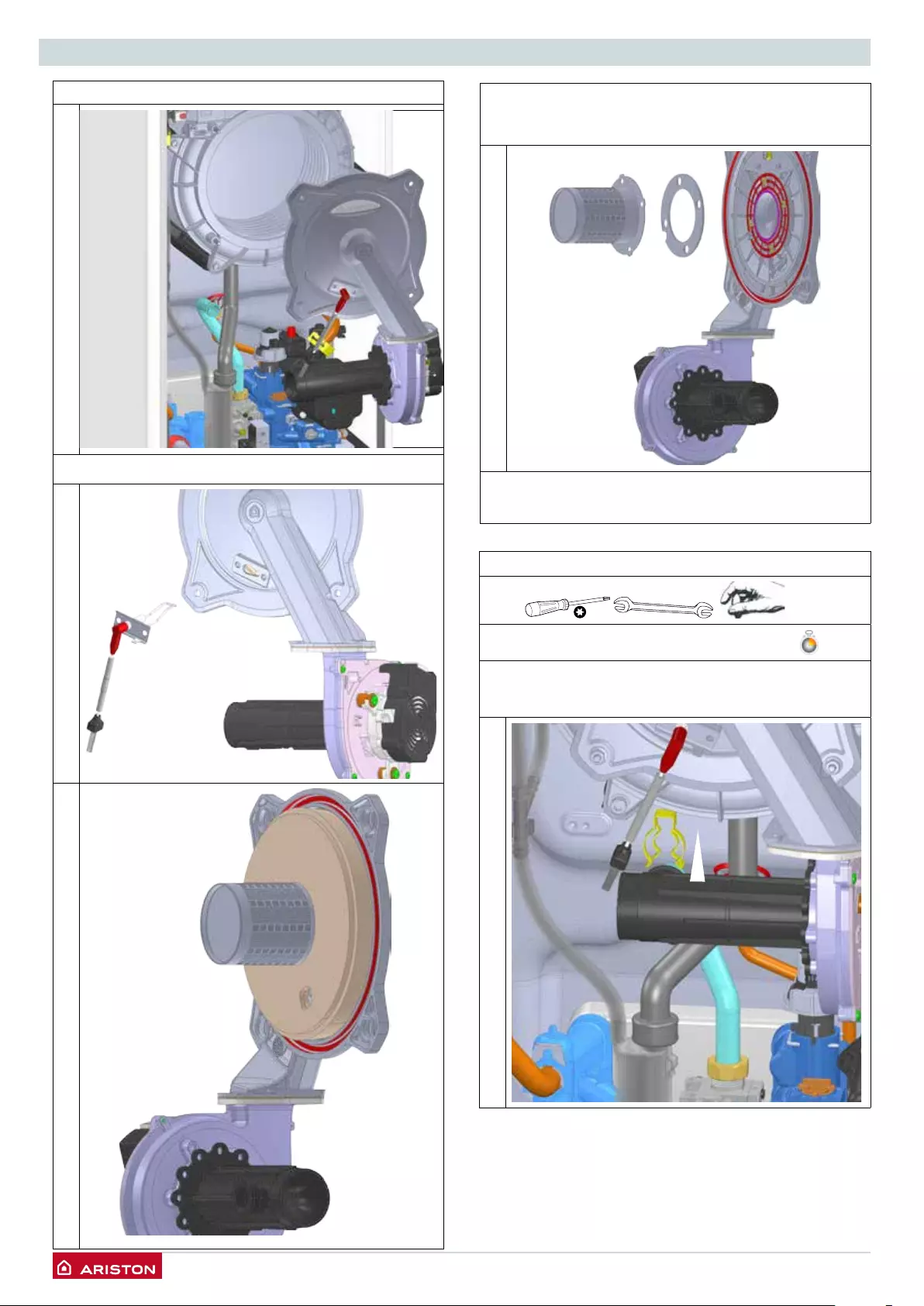
64 /
MAINTENANCE GUIDE
Pull the assembly towards you
3
Remove the two screws and remove the electrode
4
5
4.3 Fan
Tools
TIME 15 min
Remove the silencer (see 4.3 - 1)
Isolate the gas supply.
Disconnect the gas pipe (see 4.3 - 2)
1
Remove the ceramic bre.
Remove the four screws and pull the burner toward you.
Always replace the burner gasket (*).
6
Verify and replace the other gaskets if they are damaged
or showing signs of deterioration
(*)
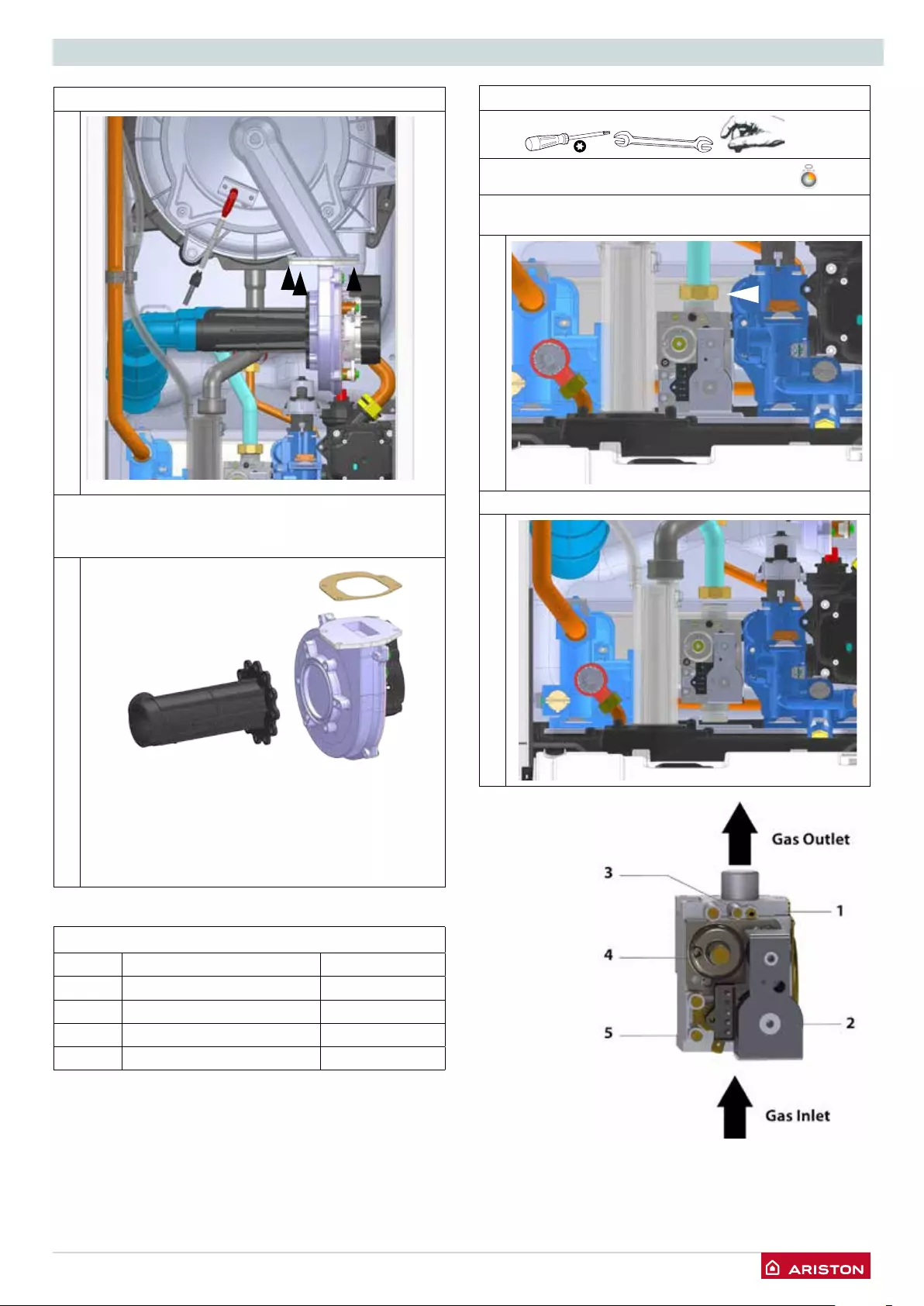
/ 65
MAINTENANCE GUIDE
Remove the three screws to free the fan.
2
Remove the three nuts.
Verify and replace the gasket if it’s damaged or showing
signs of deterioration
3
Legend:
1 - Fan
2 - Venturi
3 - Gasket
Fan & mixer venturi according to the model
Power Fan Venturi diameter
18 kW EBM 118 85W Ø 16,1
24 kW EBM 118 85W Ø 16,1
30 kW EBM 118 85W Ø 18,7
38 kW EBM 118 85W Ø 21,6
1
2
3
4.4 Gas Valve
Tools
TIME 15 min
Remove the two screws under the boiler and disconnect the
gas pipe on the top of the gas valve
1
Remove the gas valve
2
Legend:
1 - Gas valve
2 - Solenoids
3 - Throttle adjustment
4 - Offset adjustment
5 - Inlet test nipple
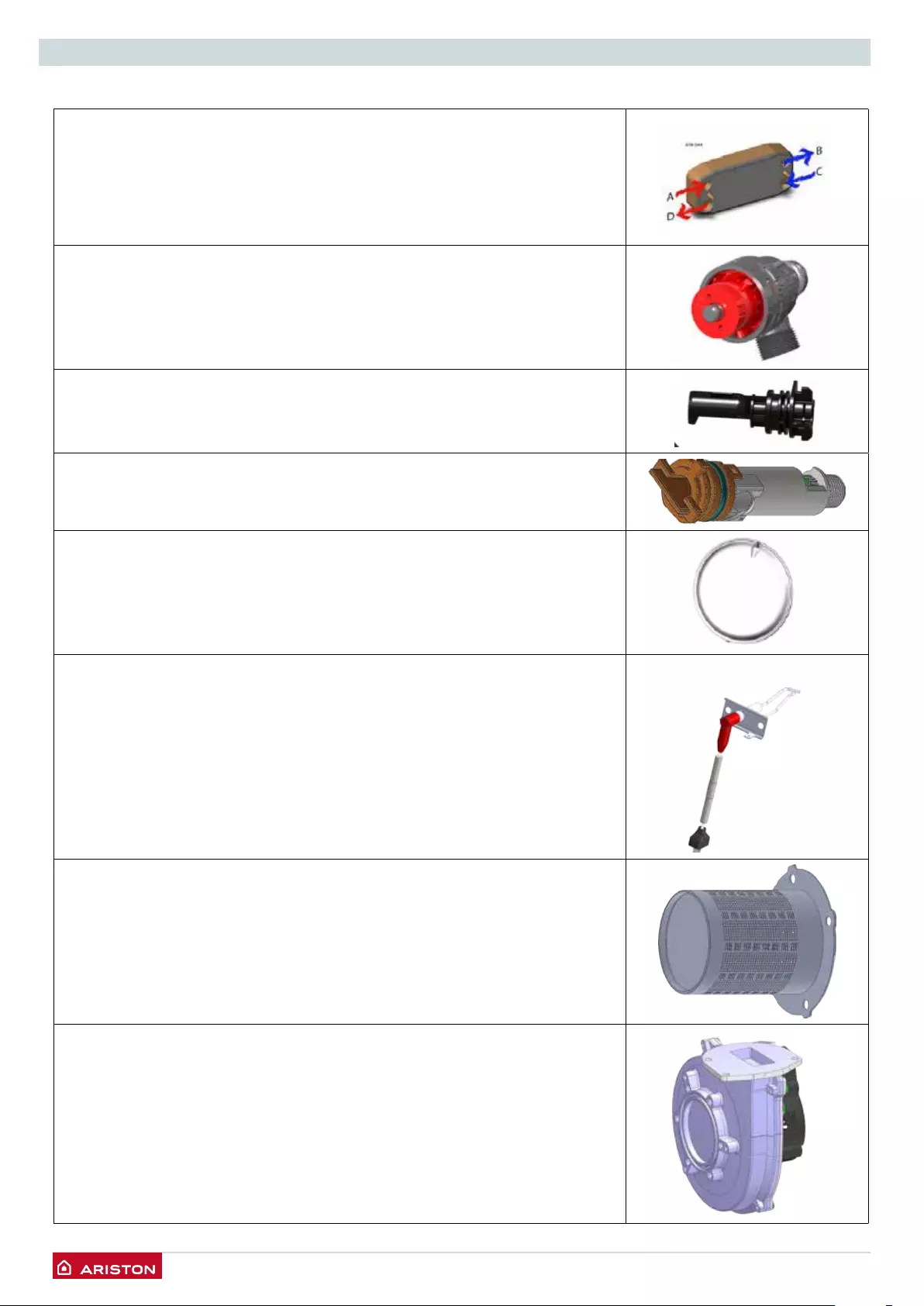
66 /
MAINTENANCE GUIDE
5. ANNUAL MAINTENANCE
Plate heat exchanger
Maintenance Interval: As necessary
How: To measure specication of DHW performance.
By-pass & Safety valve
Maintenance Interval: Annually
How: Visual inspection / Clean as necessary
Central heating lter
Maintenance Interval: Annually
How: Visual inspection / Clean as necessary
Flow switch operation
Maintenance Interval: Annually
How: Visual inspection / Clean as necessary / Check ow rate
Expansion vessel
Maintenance Interval: Annually
How: Check air pressure is at 15 psi (System drained)
Ignition & detection electrode
Maintenance Interval: Annually
How: Visual inspection / Clean as necessary / Distance from the burner / Ionisation current
more than 1 μA
Burner
Maintenance Interval: Annually
How: Visual inspection / Clean as necessary
Fan
Maintenance Interval: Annually
How : Visual inspection / Clean as necessary

/ 67
MAINTENANCE GUIDE
Primary Heat exchanger
Maintenance Interval: Annually
How : Visual inspection / Clean as necessary
Condensate trap
Maintenance Interval: Annually
or after cleaning primary heat exchanger
How : Visual inspection / Clean as necessary /
Add water before replacing
Pump
Maintenance Interval: At the rst ignition and annually
How: Check that the AAV is open /
Visual inspection / Clean as necessary

68 /
TECHNICAL DATA
GENERAL
NOTE
Model:
CLAS ONE
CLAS NET ONE
24
30
38
CE Certication (pin)
0085CR0393
Boiler type
C13(X)-C23-C33(X)-C43(X)-C53(X)-
C63(X)C83(X)-C93(X) B23-B23P-B33
POWER SPECIFICATIONS
Max/min nominal caloric ow rate (Hi) Qn kW
22,0 / 3,7 28,0 / 4,3 31,0 / 5,5
Max/min nominal caloric ow rate (Hs) Qn kW
24,4 / 4,1 31,1 / 4,8 34,4 / 6,1
Domestic hot water max/min nominal caloric ow rate (Hi) Qn kW
26,0 / 3,7 30,0 / 4,3 38,0 / 5,5
Domestic hot water max/min nominal caloric ow rate (Hs) Qn kW
28,9 / 4,1 33,3 / 4,8 42,2 / 6,1
Max/min power output (80°C-60°C) Pn kW
21,4 / 3,4 27,4 / 3,9 30,2 / 5,2
Max/min power output (50°C-30°C) Pn kW
23,6 / 3,9 30 / 4,5 33,5 / 5,8
Domestic hot water max/min power output Pn kW
24,9 / 3,5 28,7 / 4,1 36,3 / 5,3
Combustion efciency (of ue gas) %
98,0 98,0 97,9
Nominal caloric ow rate efciency (60/80°C) (Hi) %
97,5 / 87,8 97,9 / 88,2 97,5 / 87,8
Nominal caloric ow rate efciency (30/50°C) (Hi) %
107,3 / 96,7 107,3 / 96,6 108,2 / 97,4
Efciency at 30% at 30°C %
109,8 / 98,9 109,6 / 98,7 109,7 / 98,8
Minimum caloric ow rate efciency (60/80°C) (Hi) %
93,1 / 83,8 91,1 / 82 94,4 / 85,0
Efciency rating (dir. 92/42/EEC) stars
★★★★
Sedbuk class A/90 A/90 A/90
Loss of burner gas when operating %
2,0 2,0 2,1
EMISSIONS
Available air pressure Pa 100 100 100
NoX class
class 5
Flue gas temperature (G20) (80°C-60°C)
°C
61 62 63
CO2 content (G20) (80°C-60°C) max / min
%
9,2 / 8,9
CO content (0%O2) (80°C-60°C)
ppm 141,8
123,8
106
O2 content (G20) (80°C-60°C)
%
3,9 4,2 4,3
Maximum ue gas ow (G20) (80°C-60°C)
Kg/h
42,1 48,6 61,3
Excess air (80°C-60°C)
%
23 25 26
HEATING CIRCUIT
Expansion chamber ination pressure
bar
1
Maximum heating pressure
bar
3
Expansion chamber capacity
l
8
Min/max heating temperature (high temperature range)
°C
35 / 82
Min/max heating temperature (low temperature range)
°C
20 / 45
DOMESTIC HOT WATER
CIRCUIT
Domestic hot water min/max temperature
°C
36 / 60
Specic ow rate of domestic hot water (ΔT=30°C)
l/min
12,1 14,5 18,1
Quantity of hot water ΔT=25°C
l/min
14,5 17,4 21,8
Quantity of hot water ΔT=35°C
l/min
10,4 12,5 15,5
Hot water comfort rating (EN13203)
stars
★★★
Hot water minimum ow rate
l/min
2,0 2,0 2,0
Domestic hot water max/min pressure
bar
7 / 0,2
ELECTRICAL
Power supply frequency/voltage
V/Hz
230 / 50
Total electrical power absorbed
W
77 83 84
Minimum ambient temperature for use
°C
+5
Protection level for the electrical appliance
IP
X5D
Weight
kg
29,7 32,3 34,6

/ 69
TECHNICAL DATA
GENERAL
NOTE
Model:
CLAS SYSTEM ONE
18
24
30
CE Certication (pin)
0085CR0393
Boiler type
C13(X)-C23-C33(X)-C43(X)-C53(X)-
C63(X)C83(X)-C93(X) B23-B23P-B33
POWER SPECIFICATIONS
Max/min nominal caloric ow rate (Hi) Qn kW
18,0 / 3,7 22,0 / 3,7 28,0 / 4,3
Max/min nominal caloric ow rate (Hs) Qn kW
20,0 / 4,1 24,4 / 4,1 31,1 / 4,8
Domestic hot water max/min nominal caloric ow rate (Hi) Qn kW
18,0 / 3,7 26,0 / 3,7 30,0 / 4,3
Domestic hot water max/min nominal caloric ow rate (Hs) Qn kW
20,0 / 4,1 28,9 / 4,1 33,3 / 4,8
Max/min power output (80°C-60°C) Pn kW
17,6 / 3,4 21,4 / 3,4 27,4 / 3,9
Max/min power output (50°C-30°C) Pn kW
19,4 / 3,9 23,6 / 3,9 30 / 4,5
Domestic hot water max/min power output Pn kW 17,2 / 3,4
24,9 / 3,5 28,7 / 4,1
Combustion efciency (of ue gas) %
98,1 98,0 98,0
Nominal caloric ow rate efciency (60/80°C) (Hi) %
97,6 / 87,9 97,5 / 87,8 97,9 / 88,2
Nominal caloric ow rate efciency (30/50°C) (Hi) %
107,6 / 96,9 107,3 / 96,7 107,3 / 96,6
Efciency at 30% at 30°C %
109,4 / 98,5 109,8 / 98,9 109,6 / 98,7
Minimum caloric ow rate efciency (60/80°C) (Hi) %
93,1 / 83,8 93,1 / 83,8 91,1 / 82
Efciency rating (dir. 92/42/EEC) stars
★★★★
Sedbuk class A/90 A/90 A/90
Loss of burner gas when operating %
1,9 2,0 2,0
EMISSIONS
Available air pressure Pa 100 100 100
NoX class
class 5
Flue gas temperature (G20) (80°C-60°C)
°C 60
61
62
CO2 content (G20) (80°C-60°C) max - min
%
9,2 / 8,9
CO content (0%O2) (80°C-60°C)
ppm
109,4
141,8
123,8
O2 content (G20) (80°C-60°C)
%
4,0 3,9 4,2
Maximum ue gas ow (G20) (80°C-60°C)
Kg/h
28,8 42,1 48,6
Excess air (80°C-60°C)
%
23 23 25
HEATING CIRCUIT
Expansion chamber ination pressure
bar
1
Maximum heating pressure
bar
3
Expansion chamber capacity
l
8
Min/max heating temperature (high temperature range)
°C
35 / 82
Min/max heating temperature (low temperature range)
°C
20 / 45
DOMESTIC HOT WATER
CIRCUIT
Domestic hot water min/max temperature
°C
40 / 60
ELECTRICAL
Power supply frequency/voltage
V/Hz
230 / 50
Total electrical power absorbed
W
60 77 83
Minimum ambient temperature for use
°C
+5
Protection level for the electrical appliance
IP
X5D
Weight
kg
29,7 29,7 32,3
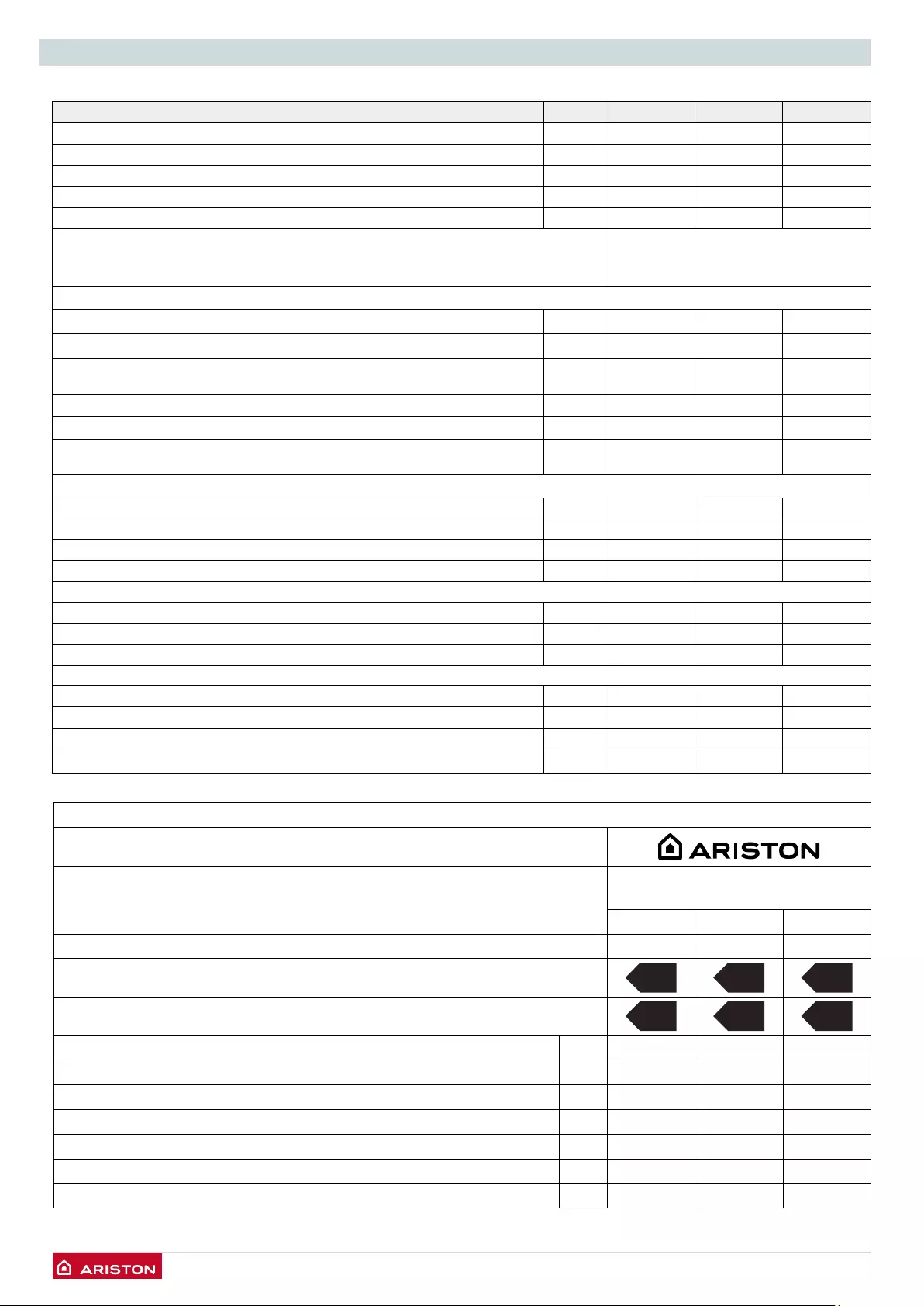
70 /
TECHNICAL DATA
ErP Data - EU 813/2013
Model: CLAS ONE / CLAS NET ONE 24 30 38
Condensing boiler yes/no yes yes yes
Low-temperature boiler: yes/no no no no
B1 boiler yes/no no no no
Cogeneration space heater yes/no no no no
Combination heater yes/no yes yes yes
Contact details
( Name and address of the manufacturer or its authorised representative)
ARISTON THERMO S.p.A.
Viale A. Merloni 45 60044
FABRIANO AN - ITALIA
ErP HEATING
Power output P
n
kW 22 28 31
Useful heat output at rated heat output and high-temperature regime P
4
kW 22,0 28,0 31,0
Useful heat output at 30 % of rated heat output and low-temperature regime
(Return temperature 30°C) P
1
kW 6,6 8,4 9,3
Seasonal space heating energy efciency η
s
%94 94 94
Useful efciency at rated heat output and high-temperature regime (60-80°C)
η
4
%87,8 88,2 87,8
Useful efciency at 30 % of rated heat output and low-temperature regime
(Return temperature 30°C)
η
1
%97,2 98,7 98,8
ErP D.H.W.
Declared load prole XL XL XXL
Water heating energy efciency
η
wh
%83 82 85
Daily electricity consumption Q
elec
kWh 0,200 0,190 0,220
Daily fuel consumption Q
fuel
kWh 23,490 23,870 28,330
AUXILIARY ELECTRICITY CONSUMPTION
At full load elmax kW
0,030
0,039
0,035
At part load elmin kW 0,014 0,015 0,012
In standby mode P
SB
kW 0,004 0,004 0,004
OTHER ITEMS
Standby heat loss P
stby
kW
0,039
0,043
0,047
Ignition burner power consumption P
ign
kW 0,000 0,000 0,000
Sound power level, indoors L
WA
dB
49
51
52
Emissions of nitrogen oxides NOx mg/kWh 53 51 55
PRODUCT FICHE - EU 811/2013
Brand
Model CLAS ONE
CLAS NET ONE
24 30 38
Declared load prole XL XL XXL
Seasonal space heating energy efciency class A A A
Water heating energy efciency class A A A
Power output PnkW 22 28 31
Annual energy consumption QHE GJ 40 50 56
Annual electricity consumption AEC kWh 44 42 48
Annual fuel consumption AFC GJ 19 19 22
Seasonal space heating energy efciency
η
s% 94 94 94
Water heating energy efciency
η
WH % 83 82 85
Sound power level, indoors LWA dB 49 51 52

/ 71
TECHNICAL DATA
ErP Data - EU 813/2013
Model: CLAS SYSTEM ONE
18
24
30
Condensing boiler yes/no yes yes yes
Low-temperature boiler: yes/no no no no
B1 boiler yes/no no no no
Cogeneration space heater yes/no no no no
Combination heater yes/no no no no
Contact details
( Name and address of the manufacturer or its authorised representative)
ARISTON THERMO S.p.A.
Viale A. Merloni 45 60044
FABRIANO AN - ITALIA
ErP HEATING
Power output P
n
kW 18 22 28
Useful heat output at rated heat output and high-temperature regime P
4
kW 18,0 22,0 28,0
Useful heat output at 30 % of rated heat output and low-temperature regime
(Return temperature 30°C) P
1
kW 5,4 6,6 8,4
Seasonal space heating energy efciency
ηs
%93 94 94
Useful efciency at rated heat output and high-temperature regime (60-80°C) η
4
%87,9 87,8 88,2
Useful efciency at 30 % of rated heat output and low-temperature regime
(Return temperature 30°C)
η
1
%98,5 97,2 98,7
AUXILIARY ELECTRICITY CONSUMPTION
At full load elmax kW 0,024 0,030 0,039
At part load elmin kW 0,014 0,014 0,015
In standby mode P
SB
kW
0,004
0,004
0,004
OTHER ITEMS
Standby heat loss P
stby
kW 0,039 0,039 0,043
Ignition burner power consumption P
ign
kW 0,000 0,000 0,000
Sound power level, indoors L
WA
dB 51 49 51
Emissions of nitrogen oxides NOx mg/kWh 57 53 51
PRODUCT FICHE - EU 811/2013
Brand
Model CLAS SYSTEM ONE
18 24 30
Seasonal space heating energy efciency class A A A
Power output PnkW
18
22
27
Annual energy consumption QHE GJ 33 40 50
Seasonal space heating energy efciency
η
s%
93
94
94
Sound power level, indoors LWA dB 51 49 51
Brand CLAS NET ONE
24 30 35
Seasonal space heating energy efciency
η
s
%94+3 =97 94+3 =97 94+3 =97
PRODUCT FICHE - CUBE S NET - WiFi Thermostat (CLAS NET ONE)
Brand
Supplier identication model CUBE S NET
Temperature control class V
Energy efciency contribution for space heating %
3%
Important!!
The installation of the boiler and all the included thermoregulation accessories determines a nal value of Seasonal space
heating energy eciency (
η
s) as shown in the table below for the various models.

72 /
TECHNICAL DATA
Package che
I I I
+
+
A
+
+
A+++
A++
A+
A
B
C
D
E
F
G
A+
2015 811/2013
I I I
A+
A++
A
A
A+++
A++
A+
A
B
C
D
E
F
G
A+++
A++
A+
A
B
C
D
E
F
G
+
+
+
+XL
2015 811/2013
XL
Instructions for lling the label for packages of space heater
(or combination heater), temperature control and solar
device.
1. supplier’s name or trademark;
2. supplier’s model identier;
3. the seasonal space heating energy efciency class of the
space heater, already lled;
4. the seasonal space heating and water heating energy
efciency classes of the combination heater already lled;
5. Indication of whether a solar collector, hot water storage
tank, temperature control and/or supplementary heater,
may be included in the package of combination heater,
temperature control and solar device;
6. the seasonal space heating energy efciency class of the
package of combination heater, temperature control and
solar device, determined in accordance with the gure 1 in
the following pages.
The head of the arrow containing the seasonal space
heating energy efciency class of the package of
combination heater, temperature control and solar device
shall be placed at the same height as the head of the
relevant energy efciency class;
7. the water heating energy efciency class of the package of
combination heater, temperature control and solar device,
determined in accordance with the gure 5 in the following
pages.
The head of the arrow containing the water heating energy
efciency class of the package of combination heater,
temperature control and solar device shall be placed at the
same height as the head of the relevant energy efciency
class.
1
1
2
2
3 6
5
3
4
5
6
7
The energy efciency of the package of products provided for
this che may not correspond to its actual energy efciency
once installed in a building, as the efciency is inuenced by
further factors such as heat loss in the distribution system and
the dimensioning of the products in relation to building size and
characteristics.
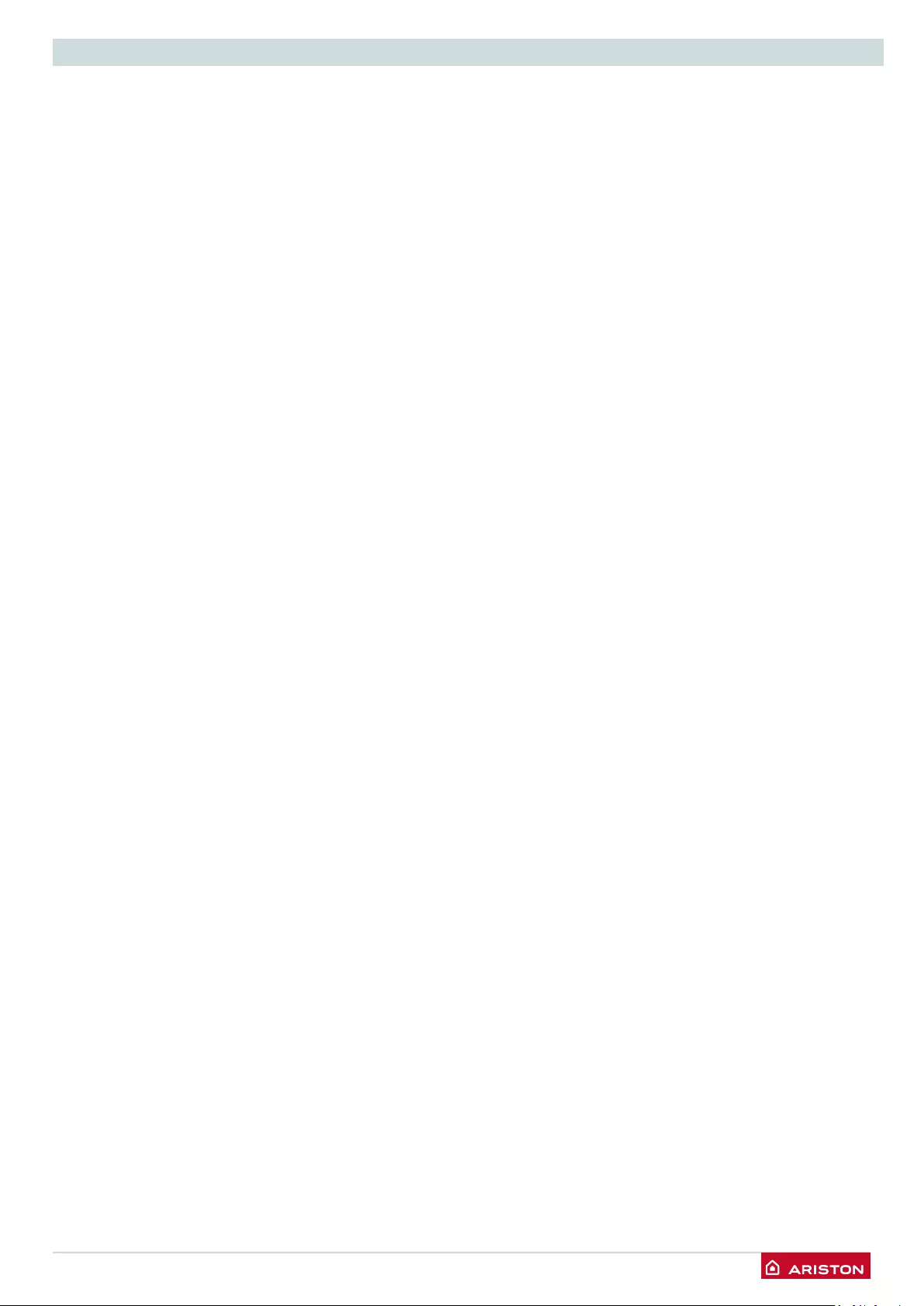
/ 73
TECHNICAL DATA
PACKAGES OF COMBINATION HEATER, TEMPERATURE
CONTROL AND SOLAR DEVICE
The che for packages of combination heater, temperature
control and solar device shall contain the elements set out in
points (a) and (b):
a) the elements set out in Figure 1, respectively, for evaluating
the seasonal space heating energy efciency of a package
of combination heater, temperature control and solar device,
including the following information:
- I: the value of the seasonal space heating energy efciency
of the preferential combination heater, expressed in %;
- II: the factor for weighting the heat output of the
preferential and supplementary heaters of a package
(see COMMISSION DELEGATED REGULATION (EU) No
811/2013 - annex IV - 6.a);
- III: the value of the mathematical expression: 294/(11 ·
Prated), whereby Prated is related to the preferential
combination heater;
- IV: the value of the mathematical expression 115/(11 ·
Prated), whereby Prated is related to the preferential
combination heater;
in addition, for preferential heat pump combination heaters:
- V: the value of the difference between the seasonal space
heating energy efciencies under average and colder
climate conditions, expressed in %;
- VI: the value of the difference between the seasonal space
heating energy efciencies under warmer and average
climate conditions, expressed in %;
(b) the elements set out in Figure 5 for evaluating the water
heating energy efciency of a package of combination heater,
temperature control and solar device, where the following
information shall be included:
- I: the value of the water heating energy efciency of the
combination heater, expressed in %;
- II: the value of the mathematical expression (220 · Q ref )/Q
nonsol , where Q ref is taken from Table 15 in Annex VII
of the COMMISSION DELEGATED REGULATION (EU) N.
811/2013 and Q nonsol from the product che of the solar
device for the declared load prole M, L, XL or XXL of the
combination heater;
- III: the value of the mathematical expression (Qaux · 2,5)/
(220 · Qref), expressed in %, where Q aux is taken from
the product che of the solar device and Q ref from
Table 15 in Annex VII of the COMMISSION DELEGATED
REGULATION (EU) N. 811/2013 for the declared load
prole M, L, XL or XXL.

74 /
TECHNICAL DATA
Seasonal space heating energy eciency of boiler
Temperature control
From che of temperature control
Supplementary boiler
From che of boiler
( - ‘I’ ) x 0,1 =
Seasonal space heating energy eciency (in %)
Class
I = 1%, II = 2%, III = 1,5%, IV = 2%,
V = 3%, VI = 4 %, VII = 3,5%, VIII = 5%
‘I’ %
1
%
2
+
%
3
Seasonal space heating energy eciency (in %)
Solar contribution - From che of solar device
Solar contribution and supplementary heat pump
Seasonal space heating energy ecinency of package
Seasonal space heating energy ecinency class of package
Boiler and supplementary heat pump installed with low temperature heat emitters at 35 °C?
From che of heat pump
Supplementary heat pump
From che of heat pump
Select smaller value
( ‘III’ x + ‘IV’ x ) x 0,9 x ( /100 ) x =
( - ‘I’ ) x ‘II’ =
Collector size ( in m2) Tank volume ( in m3)
Collector eciency ( in %)
Tank rating
A* = 0,95, A = 0,91,
B = 0,86, C = 0,83, D-G = 0,81
%
4
4
+
%
5
5
+
%
6
%
%
7
0,5 x OR 0,5 x =
7
+ (50 x ‘II’) =
G F E D C B A A+A++ A+++
< 30% ≥ 30 % ≥ 34 % ≥ 36 % ≥ 75 % ≥ 82 % ≥ 90 % ≥ 98 % ≥ 125 % ≥ 150%
Figure 1
The energy efciency of the package of products provided for
this che may not correspond to its actual energy efciency
once installed in a building, as the efciency is inuenced by
further factors such as heat loss in the distribution system and
the dimensioning of the products in relation to building size and
characteristics.

/ 75
TECHNICAL DATA
Figure 5
Water heating energy eciency of combination heater
Water heating energy eciency class of package under average climate
(1,1 x ‘I’ - 10%) x ‘II’ - - ‘I’ =
Auxiliary electricity
Solar contribution - From che of solar device
Declared load prole: ‘I’ %
1
+
%
3
%
2
‘III’
< 27 % ≥ 27 %
< 27 % ≥ 27 %
≥ 30 %
≥ 30 % ≥ 34 % ≥ 37 % ≥ 50 % ≥ 75 % ≥ 115 % ≥ 150 % ≥ 188 %
< 27 % ≥ 27 % ≥ 30 % ≥ 35 % ≥ 38 % ≥ 55 % ≥ 80 % ≥ 125 % ≥ 160 % ≥ 200 %
< 28 % ≥ 28 % ≥ 32 % ≥ 36 % ≥ 40 % ≥ 60 % ≥ 85 % ≥ 131 % ≥ 170 % ≥ 213 %
≥ 33 % ≥ 36 % ≥ 39 % ≥ 65 % ≥ 100 % ≥ 130 % ≥ 163 %
G
M
L
XL
XXL
F E D C B A A+A++ A+++
Water heating energy eciency under colder and warmer climate conditions
- 0,2 x
+ 0,4 x
=
=
Colder:
Warmer:
3
3
2
2
%
%
Water heating energy eciency of package under average climate
The energy efciency of the package of products provided for
this che may not correspond to its actual energy efciency
once installed in a building, as the efciency is inuenced by
further factors such as heat loss in the distribution system and
the dimensioning of the products in relation to building size and
characteristics.


*AllinstallationsinEnglandandWalesmustbenotiedtoLocalAuthorityBuildingControl(LABC)eitherdirectlyorthrougha
CompetentPersonsScheme.ABuildingRegulationsComplianceCerticatewillthenbeissuedtothecustomer.
www.centralheating.co.uk
©HeatingandHotwaterIndustryCouncil(HHIC)
This Commissioning Checklist is to be completed in full by the competent person who commissioned the boiler as a means of demonstrating
compliance with the appropriate Building Regulations and then handed to the customer to keep for future reference.
Failuretoinstallandcommissionaccordingtothemanufacturer’sinstructionsandcompletethisBenchmarkCommissioningChecklistwillinvalidatethe
warranty.Thisdoesnotaffectthecustomer’sstatutoryrights.
GAS BOILER SYSTEM COMMISSIONING CHECKLIST
Customername: Telephonenumber:
Address:
Boilermakeandmodel:
Boilerserialnumber:
Commissionedby(PRINTNAME): GasSaferegisternumber:
Companyname: Telephonenumber:
Companyaddress:
Commissioningdate:
To be completed by the customer on receipt of a Building Regulations Compliance Certicate*
BuildingRegulationsNoticationNumber(ifapplicable):
CONTROLS(ticktheappropriateboxes)
Timeandtemperaturecontroltoheating Roomthermostatandprogrammer/timer Programmableroomthermostat
Load/weathercompensation Optimum start control
Timeandtemperaturecontroltohotwater Cylinderthermostatandprogrammer/timer CombinationBoiler
Heatingzonevalves Fitted Notrequired
Hotwaterzonevalves Fitted Notrequired
Thermostaticradiatorvalves Fitted Notrequired
Automaticbypasstosystem Fitted Notrequired
Boilerinterlock Provided
ALL SYSTEMS
ThesystemhasbeenushedandcleanedinaccordancewithBS7593andboilermanufacturer’sinstructions Yes
Whatsystemcleanerwasused?
Whatinhibitorwasused? Quantitylitres
Hasaprimarywatersystemlterbeeninstalled? Yes No
CENTRAL HEATING MODE measureandrecord:
Gasrate m³/hr OR ft³/hr
Burneroperatingpressure(ifapplicable) mbar ORGasinletpressure mbar
Centralheatingowtemperature °C
Centralheatingreturntemperature °C
COMBINATION BOILERS ONLY
Istheinstallationinahardwaterarea(above200ppm)? Yes No
Ifyes,andifrequiredbythemanufacturer,hasawaterscalereducerbeentted? Yes No
Whattypeofscalereducerhasbeentted?
DOMESTIC HOT WATER MODEMeasureandRecord:
Gasrate m³/hr OR ft³/hr
Burneroperatingpressure(atmaximumrate) mbar ORGasinletpressureatmaximumrate mbar
Coldwaterinlettemperature °C
Hotwaterhasbeencheckedatalloutlets Yes Temperature °C
Waterowrate I/min
CONDENSING BOILERS ONLY
Thecondensatedrainhasbeeninstalledinaccordancewiththemanufacturer’sinstructionsand/orBS5546/BS6798 Yes
ALL INSTALLATIONS
Recordthefollowing: Atmax.rate:COppm AND CO/CO² Ratio
Atmin.rate:(wherepossible)COppm AND CO/CO² Ratio
TheheatingandhotwatersystemcomplieswiththeappropriateBuildingRegulations Yes
Theboilerandassociatedproductshavebeeninstalledandcommissionedinaccordancewiththemanufacturer’sinstructions Yes
Theoperationoftheboilerandsystemcontrolshavebeendemonstratedtoandunderstoodbythecustomer Yes
Themanufacturer’sliterature,includingBenchmarkChecklistandServiceRecord,hasbeenexplainedandleftwiththecustomer Yes
CommissioningEngineer’sSignature
Customer’sSignature
(Toconrmsatisfactorydemonstrationandreceiptofmanufacturer’sliterature)
www.centralheating.co.uk

*AllinstallationsinEnglandandWalesmustbenotiedtoLocalAuthorityBuildingControl(LABC)eitherdirectlyorthrougha
CompetentPersonsScheme.ABuildingRegulationsComplianceCerticatewillthenbeissuedtothecustomer.
©HeatingandHotwaterIndustryCouncil(HHIC) www.centralheating.co.uk
It is recommended that your heating system is serviced regularly and that the appropriate Service Interval Record is completed.
Service Provider
BeforecompletingtheappropriateServiceRecordbelow,pleaseensureyouhavecarriedouttheserviceasdescribedinthemanufacturer’sinstructions.
Alwaysusethemanufacturer’sspeciedsparepartwhenreplacingcontrols.
SERVICE RECORD
SERVICE 01 Date:
Engineername:
Companyname:
TelephoneNo:
GassaferegisterNo:
Record: Atmax.rate: COppm AND CO² %
Atmin.rate:(WherePossible) COppm AND CO² %
Comments:
Signature
SERVICE 02 Date:
Engineername:
Companyname:
TelephoneNo:
GassaferegisterNo:
Record: Atmax.rate: COppm AND CO² %
Atmin.rate:(WherePossible) COppm AND CO² %
Comments:
Signature
SERVICE 03 Date:
Engineername:
Companyname:
TelephoneNo:
GassaferegisterNo:
Record: Atmax.rate: COppm AND CO² %
Atmin.rate:(WherePossible) COppm AND CO² %
Comments:
Signature
SERVICE 04 Date:
Engineername:
Companyname:
TelephoneNo:
GassaferegisterNo:
Record: Atmax.rate: COppm AND CO² %
Atmin.rate:(WherePossible) COppm AND CO² %
Comments:
Signature
SERVICE 05 Date:
Engineername:
Companyname:
TelephoneNo:
GassaferegisterNo:
Record: Atmax.rate: COppm AND CO² %
Atmin.rate:(WherePossible) COppm AND CO² %
Comments:
Signature
SERVICE 06 Date:
Engineername:
Companyname:
TelephoneNo:
GassaferegisterNo:
Record: Atmax.rate: COppm AND CO² %
Atmin.rate:(WherePossible) COppm AND CO² %
Comments:
Signature
SERVICE 07 Date:
Engineername:
Companyname:
TelephoneNo:
GassaferegisterNo:
Record: Atmax.rate: COppm AND CO² %
Atmin.rate:(WherePossible) COppm AND CO² %
Comments:
Signature
SERVICE 08 Date:
Engineername:
Companyname:
TelephoneNo:
GassaferegisterNo:
Record: Atmax.rate: COppm AND CO² %
Atmin.rate:(WherePossible) COppm AND CO² %
Comments:
Signature
SERVICE 09 Date:
Engineername:
Companyname:
TelephoneNo:
GassaferegisterNo:
Record: Atmax.rate: COppm AND CO² %
Atmin.rate:(WherePossible) COppm AND CO² %
Comments:
Signature
SERVICE 10 Date:
Engineername:
Companyname:
TelephoneNo:
GassaferegisterNo:
Record: Atmax.rate: COppm AND CO² %
Atmin.rate:(WherePossible) COppm AND CO² %
Comments:
Signature
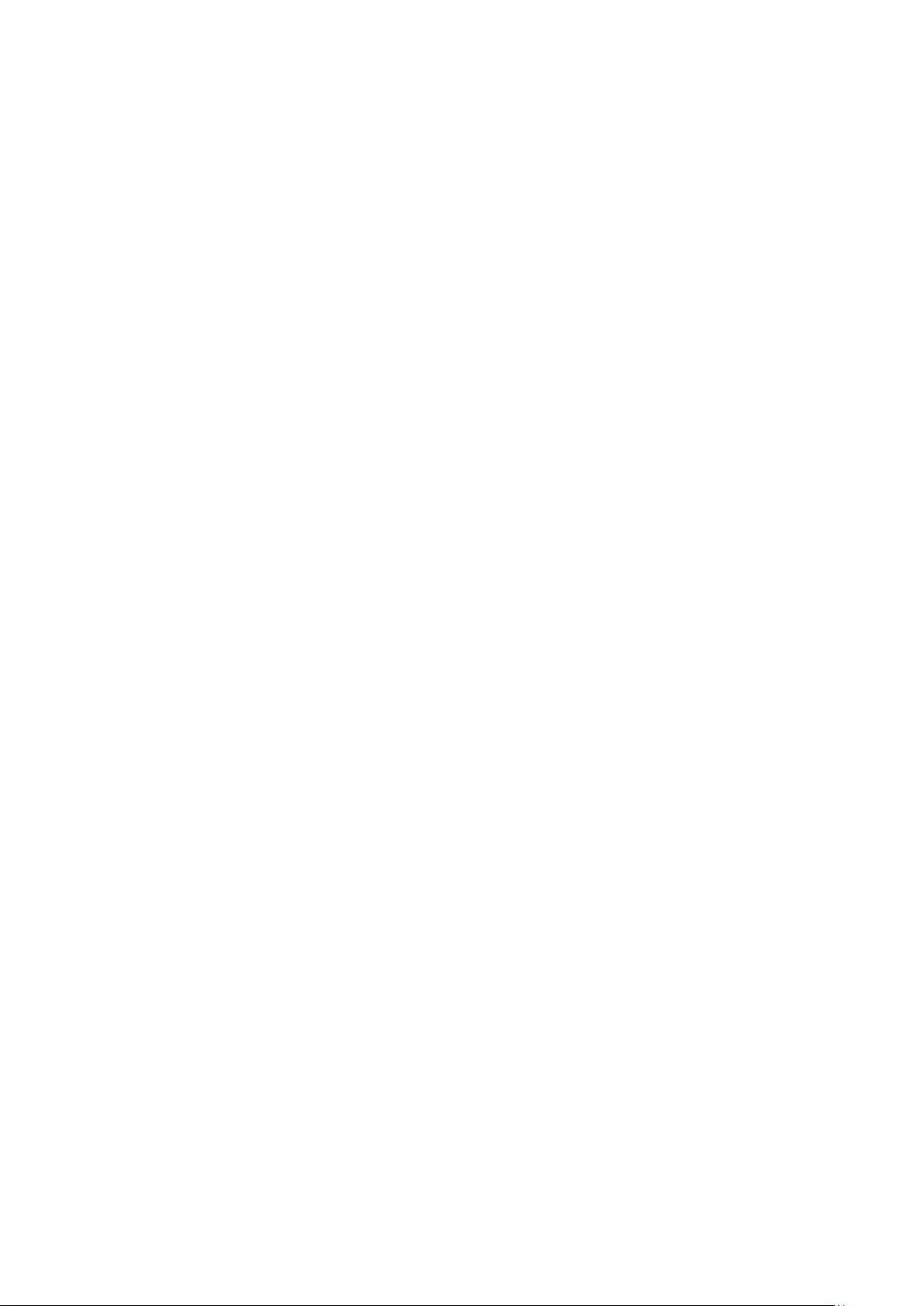
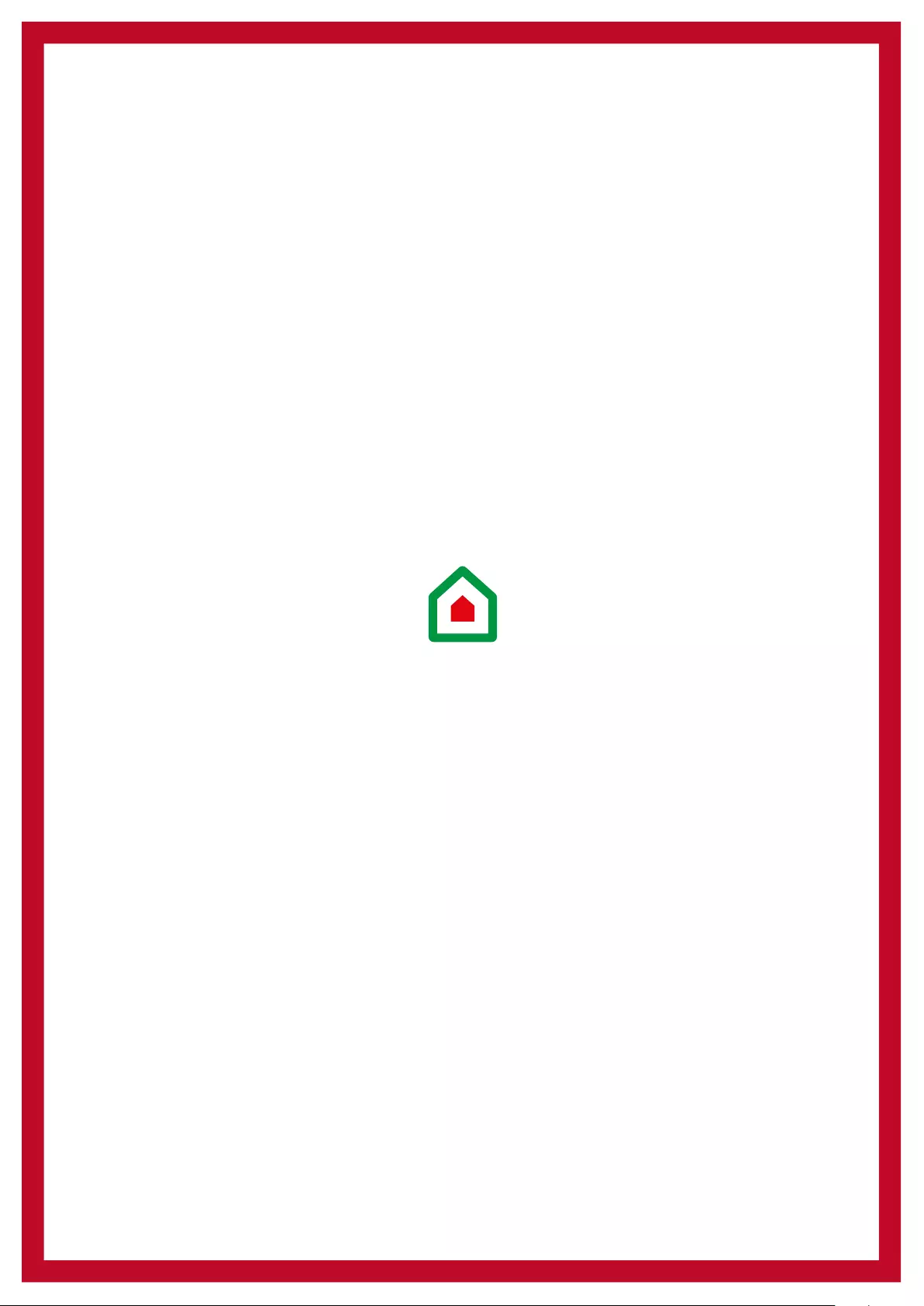
ITALIAN DESIGN
Ariston Thermo UK Ltd
Artisan Building
Hillbottom Road
High Wycombe
Bucks HP124HJ
Telephone: 01494 418500
Customer Service: 0333 240 8777
ariston.co.uk
420010818500